Author: Mark
L.A. Shorts Fest! “Some Other Cat” coming Sept. 9th!!
  At last it can be told! “Some Other Cat”, formerly “There Must Be Some Other Cat”, will be having it’s world premiere at the L.A. Shorts Festival on Sept. 9th, 2013! It will be shown in a program of animated shorts (Program 22) beginning at 3:15 PM at the Laemmle NOHO 7 theaters. They are located at 5240 Lankershim Blvd. in North Hollywood, 91618. Just go to www.lashortsfest.com for more information on parking and which off-ramp to take to get over there. Itza would love to have all his loyal readers there, this has been a very LONG time coming, Folks! If you can possibly get away on that Monday afternoon, you’ll be in the first west coast audience to see the short! If you feel your computer screen vibrating, that’s just Itza purring with delight.
 At last it can be told! “Some Other Cat”, formerly “There Must Be Some Other Cat”, will be having it’s world premiere at the L.A. Shorts Festival on Sept. 9th, 2013! It will be shown in a program of animated shorts (Program 22) beginning at 3:15 PM at the Laemmle NOHO 7 theaters. They are located at 5240 Lankershim Blvd. in North Hollywood, 91618. Just go to www.lashortsfest.com for more information on parking and which off-ramp to take to get over there. Itza would love to have all his loyal readers there, this has been a very LONG time coming, Folks! If you can possibly get away on that Monday afternoon, you’ll be in the first west coast audience to see the short! If you feel your computer screen vibrating, that’s just Itza purring with delight.
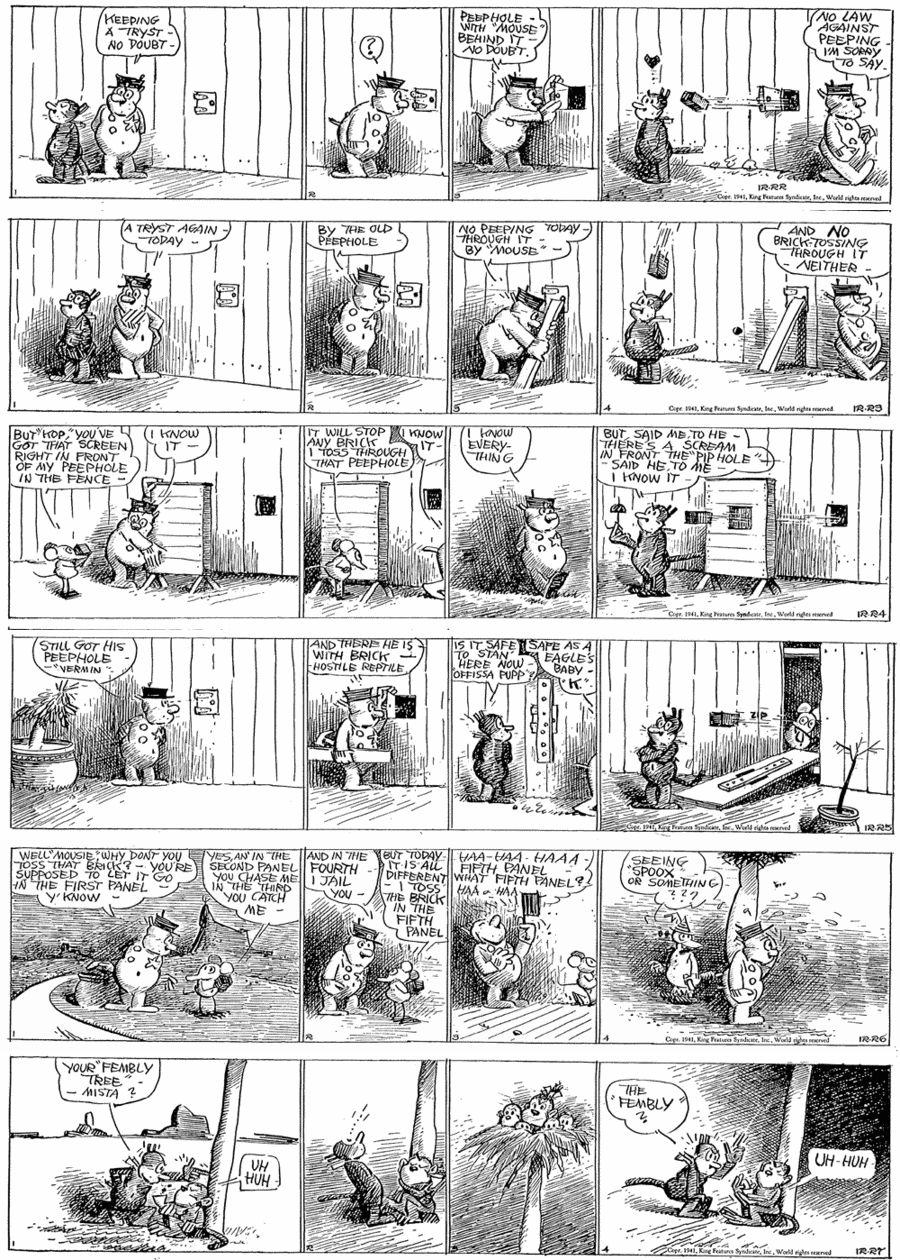 Â In Krazy, 12-22 to 12-27-1941, Garge does a four strip continuity about a brick shaped “peep hole” in the Coconino fence. I like the dead-pan expressions on both Krazy and Ignatz as Ig throws his brick through a collapsed fence board (12-25). Herriman does one of his rare insider strips in the 12-26, as Offissa Pupp and Ignatz discuss the order of the panels in a typical Krazy Kat daily, and in which panel the “Mice” will throw the brick. In this case it’s panel “5” which turns out to be off stage and Offissa Pupp is confined to Panel 4, so is once again powerless to stop the tryst.
 In Krazy, 12-22 to 12-27-1941, Garge does a four strip continuity about a brick shaped “peep hole” in the Coconino fence. I like the dead-pan expressions on both Krazy and Ignatz as Ig throws his brick through a collapsed fence board (12-25). Herriman does one of his rare insider strips in the 12-26, as Offissa Pupp and Ignatz discuss the order of the panels in a typical Krazy Kat daily, and in which panel the “Mice” will throw the brick. In this case it’s panel “5” which turns out to be off stage and Offissa Pupp is confined to Panel 4, so is once again powerless to stop the tryst.
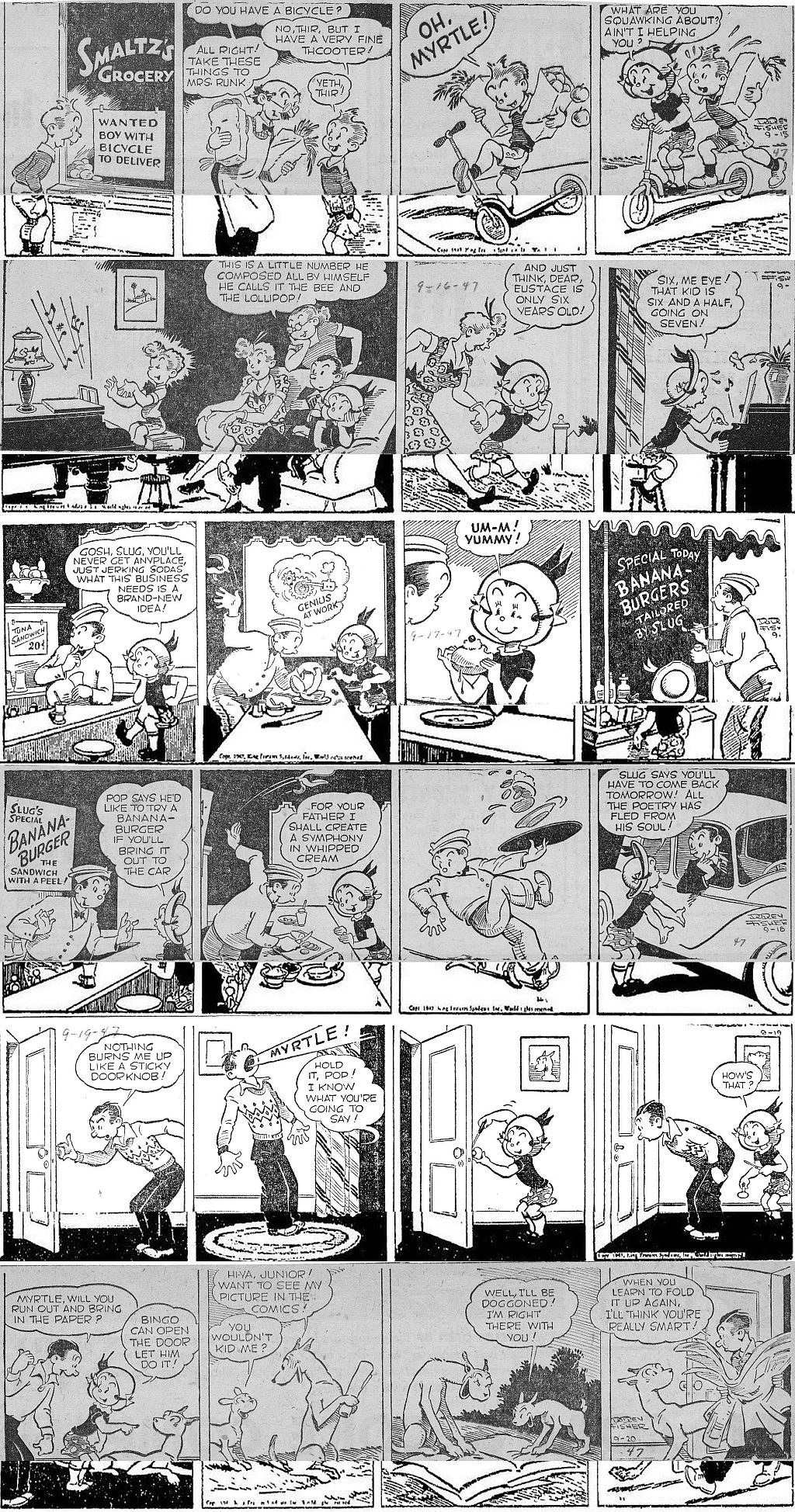  Myrtle is from 9-15 to 9-20-1947 this time, notice I’ve carefully matched the clipped strips to the Newspaper Archive copies to get Dudley Fisher’s complete drawings. The 9-15 continues the scooter gags from last week, and the 9-17 and 9-18 strips take place at Slug’s diner. Slug creates a new dish, the banana burger, the sandwich with a peel (Slug even slips on one). Slug was way ahead of his time, pioneering Vegan cuisine in 1947! The best strip in this batch is the 9-20, as Bingo goes out to fetch the paper and winds up reading the “Myrtle” strip with Junior.
 Myrtle is from 9-15 to 9-20-1947 this time, notice I’ve carefully matched the clipped strips to the Newspaper Archive copies to get Dudley Fisher’s complete drawings. The 9-15 continues the scooter gags from last week, and the 9-17 and 9-18 strips take place at Slug’s diner. Slug creates a new dish, the banana burger, the sandwich with a peel (Slug even slips on one). Slug was way ahead of his time, pioneering Vegan cuisine in 1947! The best strip in this batch is the 9-20, as Bingo goes out to fetch the paper and winds up reading the “Myrtle” strip with Junior.
  Felix is from 4-25 to 4-30-1949, as Felix and Moocher Mouse continue to chase the pearl thief as private detectives. My favorite panel is the second one in the 4-25, as the thief kicks Felix into the “camera”. Omar the Owl proves to be better at deductive reasoning than Felix and Moocher as he points out the thief’s shoe print on Felix’s back in the 4-26 strip. Moocher and Felix work together in the balance of the week’s strips to foil the thief, quite a contrast to the previous strips where they were doing their “Tom and Jerry” gags.
 Felix is from 4-25 to 4-30-1949, as Felix and Moocher Mouse continue to chase the pearl thief as private detectives. My favorite panel is the second one in the 4-25, as the thief kicks Felix into the “camera”. Omar the Owl proves to be better at deductive reasoning than Felix and Moocher as he points out the thief’s shoe print on Felix’s back in the 4-26 strip. Moocher and Felix work together in the balance of the week’s strips to foil the thief, quite a contrast to the previous strips where they were doing their “Tom and Jerry” gags.
See you at the Laemmle NOHO 7 very soon!
New Book Review!
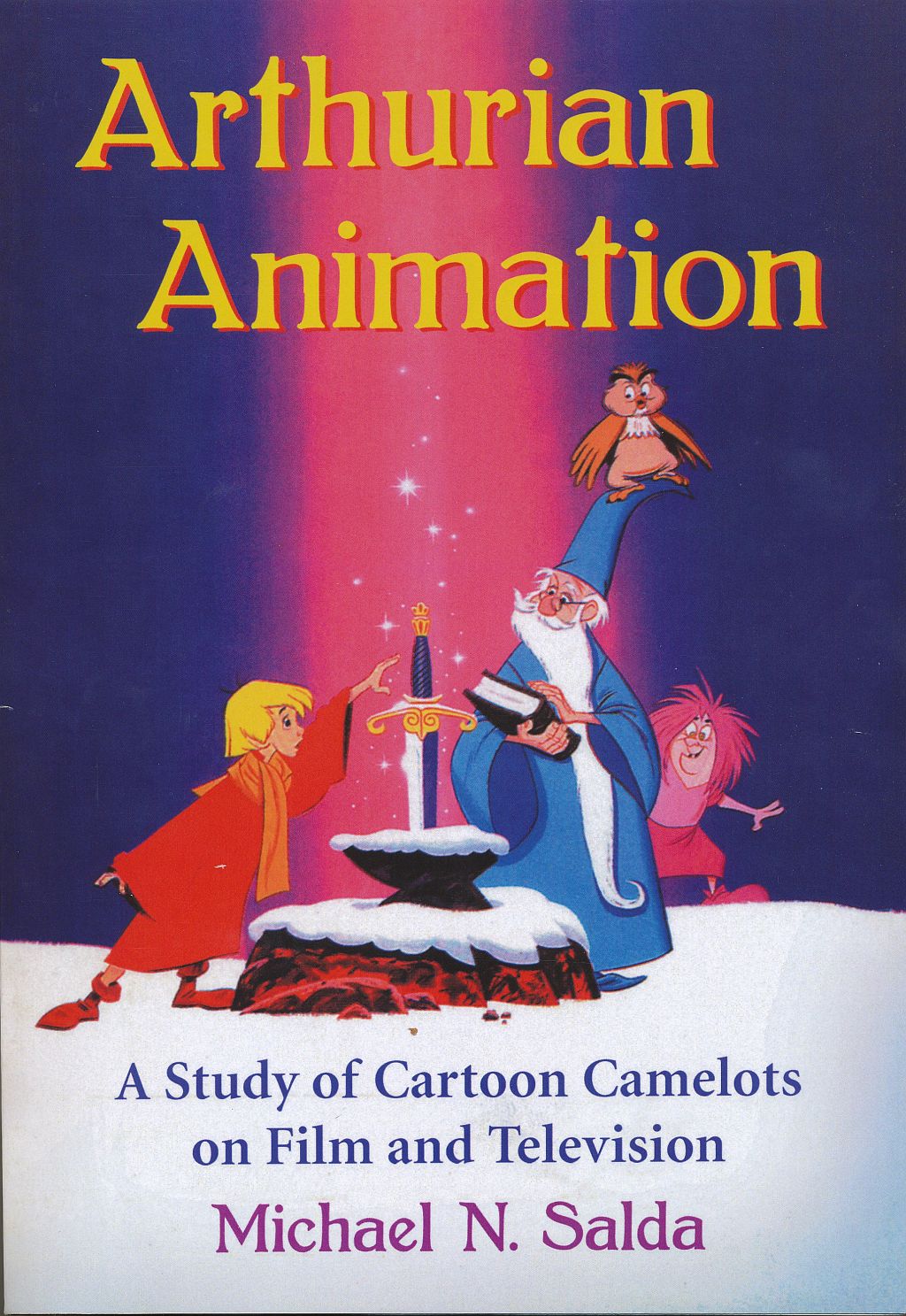 A new book by Michael N. Salda has just been published by McFarland and Company, ARTHURIAN ANIMATION. I received a review copy, courtesy of Michael, and I’m proud to say that the second chapter of this book was made possible by Hugh Harman’s archives, of which I am the custodian. Hugh’s script treatments for his proposed feature-length film, “King Arthur’s Knights” and the cost analysis for the project came in handy for Michael in writing his book on “Arthurianimation”, as he coins the term. This is an analysis and chronicle of all animated cartoons which derive from the Thomas Malory, Henry Gilbert and Mark Twain versions of the King Arthur legend. They range from the beginning of sound, (“Bosko’s Knight-Mare”) to 2002’s “Sir Gawain and the Green Knight”, an eduational film. I guess my favorite chapter is the first one, which gives Hugh Harman credit for being the first to animate a cartoon featuring the King Arthur legend. I haven’t read something this serious about Bosko in quite some time, and it won me over (I’m still a big Bosko fan). When you read the second chapter and see the summary of all the narrative sequences that were supposed to be in Hugh Harman’s “King Arthur’s Knights” feature length cartoon, you get a sense of why the project never found backers. The main reason was that there is so much emphasis on who did what to who where, that the “why” doesn’t surface. Without any dialog excerpts from the script treatment, we don’t gain much insight into the personalities that the lead characters Gareth, King Arthur, Lynette, Sir Modred, Merlin, Morganna and King Ban would have had. There are some of the original character sketches by Robert Stokes included, worth the price of the book, Stokes was really a master artist, and a prime animator of the Snow White character in the Disney film, among many other assignments. His drawing of Lynette looks quite a lot like the feature cartoon character Cinderella! The screenplay for the feature winds up with some World War Two era pro-British Union Jack waving, dating the story badly.                                                       The book is quite well-written, not very many mistakes. There are some odd omissions here and there, most notably, the story line of “The Land of the Lost” (Paramount 1948), is said to be derived from Isabel Hewson’s 1945 children’s book. Although the story of “The Knives of the Square Table” is in that book, the tale originated from an earlier radio script that Hewson wrote for the weekly series. In listing the Arthurianimation films of the 1950s, Michael leaves out “When Mousehood Was In Flower”, (Mighty Mouse, Rasinski, 1953) one of the funniest Knighthood cartoons ever made, much funnier that the Disney short, “A Knight For A Day”, to which Michael devotes two pages. In Chapter 4, Michael goes to a great deal of trouble to name a lot of animated projects both TV and Theatrical, which featured Merlin the Magician from the King Arthur stories. He doesn’t seem to know about Mervyn the Magician, from the Sugar Bear episodes of the “Linus the Lionhearted” TV cartoons. The short tempered Mervyn, voiced by Carl Reiner, certainly acted like a refugee from Arthurian legends, as he battled Granny Goodwitch with magic spells and potions. I really like the critical history Michael gives of Walt Disney’s The Sword in the Stone, in the first part of Chapter 5. A principal flaw in the feature’s story is that the animal transformations that Merlin puts Wart through, don’t really teach him very much, whereas in T.H. White’s book, they educate the budding Arthur thoroughly. Walt Disney evidently did not have very high regard for the way The Sword in the Stone turned out. Get the book and read Chapter 5! Full disclosure, the book has 10 chapters, 5 of which detail the King Arthur cartoons and so-called animated films of the 1970s through 2002. I have not fully read the last five chapters, since I don’t have a rooting interest in the stuff of that era, but can recommend the first half of the book for all the never before published Hugh Harman history in it. It’s wonderful to be acknowledged for the materials I made available to Michael, I was glad to help, I know Hugh would have wanted me to. You may order this book ($45.00), through the McFarland website, www.mcfarlandpub.com. Their order line is 800-253-2187. You can also order the book as an ebook ($16.75), through Google Play, Amazon Kindle, and many others.
A new book by Michael N. Salda has just been published by McFarland and Company, ARTHURIAN ANIMATION. I received a review copy, courtesy of Michael, and I’m proud to say that the second chapter of this book was made possible by Hugh Harman’s archives, of which I am the custodian. Hugh’s script treatments for his proposed feature-length film, “King Arthur’s Knights” and the cost analysis for the project came in handy for Michael in writing his book on “Arthurianimation”, as he coins the term. This is an analysis and chronicle of all animated cartoons which derive from the Thomas Malory, Henry Gilbert and Mark Twain versions of the King Arthur legend. They range from the beginning of sound, (“Bosko’s Knight-Mare”) to 2002’s “Sir Gawain and the Green Knight”, an eduational film. I guess my favorite chapter is the first one, which gives Hugh Harman credit for being the first to animate a cartoon featuring the King Arthur legend. I haven’t read something this serious about Bosko in quite some time, and it won me over (I’m still a big Bosko fan). When you read the second chapter and see the summary of all the narrative sequences that were supposed to be in Hugh Harman’s “King Arthur’s Knights” feature length cartoon, you get a sense of why the project never found backers. The main reason was that there is so much emphasis on who did what to who where, that the “why” doesn’t surface. Without any dialog excerpts from the script treatment, we don’t gain much insight into the personalities that the lead characters Gareth, King Arthur, Lynette, Sir Modred, Merlin, Morganna and King Ban would have had. There are some of the original character sketches by Robert Stokes included, worth the price of the book, Stokes was really a master artist, and a prime animator of the Snow White character in the Disney film, among many other assignments. His drawing of Lynette looks quite a lot like the feature cartoon character Cinderella! The screenplay for the feature winds up with some World War Two era pro-British Union Jack waving, dating the story badly.                                                       The book is quite well-written, not very many mistakes. There are some odd omissions here and there, most notably, the story line of “The Land of the Lost” (Paramount 1948), is said to be derived from Isabel Hewson’s 1945 children’s book. Although the story of “The Knives of the Square Table” is in that book, the tale originated from an earlier radio script that Hewson wrote for the weekly series. In listing the Arthurianimation films of the 1950s, Michael leaves out “When Mousehood Was In Flower”, (Mighty Mouse, Rasinski, 1953) one of the funniest Knighthood cartoons ever made, much funnier that the Disney short, “A Knight For A Day”, to which Michael devotes two pages. In Chapter 4, Michael goes to a great deal of trouble to name a lot of animated projects both TV and Theatrical, which featured Merlin the Magician from the King Arthur stories. He doesn’t seem to know about Mervyn the Magician, from the Sugar Bear episodes of the “Linus the Lionhearted” TV cartoons. The short tempered Mervyn, voiced by Carl Reiner, certainly acted like a refugee from Arthurian legends, as he battled Granny Goodwitch with magic spells and potions. I really like the critical history Michael gives of Walt Disney’s The Sword in the Stone, in the first part of Chapter 5. A principal flaw in the feature’s story is that the animal transformations that Merlin puts Wart through, don’t really teach him very much, whereas in T.H. White’s book, they educate the budding Arthur thoroughly. Walt Disney evidently did not have very high regard for the way The Sword in the Stone turned out. Get the book and read Chapter 5! Full disclosure, the book has 10 chapters, 5 of which detail the King Arthur cartoons and so-called animated films of the 1970s through 2002. I have not fully read the last five chapters, since I don’t have a rooting interest in the stuff of that era, but can recommend the first half of the book for all the never before published Hugh Harman history in it. It’s wonderful to be acknowledged for the materials I made available to Michael, I was glad to help, I know Hugh would have wanted me to. You may order this book ($45.00), through the McFarland website, www.mcfarlandpub.com. Their order line is 800-253-2187. You can also order the book as an ebook ($16.75), through Google Play, Amazon Kindle, and many others.
Snoggons and Sampson battle it out for Myrtle’s affection in the strips from 9-8 to 9-13-1947. I like how economical on gas Snoggons’s motorized scooter was, and how Sampson’s foot powered scooter ultimately won out when Snoggons’s engine broke down in the 9-13. We are now back to scanned newsprint clippings. Most of these are severely cropped by the newspaper they came out of, so I’ve integrated the full versions from the Newspaper Archive website. They don’t always line up exactly right, but at least you get the full Dudley Fisher images.
Krazy is from 12-15 to 12-20-1941. Herriman devoted the entire week to Frog and Toadstool gags. I love the way Garge drew frogs, the one in the last panel of the 12-20, carrying a toadstool as an umbrella, reminds me of Harrison Cady and Walt Kuhn, among many charming animal cartoonists. Krazy pulls a faint in the 12-17 when she sees that Ignatz is sitting on the “fungus butch” where the toad ought to be.
Felix is from 4-18 to 4-23-1949 and continues Felix and Moocher Mouse’s adventures as detectives. I love Felix’s reasoning powers as he letters a sign upside down, so that the nosy pearl thief will read it by standing on his hands, causing all his stolen swag to drop out of his pockets. That’s a great Messmer Felix “zip” drawing in the 4-21. We’ve still got several more weeks of these ’49 Felix strips coming up, keep us on your RSS feed!
Your Comics Page 7-27-2013
 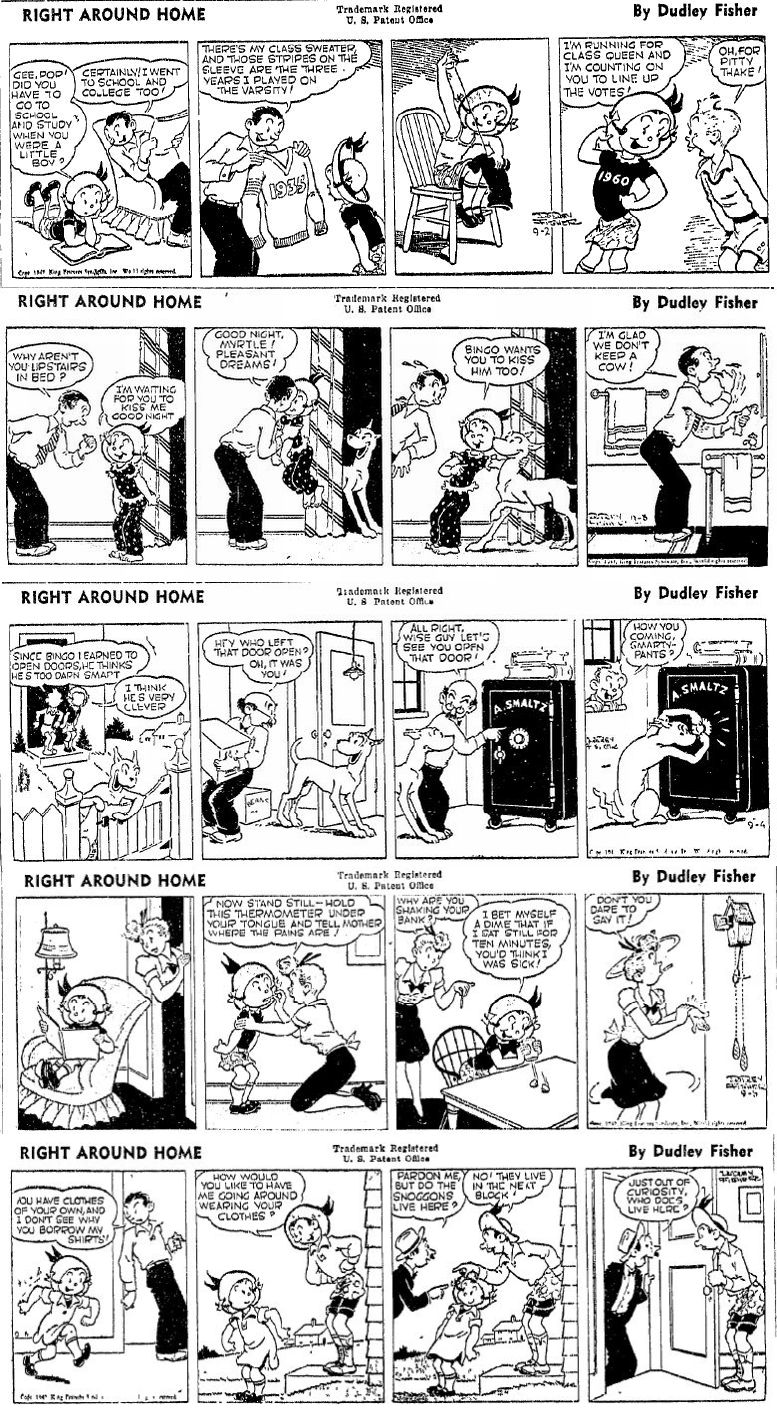 Well, here’s Myrtle from 9-2 to 9-6-1947. 9-1 is missing and didn’t turn up in the Newspaper Archive files. Bingo’s door opening skills are really put to the test in the 9-4, and Myrtle and her Dad switch clothes in the 9-6. Next time, we re-join the clipped run of the strip, hopefully there won’t be any missing ones.
Well, here’s Myrtle from 9-2 to 9-6-1947. 9-1 is missing and didn’t turn up in the Newspaper Archive files. Bingo’s door opening skills are really put to the test in the 9-4, and Myrtle and her Dad switch clothes in the 9-6. Next time, we re-join the clipped run of the strip, hopefully there won’t be any missing ones. 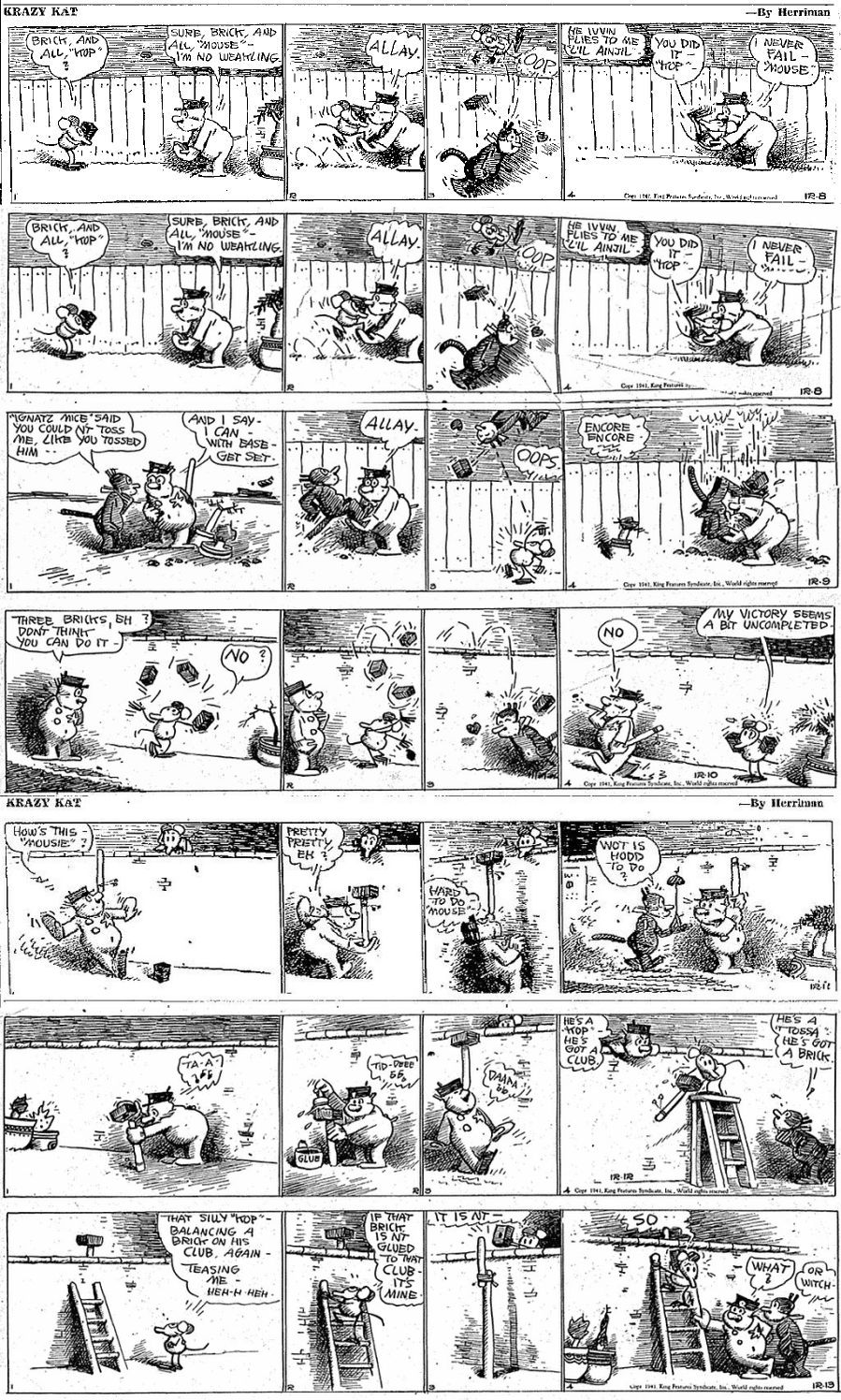 Krazy Kat this time is from 12-8 to 12-13-41. Continuity this week mainly features Offissa Pupp’s ability to balance Ignatz’s brick on the end of his club. You’ll notice that I doubled up on the 12-8, since the KFS copy was creased, making the third panel rather hard to read. I also inserted the 12-11 from Newspaper Archive files, so it isn’t quite as sharp as the rest of the strips.                  Â
Krazy Kat this time is from 12-8 to 12-13-41. Continuity this week mainly features Offissa Pupp’s ability to balance Ignatz’s brick on the end of his club. You’ll notice that I doubled up on the 12-8, since the KFS copy was creased, making the third panel rather hard to read. I also inserted the 12-11 from Newspaper Archive files, so it isn’t quite as sharp as the rest of the strips.                   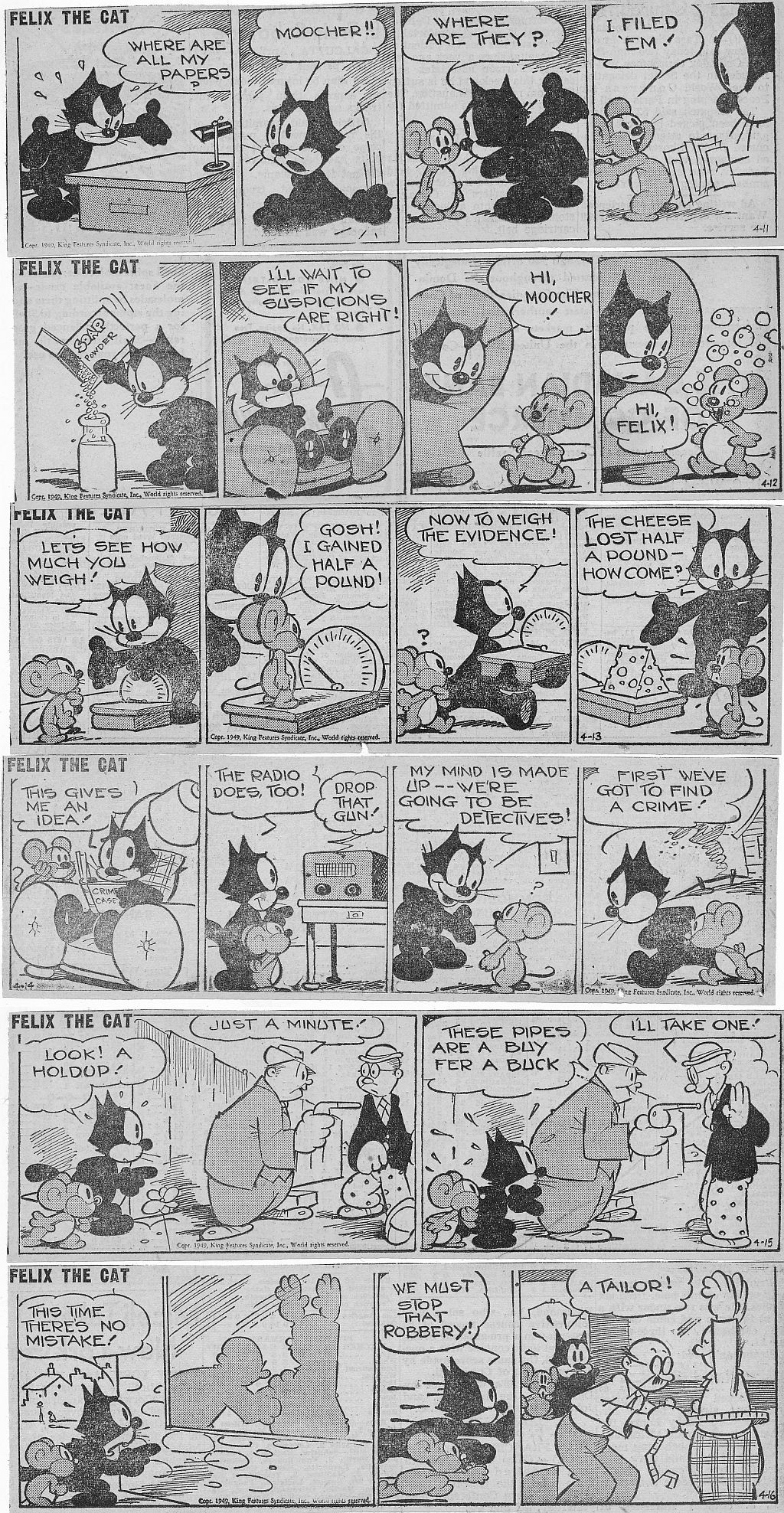            Felix is from 4-11 to 4-16-49 this time, all from a clipped run. Moocher and Felix go in to the detective business in the 4-14, but only mistake innocent citizens for crooks.Â
           Felix is from 4-11 to 4-16-49 this time, all from a clipped run. Moocher and Felix go in to the detective business in the 4-14, but only mistake innocent citizens for crooks. 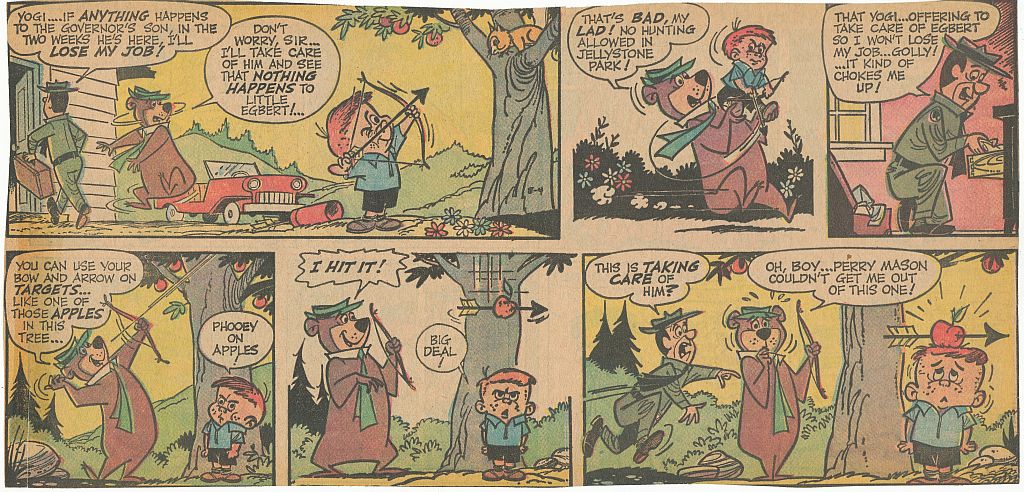


 In anticipation of Yowp’s post next month, here are the Yogi Sundays from August, 1963, clipped from the St. Louis Post-Dispatch. The 8-25 is my favorite of this batch, as Boo-Boo’s tooth is no match for the rear axle and differential of a full size Acme truck! Yowp will have the half-page versions of these strips coming soon. Give that old dog a visit. In the upcoming month, I will do a brief essay on retirement and other topics of interest to inveterate cartoonists.
In anticipation of Yowp’s post next month, here are the Yogi Sundays from August, 1963, clipped from the St. Louis Post-Dispatch. The 8-25 is my favorite of this batch, as Boo-Boo’s tooth is no match for the rear axle and differential of a full size Acme truck! Yowp will have the half-page versions of these strips coming soon. Give that old dog a visit. In the upcoming month, I will do a brief essay on retirement and other topics of interest to inveterate cartoonists.
Koko the Blue Review and Your Comics Page Too
Here is a review of Charles Brubaker’s (aka Chuck Akira) new comic book “KoKo the Blue #1” and the earlier “A Witch Named Katrina #1”. Charles began doing comic book stories with his little girl witch character KoKo (originally called Katrina), in 2012. He has a professional looking style for a relatively new cartoonist, and he has a lot of imagination he’s brought to his tales. Being raised in both Japan and the USA, Charles has a Japanese and American bent to his comic narratives. That’s why when KoKo and Tofu (her cat familiar and boss) are asleep, “snooze bubbles” emerge from their noses, and iconography that such Japanese comic artists as Osamu Tezuka used in his epic Manga series “Hinotori”, the Phoenix bird, form the lexus of the main story in KoKo the Blue #1: “a Witch-Hunting We Will Go.” The Phoenix is a sacred bird in Egyptian religion–once every 500 years the Phoenix sets fire to itself, to be reborn as a new Phoenix. In Chinese mythology, the Phoenix is a symbol of longevity. Since Chinese culture informs much of Japanese culture, the Phoenix is well known there. The Egyptian legend says that only one Phoenix at a time can be on the earth. In KoKo the Blue, there are a least two Phoenix nesting in the Brimson Forest. KoKo and her brother Jodo are sent to Brimson Forest to find Dangan Bullets (also Japanese cultural stuff), which turn out to be magic bullets that poachers hunt Phoenix with. Of course the subtext here is that the poachers who drink the Phoenix blood will have a very long life, a theme Tezuka used in Hinotori.
Charles’s American side emerges in funny poses and action situations as shown here on page seven from KoKo the Blue. The multiple poses in panel 4 have a comic spirit of action as KoKo and Jodo make a crash landing in the forest. Charles is an aspiring animator, as you can sense from the multiple poses in this panel. The ending of the story has an American animated cartoon feel to it, as KoKo and Jodo rebel against their boss, Tofu the Cat, and chase him through Brimson Forest, shooting magic rays at him from KoKo’s magic wand. I also like the use of color in KoKo the Blue, the color helps complete the shapes in the characters, making them pleasing to look at.
The multiple poses in panel 4 have a comic spirit of action as KoKo and Jodo make a crash landing in the forest. Charles is an aspiring animator, as you can sense from the multiple poses in this panel. The ending of the story has an American animated cartoon feel to it, as KoKo and Jodo rebel against their boss, Tofu the Cat, and chase him through Brimson Forest, shooting magic rays at him from KoKo’s magic wand. I also like the use of color in KoKo the Blue, the color helps complete the shapes in the characters, making them pleasing to look at.
   My favorite of Charles’s “Girl Witch” stories is “The Speakeasy Potion ” from “A Witch Called Katrina” (Koko’s original name), in which she invents a potion to enable inanimate objects to speak. The potion accidentally gets spilled on the floor in KoKo’s house, and the floor comes to life! There’s something very L. Frank Baum about this premise that really appeals to me. (Mombie the Witch sprinkling Jack Pumpkinhead with the “Magical Powder of Life” in “The Land of Oz” is brought to mind).
  Charles is still a young man, and works very hard on his tales of KoKo. So we have more stories to look forward to. There will be another issue out in August, so watch for it! Support an aspiring cartoonist and animator with a rich imagination. It’s tough out there for comic book independents, especially independent humorous books, to gain a foothold. Even Robert Crumb seems to have disappeared from the indy comic book scene. Order from Rekaburb, 247 Red Bud Circle, Martin Tennessee, 38237. You can see the prices on the covers reproduced at the start of this post.
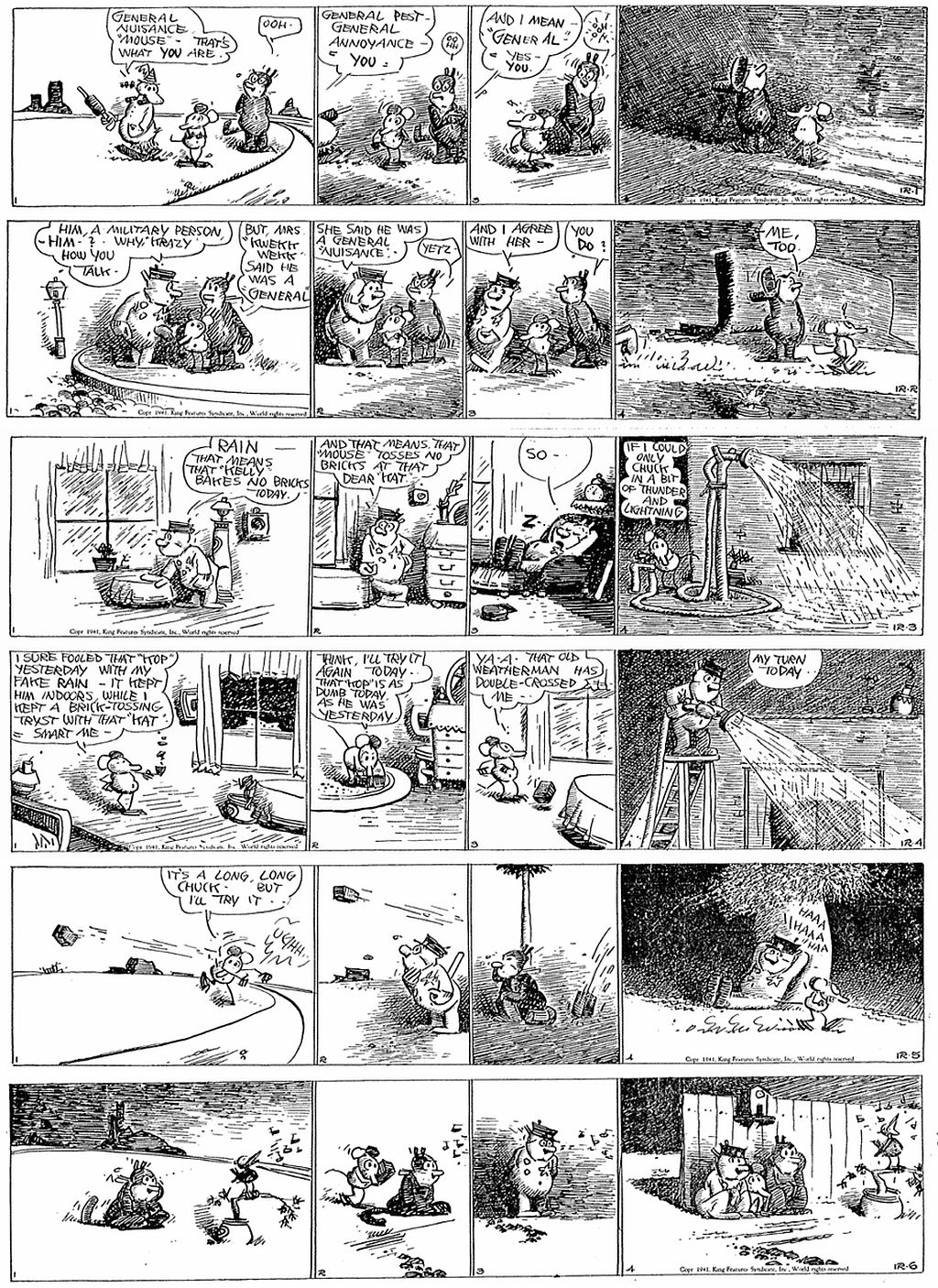    Krazy is from 12-1 to 12-6-1941 this time. Mrs. Kwakk-Wakk declares Ignatz to be a “General Nuisance” in the 12-1 and Krazy’s logic makes him think that the Mice is in the military. In the 12-3 and 12-4 strips, Ignatz and Pupp take turns faking each other out with a hose outside the window gag, producing fake rain.
   Krazy is from 12-1 to 12-6-1941 this time. Mrs. Kwakk-Wakk declares Ignatz to be a “General Nuisance” in the 12-1 and Krazy’s logic makes him think that the Mice is in the military. In the 12-3 and 12-4 strips, Ignatz and Pupp take turns faking each other out with a hose outside the window gag, producing fake rain.
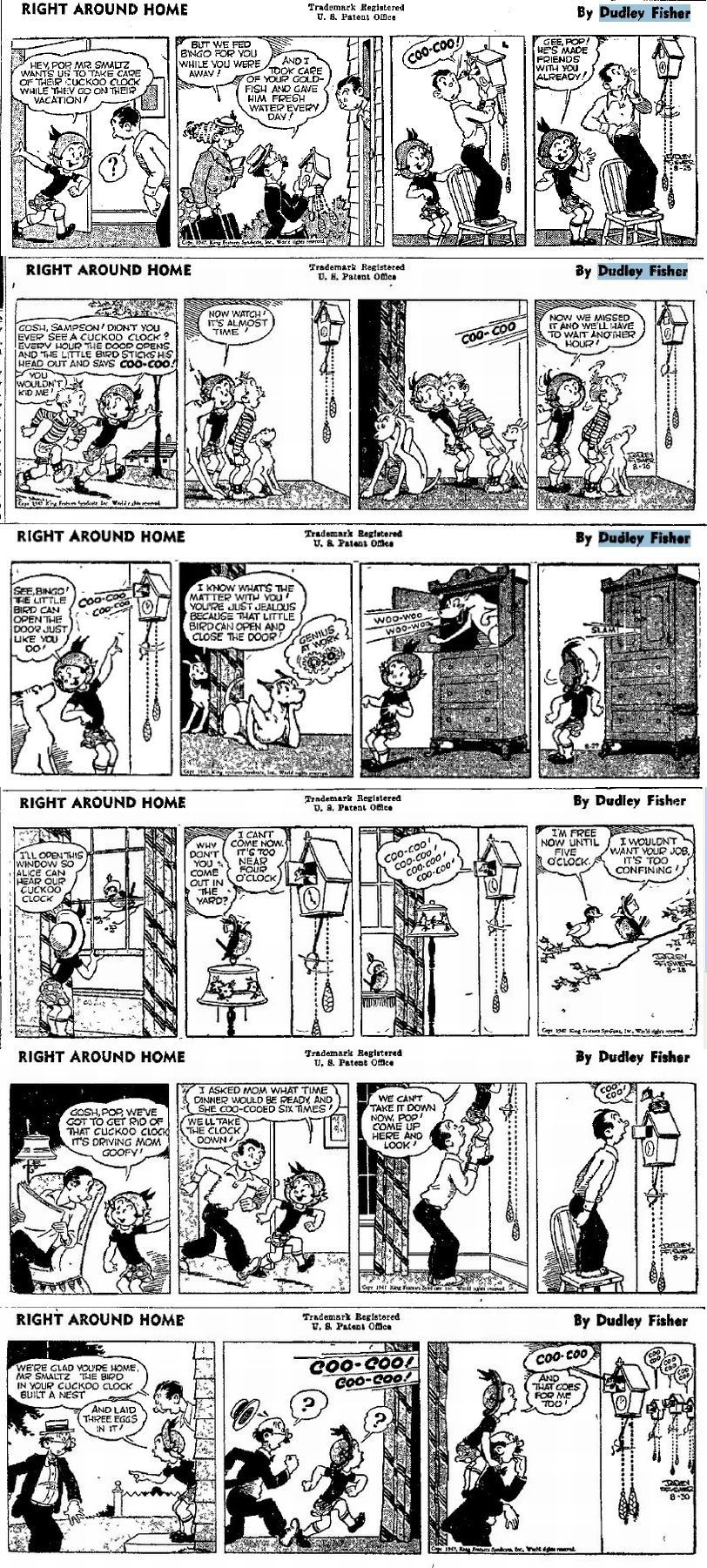 Â Myrtle, from 8-25 to 8-30-1947, has a whole week of Coo Coo clock gags. Freddy has to baby-sit the Smaltz’s Coo-Coo clock while they are away. In the 8-27, Bingo is jealous of the Coo-Coo’s door-opening ability, and goes into competition in the old fashioned hutch. Fisher’s whimsy gets a work out in the 8-30, as the Coo Coo sits on a nest and hatches three little Coo Coo’s, each with it’s own miniature clock!
 Myrtle, from 8-25 to 8-30-1947, has a whole week of Coo Coo clock gags. Freddy has to baby-sit the Smaltz’s Coo-Coo clock while they are away. In the 8-27, Bingo is jealous of the Coo-Coo’s door-opening ability, and goes into competition in the old fashioned hutch. Fisher’s whimsy gets a work out in the 8-30, as the Coo Coo sits on a nest and hatches three little Coo Coo’s, each with it’s own miniature clock!
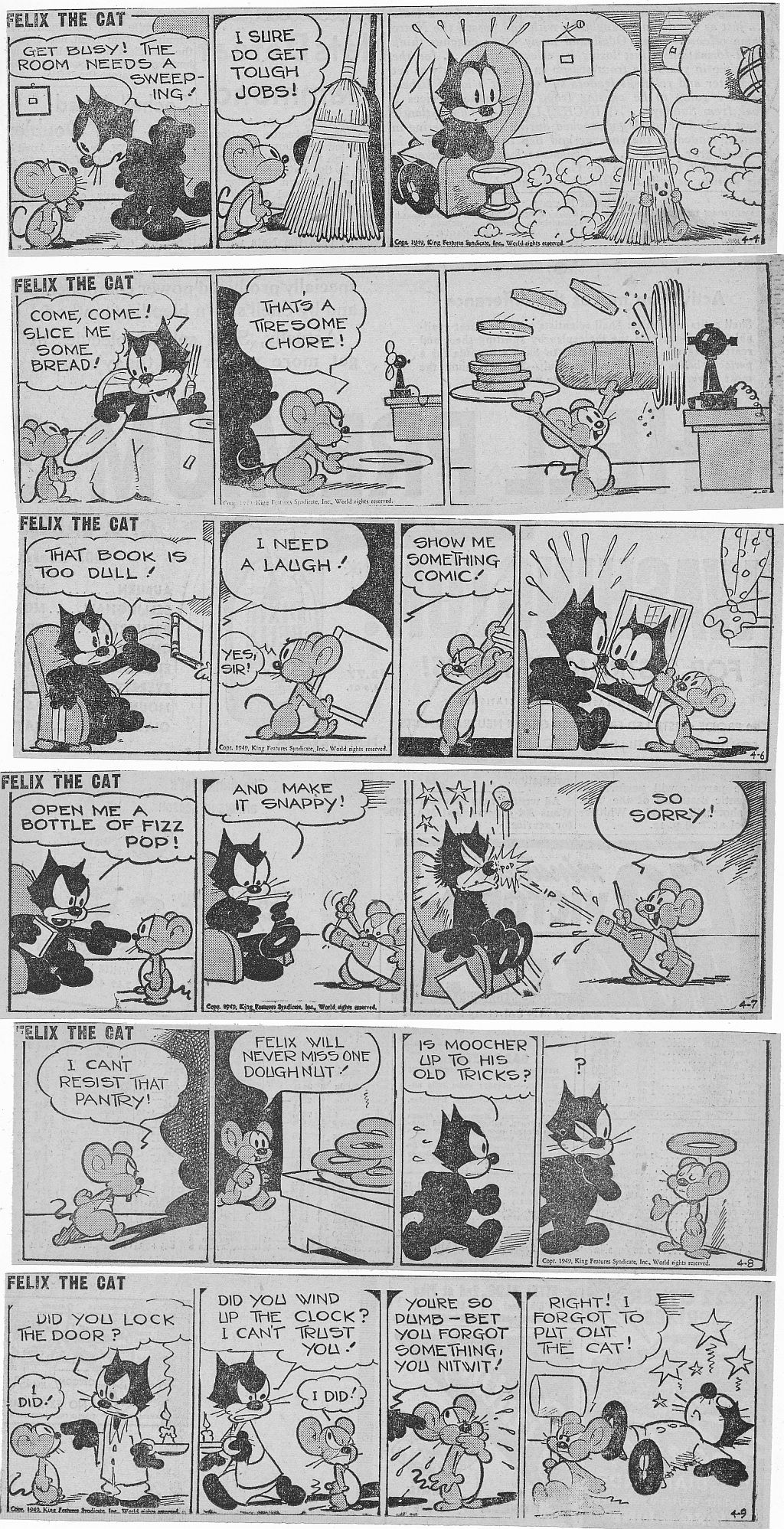  Felix, from 4-2 to 4-9-1949 goes through a whole week of humiliation at the hands of Moocher Mouse. Moocher holds a mirror up to Felix’s face when he longs to see “something comic” in the 4-6, Felix gets a soda pop stopper in the face in the 4-7 and in the 4-8, Moocher swipes a Tom and Jerry gag as he “puts out the cat” with a big mallet. It’s interesting how slim Felix looks in his pajamas! Enjoy the post, readers!
 Felix, from 4-2 to 4-9-1949 goes through a whole week of humiliation at the hands of Moocher Mouse. Moocher holds a mirror up to Felix’s face when he longs to see “something comic” in the 4-6, Felix gets a soda pop stopper in the face in the 4-7 and in the 4-8, Moocher swipes a Tom and Jerry gag as he “puts out the cat” with a big mallet. It’s interesting how slim Felix looks in his pajamas! Enjoy the post, readers!
TMBSOC accepted in OTTAWA Int. Animation Festival!
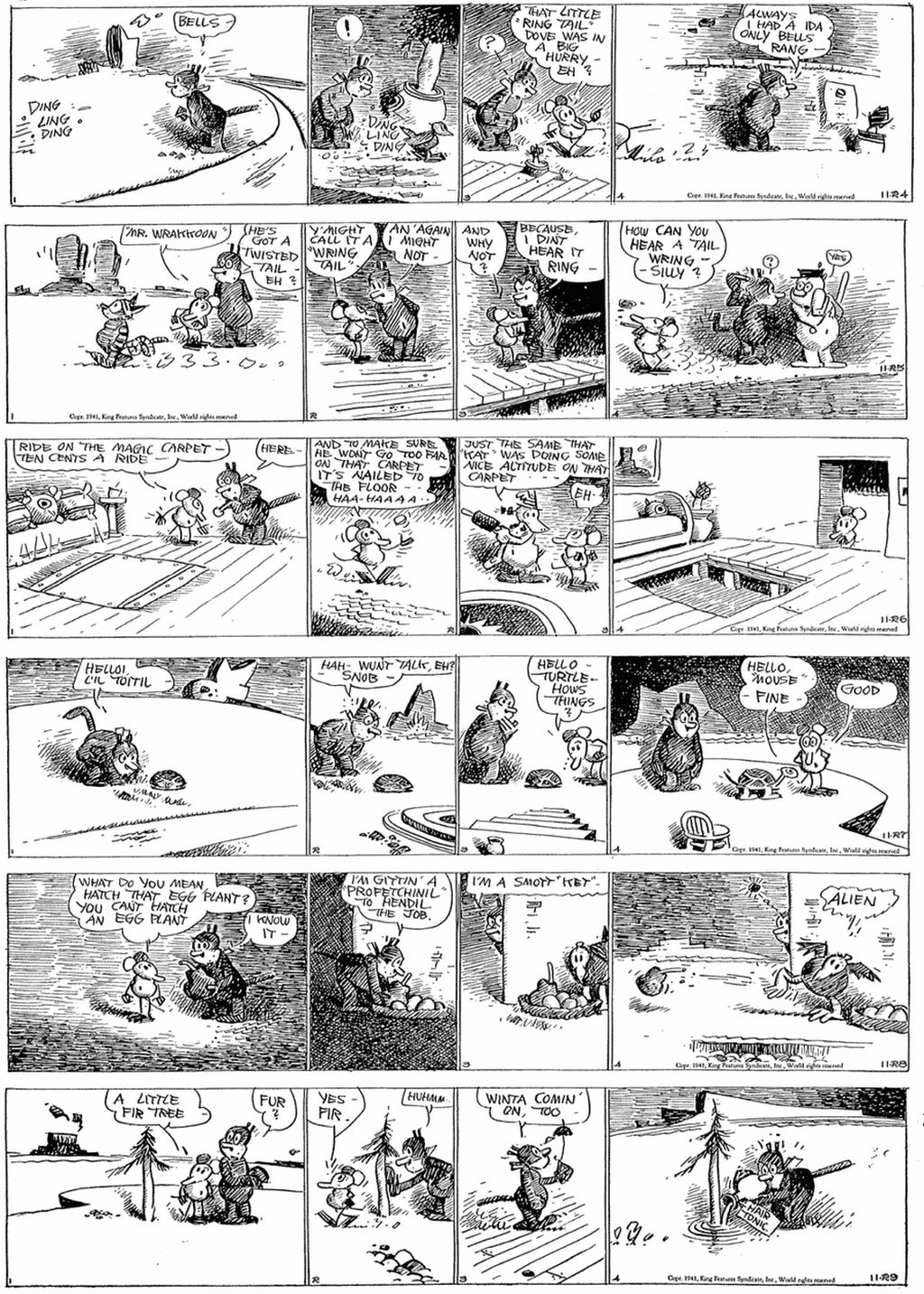 Â Folks, I’m very excited to announce that our new cartoon short, THERE MUST BE SOME OTHER CAT, had been accepted into competition at the Ottawa International Animation Festival in September! Out last short, “It’s ‘The Cat'”, was screened out of competish at the Ottawa Festival, but this time they’ve opened the doors to us fully. September looks to be a good month for Itza, we’ll keep you posted.
 Folks, I’m very excited to announce that our new cartoon short, THERE MUST BE SOME OTHER CAT, had been accepted into competition at the Ottawa International Animation Festival in September! Out last short, “It’s ‘The Cat'”, was screened out of competish at the Ottawa Festival, but this time they’ve opened the doors to us fully. September looks to be a good month for Itza, we’ll keep you posted.
Krazy is from 11-24 to 11-30-1941 this time. Loaded with visual and aural puns, Krazy tackles “Belles”, “Eggplents”, “Megic Coppets” and “Fur Trees” among other outlandish extensions of reason, all or most taking place on Herriman’s stage floorboards. Garge often thought of “Krazy Kat” as taking place on a little stage, you can see below the floorboards in the 11-26.
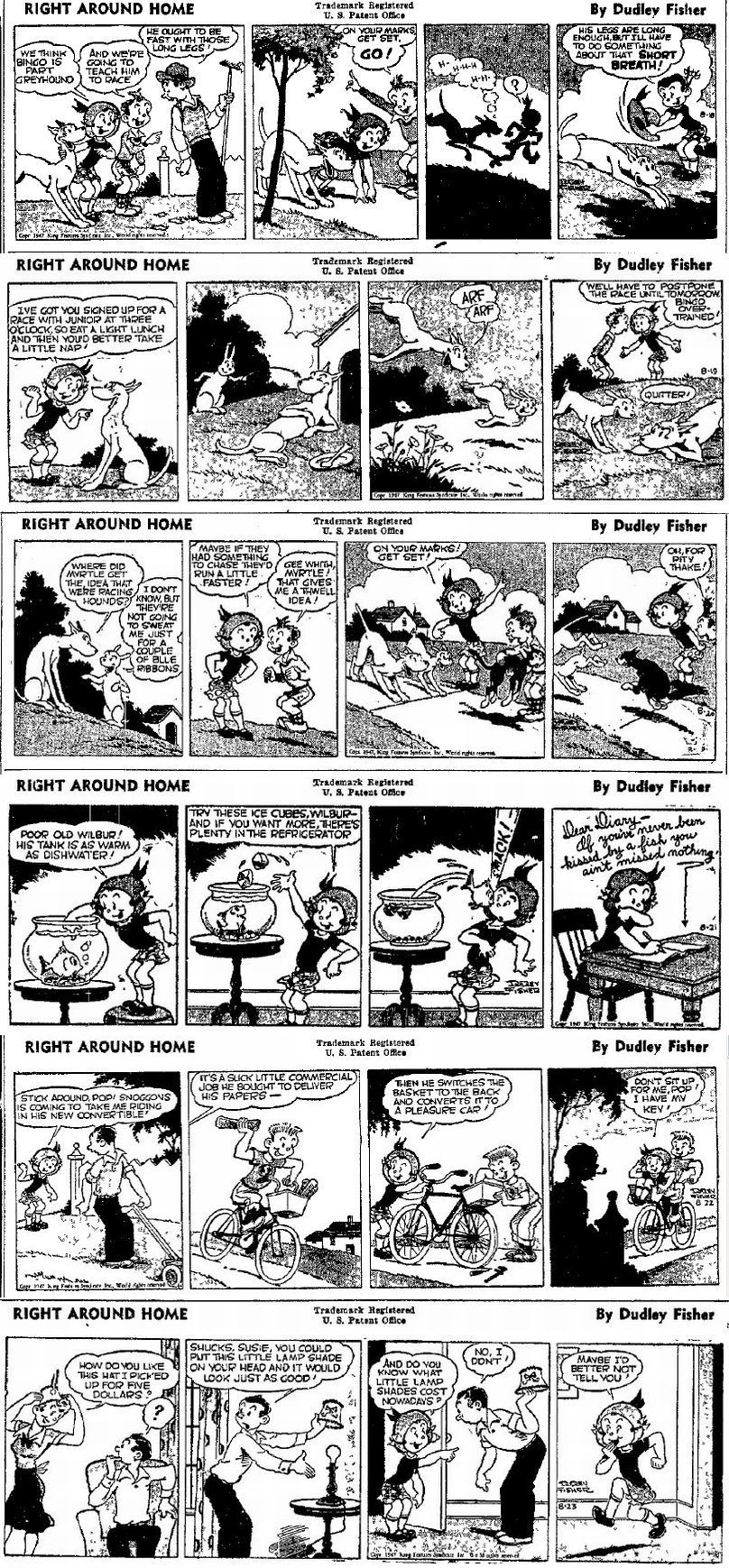 Â Myrtle from 8-18 to 8-23-47, tries out a little continuity as Myrtle spends the first three days training Bingo to be a racing dog, only to be bested by a cat. Myrtle is kissed by a fish in the 8-21, goes on a handlebar date with Snoggons in the 8-22 and in the 8-23, we see a good example of Fisher’s panel gag timing between the third and fourth panel as Myrtle decides not to tell her Pop about the price of lampshades.
 Myrtle from 8-18 to 8-23-47, tries out a little continuity as Myrtle spends the first three days training Bingo to be a racing dog, only to be bested by a cat. Myrtle is kissed by a fish in the 8-21, goes on a handlebar date with Snoggons in the 8-22 and in the 8-23, we see a good example of Fisher’s panel gag timing between the third and fourth panel as Myrtle decides not to tell her Pop about the price of lampshades.
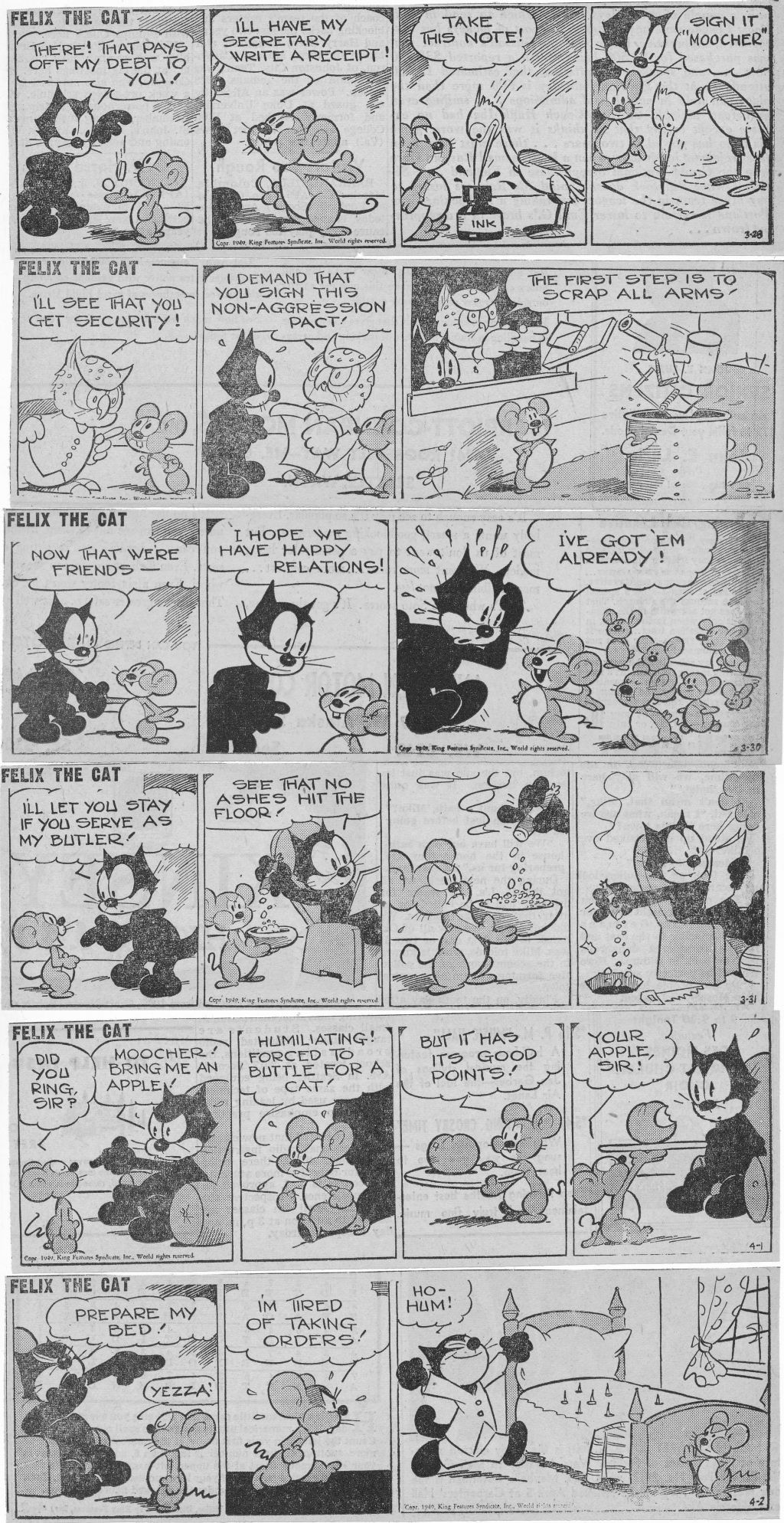 Â In Felix, from 3-28 to 4-2-1949, Felix has to pay off his debt to Moocher Mouse, then in the 3-31, Moocher reverts to being Felix’s butler. It only takes two days for Moocher to rebel against buttling, and puts tacks in Felix’s bed in the 4-2. As David Gerstein suggested, this type of back and forth between Felix and Moocher suggests Tom and Jerry type conflict, which was at it’s height in 1949 in movie theaters.
 In Felix, from 3-28 to 4-2-1949, Felix has to pay off his debt to Moocher Mouse, then in the 3-31, Moocher reverts to being Felix’s butler. It only takes two days for Moocher to rebel against buttling, and puts tacks in Felix’s bed in the 4-2. As David Gerstein suggested, this type of back and forth between Felix and Moocher suggests Tom and Jerry type conflict, which was at it’s height in 1949 in movie theaters.
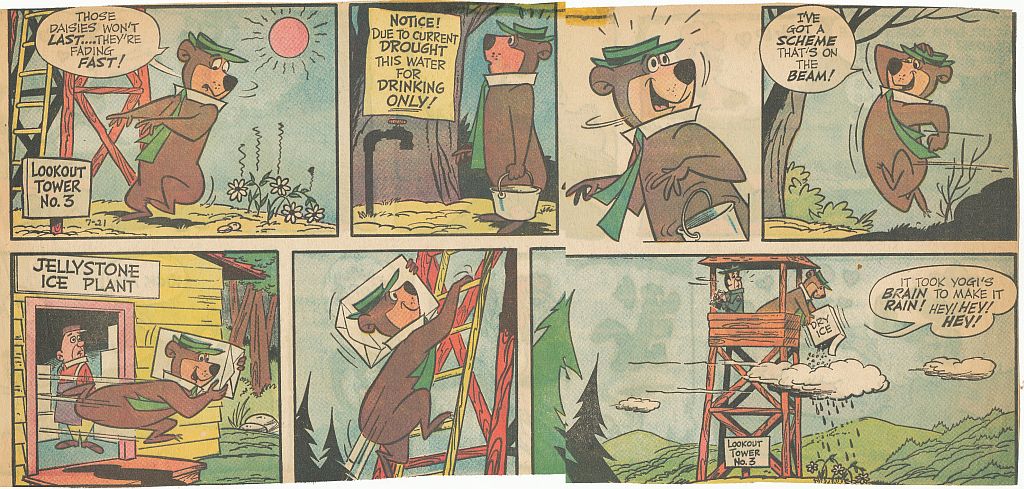
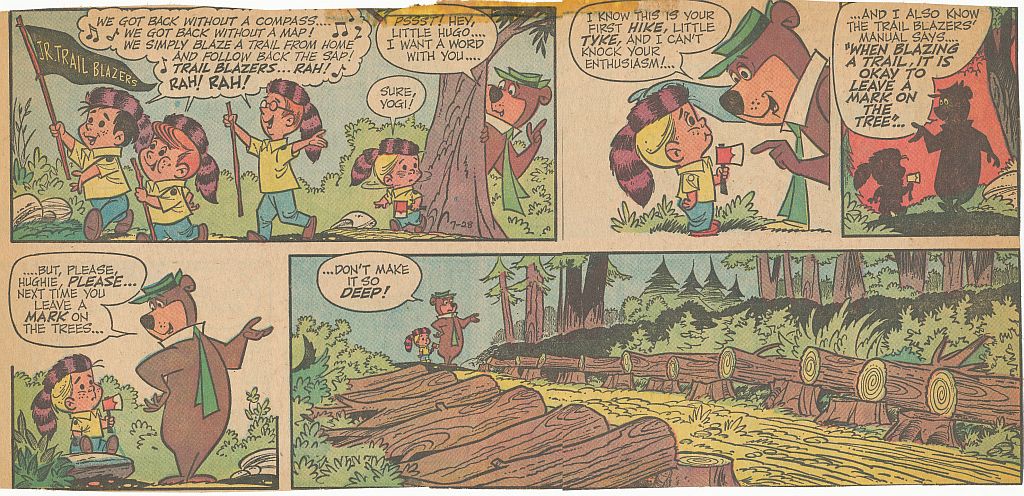  Here’s Yogi Bear from July, 1963. I’m missing July 14th, because I pasted over it in a comic scrapbook I was keeping back in ’63. If I’d had more foresight at the time, I would have kept the entire Sunday Comics supplement, but instead, foolishly spent a lot of time carefully clipping my favorites. I almost didn’t find the 7-21 and 7-28 episodes, but they turned up on the backs of POGO, which I also saved from the St. Louis Post-Dispatch. I didn’t know who Harvey Eisenberg was in ’63, but I knew I liked his style. I loved the Tom and Jerry comic books he drew.  He developed such a beautiful ink line, and his feel for forms in action was so appealing that when any other artist attempted to draw the Hanna-Barbera characters for print, they just didn’t look right to me. Joe Barbera had great respect for Harvey’s drawing, and went into business with him to produce the “Red Rabbit” and “Foxy Fagan” comic books for Dearfield Comics in 1947, without MGM’s participation. To see the full versions in black and white, including the missing 7-14 strip, go here: http://yowpyowp.blogspot.com/2013/07/yogi-bear-weekend-comics-july-1963.html over to Yowp’s blog and take a look.
 Here’s Yogi Bear from July, 1963. I’m missing July 14th, because I pasted over it in a comic scrapbook I was keeping back in ’63. If I’d had more foresight at the time, I would have kept the entire Sunday Comics supplement, but instead, foolishly spent a lot of time carefully clipping my favorites. I almost didn’t find the 7-21 and 7-28 episodes, but they turned up on the backs of POGO, which I also saved from the St. Louis Post-Dispatch. I didn’t know who Harvey Eisenberg was in ’63, but I knew I liked his style. I loved the Tom and Jerry comic books he drew.  He developed such a beautiful ink line, and his feel for forms in action was so appealing that when any other artist attempted to draw the Hanna-Barbera characters for print, they just didn’t look right to me. Joe Barbera had great respect for Harvey’s drawing, and went into business with him to produce the “Red Rabbit” and “Foxy Fagan” comic books for Dearfield Comics in 1947, without MGM’s participation. To see the full versions in black and white, including the missing 7-14 strip, go here: http://yowpyowp.blogspot.com/2013/07/yogi-bear-weekend-comics-july-1963.html over to Yowp’s blog and take a look.
I’ve had a lot of computer problems lately, I have an “old” OS, Windows XP, which is being orphaned by Microsoft at a swift clip, already YouTube and Daily Ink don’t work well with it. I upgraded the browser to IE 8, and then was forced to upgrade to the latest version of Yahoo mail, and that little click disabled my computer so that I couldn’t upload or download any pictures. This effectively derailed my blog for quite a few weeks. Thanks to brother-in-law Roger, who is a retired Physics professor and computer genius, all is now fixed up. I’m happy to be back again, see you soon, unless Microsoft has some more “upgrades” lurking in the background.
Your Comics Page and a Cemetery visit-6-14-2013
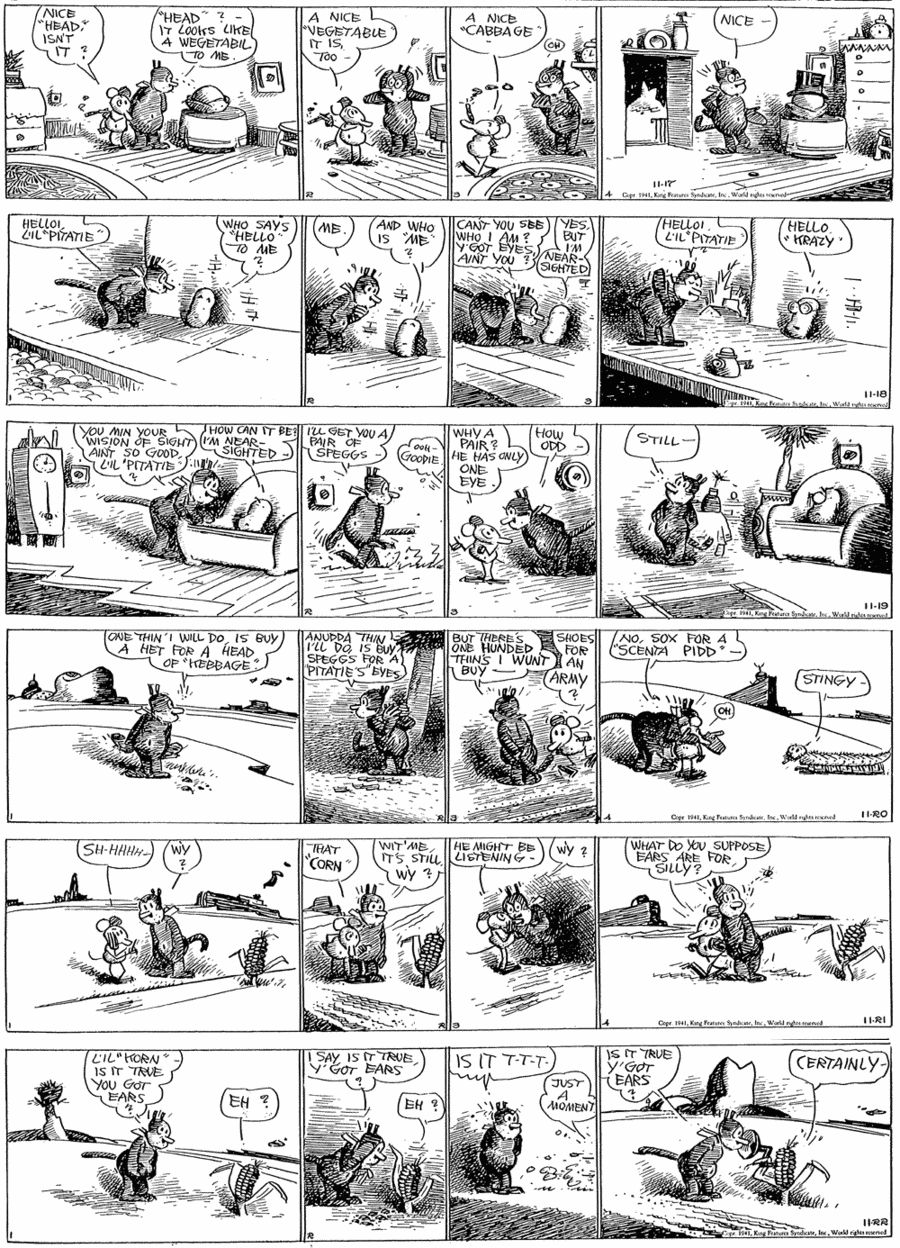 Â In Krazy this time, from 11-17 to 11-22-1941, Krazy does a whole week of gags with vegetables. Cabbages (he buys a “het” for one), potatoes (he buys them glasses for their “eyes”) and an ear of corn has an ear trumpet. However, Krazy “wun’t buy sox for a senta pidd” in the 11-20.
 In Krazy this time, from 11-17 to 11-22-1941, Krazy does a whole week of gags with vegetables. Cabbages (he buys a “het” for one), potatoes (he buys them glasses for their “eyes”) and an ear of corn has an ear trumpet. However, Krazy “wun’t buy sox for a senta pidd” in the 11-20.
 Â In Myrtle, from 8-11 to 8-16-1947, Dudley Fisher maintains some continuity as Snoggons mails Myrtle’s braid back to her in the 8-11, writing to her that he “loves another now”. Bingo continues to use his door opening abilities to his advantage in the 8-13, as he raids the refrigerator for Popsicles. There is a deft reference to radio sound effects as Sampson and Myrtle trick her Mom into thinking she is washing her face by creating the sounds of washing, using a Hollywood sound effects kit that Sampson received from his uncle (8-15 strip). Those of us who grew up outside the era of dramatic radio don’t prize the ability of a good sound effects technician, but Myrtle sure did, in 1947!Â
 In Myrtle, from 8-11 to 8-16-1947, Dudley Fisher maintains some continuity as Snoggons mails Myrtle’s braid back to her in the 8-11, writing to her that he “loves another now”. Bingo continues to use his door opening abilities to his advantage in the 8-13, as he raids the refrigerator for Popsicles. There is a deft reference to radio sound effects as Sampson and Myrtle trick her Mom into thinking she is washing her face by creating the sounds of washing, using a Hollywood sound effects kit that Sampson received from his uncle (8-15 strip). Those of us who grew up outside the era of dramatic radio don’t prize the ability of a good sound effects technician, but Myrtle sure did, in 1947!Â
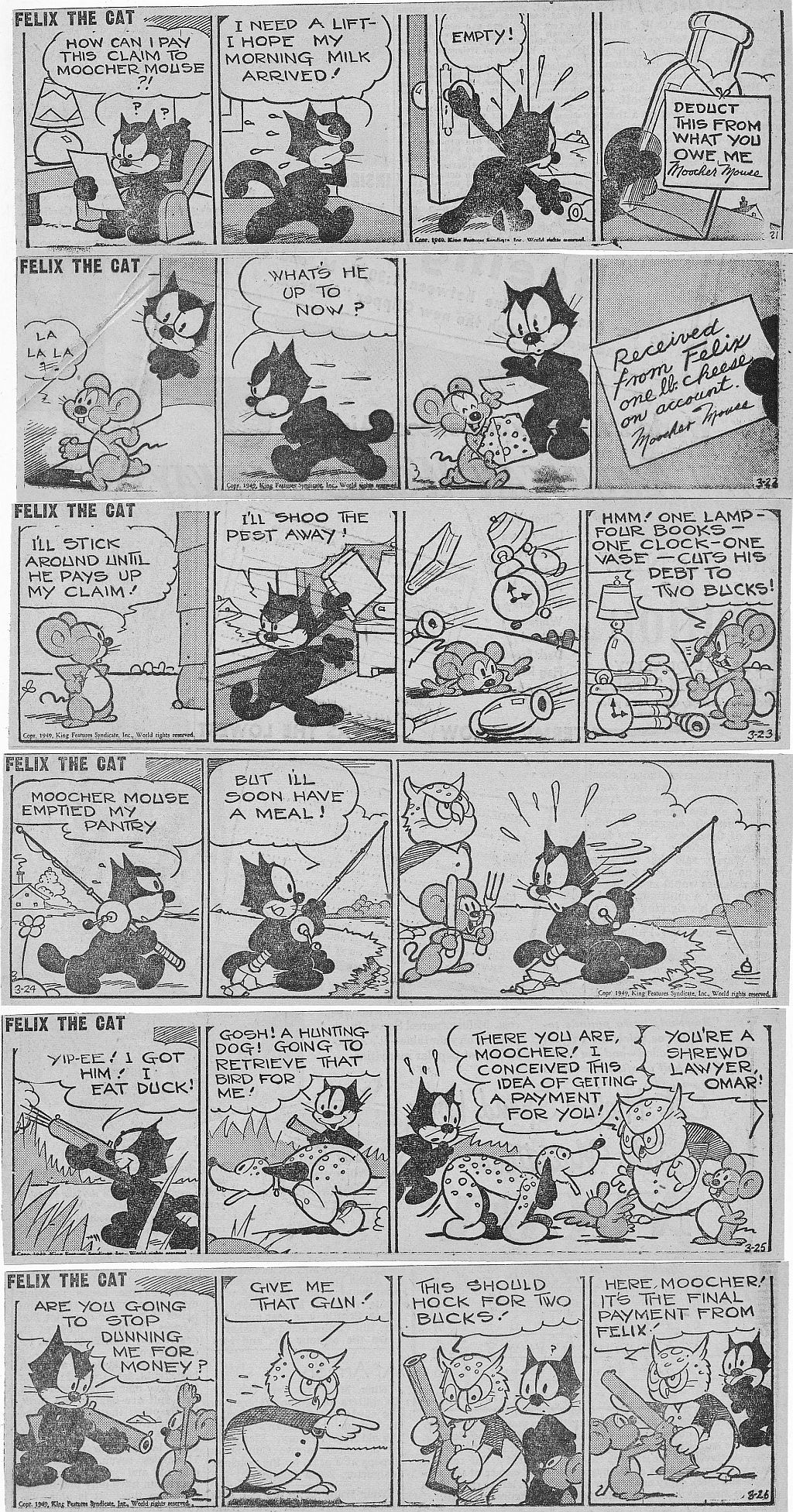 Â Felix, from 3-21 to 3-26-1949, continues Moocher Mouse’s dominion over Felix. In some of the strips from 1936, there were times when Felix was omitted from his strip for days at a time. By 1949, it seemed funny to have Felix continually frustrated by Moocher, and Omar the Owl, Moocher’s personal shyster. Moocher has the effect of reducing Felix’s importance to his strip. This is not unlike the Popeye cartoons produced in the late 1930s by Fleischer and into the 1940s by Famous Studios, in which Popeye became a patsy for his nephews, his Pappy and Wimpy, in effect being overshadowed in his own cartoons by the supporting cast. I guess that’s what happens when you’re a big cartoon star for too long, they run out of ideas for you. Look what happened to Mickey.
 Felix, from 3-21 to 3-26-1949, continues Moocher Mouse’s dominion over Felix. In some of the strips from 1936, there were times when Felix was omitted from his strip for days at a time. By 1949, it seemed funny to have Felix continually frustrated by Moocher, and Omar the Owl, Moocher’s personal shyster. Moocher has the effect of reducing Felix’s importance to his strip. This is not unlike the Popeye cartoons produced in the late 1930s by Fleischer and into the 1940s by Famous Studios, in which Popeye became a patsy for his nephews, his Pappy and Wimpy, in effect being overshadowed in his own cartoons by the supporting cast. I guess that’s what happens when you’re a big cartoon star for too long, they run out of ideas for you. Look what happened to Mickey.

 Â Speaking of Mickey, a few weeks ago, our Thursday painting group visited the Glendale Forest Lawn cemetery, where Walt Disney is buried in a little enclosed garden outside the Freedom Mausoleum. (That’s Cathy in the garden.) It’s interesting that in addition to Walt and Lillian being there, Sharon Disney’s first husband, Robert Brown is there, and Sharon’s ashes are mentioned as being “scattered in paradise”. That makes three names added to the family crypt since the last time I visited Walt’s last resting place. He’s still sadly missed by all us fans.
 Speaking of Mickey, a few weeks ago, our Thursday painting group visited the Glendale Forest Lawn cemetery, where Walt Disney is buried in a little enclosed garden outside the Freedom Mausoleum. (That’s Cathy in the garden.) It’s interesting that in addition to Walt and Lillian being there, Sharon Disney’s first husband, Robert Brown is there, and Sharon’s ashes are mentioned as being “scattered in paradise”. That makes three names added to the family crypt since the last time I visited Walt’s last resting place. He’s still sadly missed by all us fans.
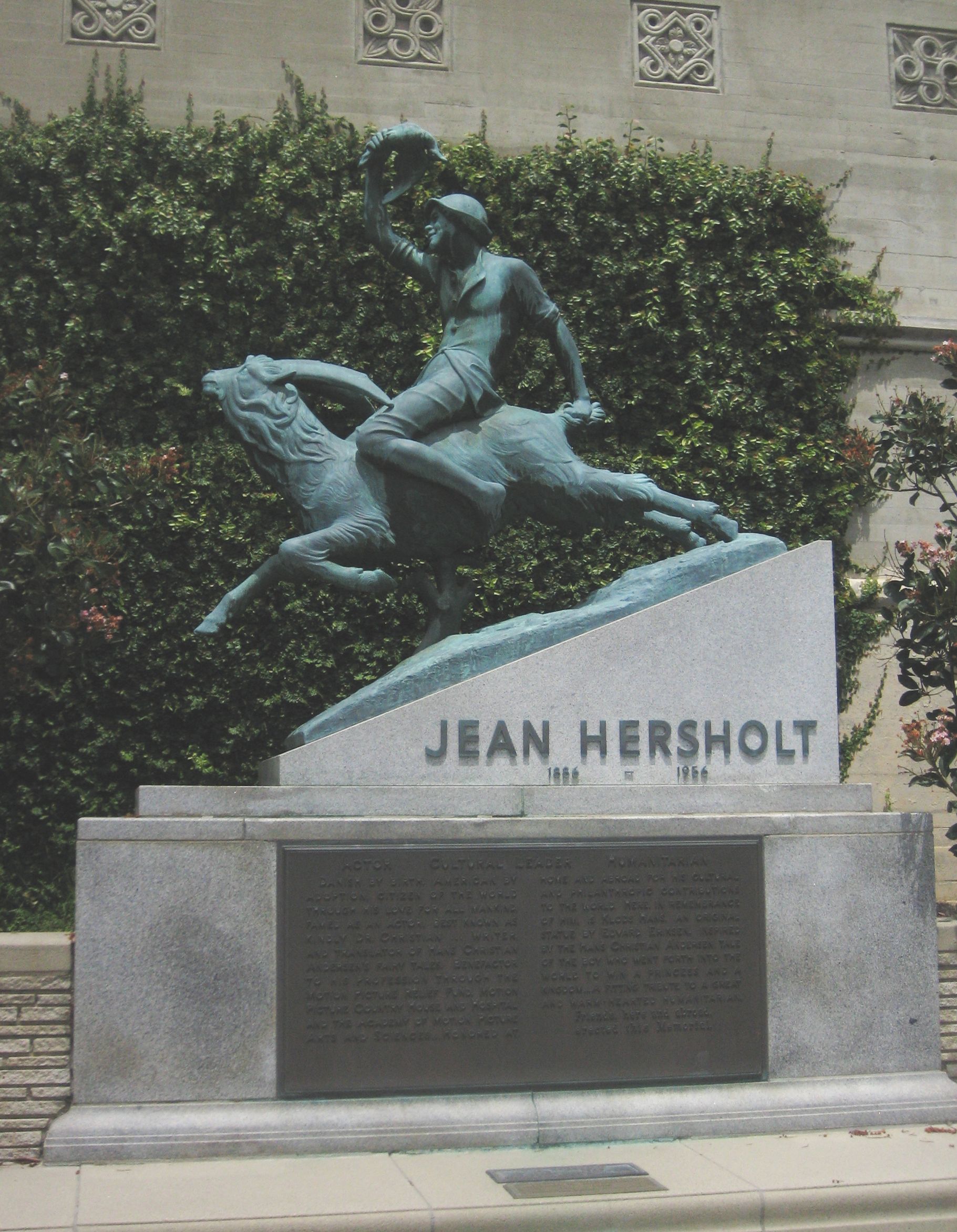
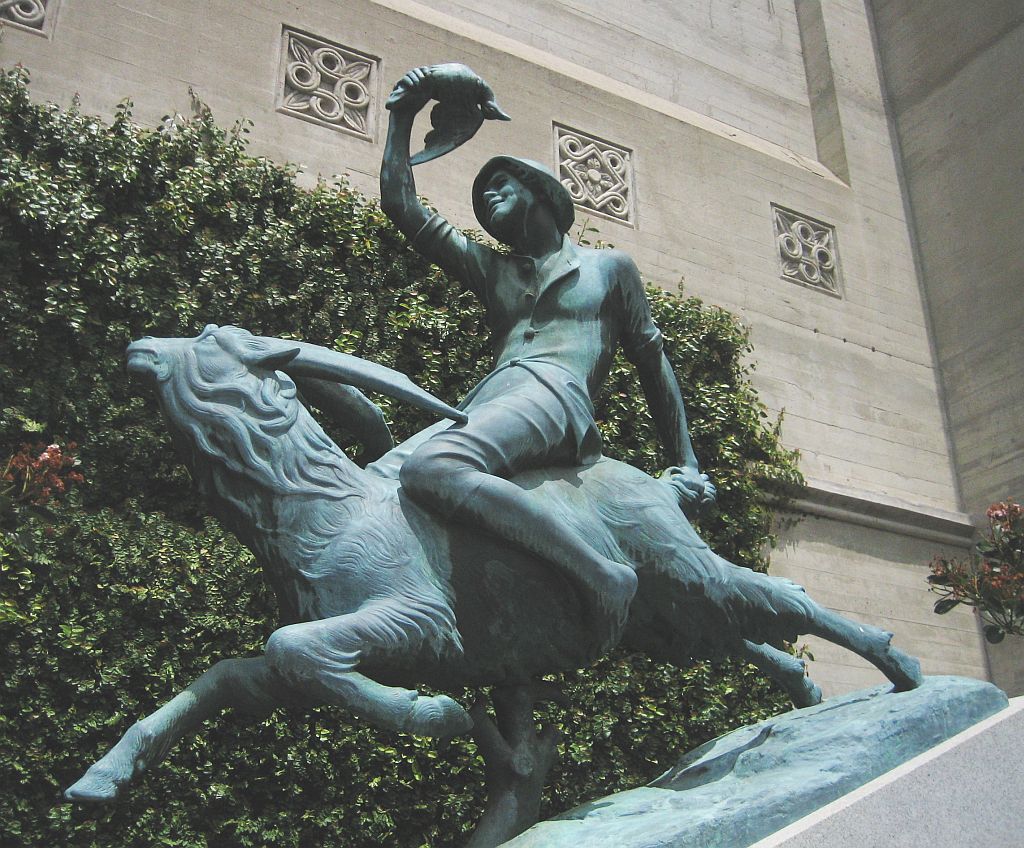 Â Here’s my favorite memorial in the whole Glendale Forest Lawn, Jean Hersholt’s marker. That’s the character “Clumsy Hans” riding the goat, a favorite Hans Christian Andersen story of Mr. Hersholt’s. A few members of our painting group were incredulous at the mention of Mr. Hersholt’s name (“Who’s Jean Hersholt?”) What a sad thing to be forgotten. Mr. Hersholt died in 1956, and since he was the founder of the Motion Picture and Television Relief Fund (still around today), the Academy of Motion Picture Arts and Sciences established the “Jean Hersholt Memorial Award” in 1956, rewarding outstanding philanthropy. Hersholt was famous for the character “Dr. Christian” (named after Hans Christian Andersen) which he performed on radio, the movies and into early television, and the Grandfather in Shirley Temple’s version of “Heidi”, as well as in “Grand Hotel” and many other fine performances. I think he was most proud of his work as a translator of Hans Christian Andersen’s stories from Danish into English. He did 160 of the tales, and they stood as the standard translations for many years. (Go read some Andersen, for heaven’s sake! My favorite story is “The Travelling Companion”, but there are many good ones.) I’m glad that the Academy still keeps the Jean Hersholt Memorial Award going, let’s never forget this wonderful actor and great humanitarian.
 Here’s my favorite memorial in the whole Glendale Forest Lawn, Jean Hersholt’s marker. That’s the character “Clumsy Hans” riding the goat, a favorite Hans Christian Andersen story of Mr. Hersholt’s. A few members of our painting group were incredulous at the mention of Mr. Hersholt’s name (“Who’s Jean Hersholt?”) What a sad thing to be forgotten. Mr. Hersholt died in 1956, and since he was the founder of the Motion Picture and Television Relief Fund (still around today), the Academy of Motion Picture Arts and Sciences established the “Jean Hersholt Memorial Award” in 1956, rewarding outstanding philanthropy. Hersholt was famous for the character “Dr. Christian” (named after Hans Christian Andersen) which he performed on radio, the movies and into early television, and the Grandfather in Shirley Temple’s version of “Heidi”, as well as in “Grand Hotel” and many other fine performances. I think he was most proud of his work as a translator of Hans Christian Andersen’s stories from Danish into English. He did 160 of the tales, and they stood as the standard translations for many years. (Go read some Andersen, for heaven’s sake! My favorite story is “The Travelling Companion”, but there are many good ones.) I’m glad that the Academy still keeps the Jean Hersholt Memorial Award going, let’s never forget this wonderful actor and great humanitarian.
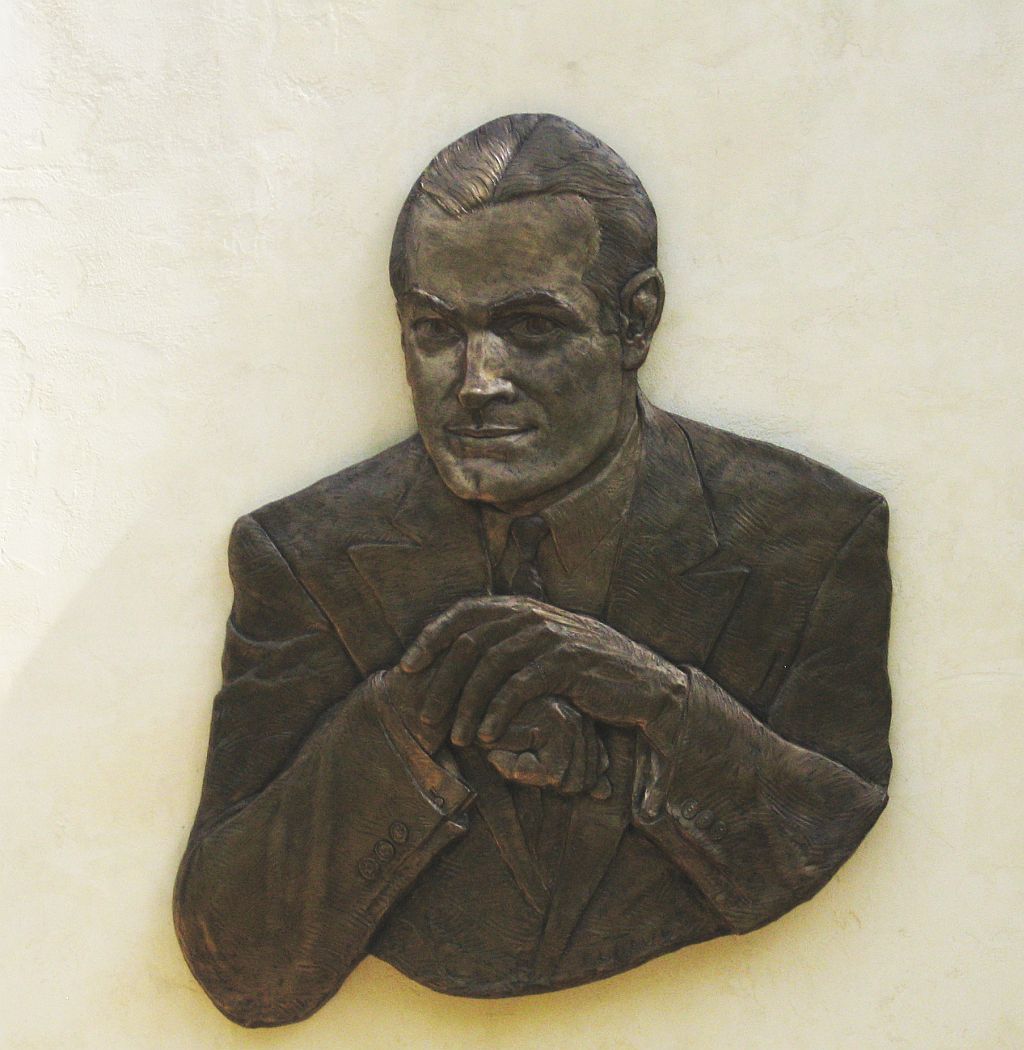


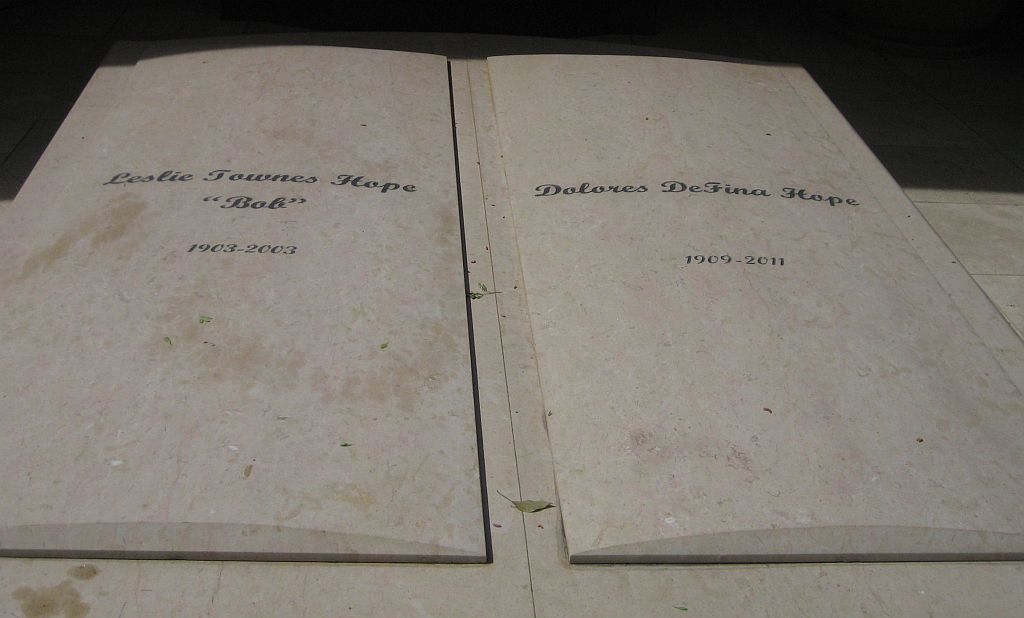 Â At the San Fernando Mission, another plein air painting destination, Cathy and I blundered into the Bob Hope Memorial Garden, not far from the main entrance to the Mission. It was guarded by a pretty stern Mission cop, who spoke harshly to us for “walking on the grass”. It’s a pretty garden, and on the inside, Bob and Dolores Hope’s graves are set up inside a structure that resembles the Hollywood Bowl! The brass wall decoration is the only actual image of Bob Hope in the garden. Bob passed on in 2003 at the age of 100, Dolores passed on in 2011 at the age of 102! Speaking of Jean Hersholt, Bob won the Humanitarian Award in 1960. Bob’s greatest comedy was in his radio show in the late 1930s and early 1940s, as well as the “Road” comedies and “The Paleface”, co-starring Jane Russell. I think that Jerry Colonna remains the funniest part of the Hope legacy, you can read about him on Wikipedia. If you hear any of the early 1940s Bob Hope radio shows, Mr. Colonna was the silliest member of the cast, with his “Who’s Yehudi?” and “Ah, Yes…” catch phrases. One of my earliest memories of funny voices was the Jerry Colonna Capitol children’s record: “Colonna’s Trolley”, which I heard in pre-school back in St. Louis. I only recently managed to snag a copy of the original 78 recording on Ebay. Billy Bletcher is in the cast as well. Jerry Colonna had a stroke in 1966 and was effectively in the Motion Picture Country Hospital until his death in 1986. Bob Hope visited Jerry there often, and it’s interesting that Jerry Colonna is also buried in the San Fernando Mission cemetery, not far from Bob Hope’s garden. Let’s not forget these fine comedians.
 At the San Fernando Mission, another plein air painting destination, Cathy and I blundered into the Bob Hope Memorial Garden, not far from the main entrance to the Mission. It was guarded by a pretty stern Mission cop, who spoke harshly to us for “walking on the grass”. It’s a pretty garden, and on the inside, Bob and Dolores Hope’s graves are set up inside a structure that resembles the Hollywood Bowl! The brass wall decoration is the only actual image of Bob Hope in the garden. Bob passed on in 2003 at the age of 100, Dolores passed on in 2011 at the age of 102! Speaking of Jean Hersholt, Bob won the Humanitarian Award in 1960. Bob’s greatest comedy was in his radio show in the late 1930s and early 1940s, as well as the “Road” comedies and “The Paleface”, co-starring Jane Russell. I think that Jerry Colonna remains the funniest part of the Hope legacy, you can read about him on Wikipedia. If you hear any of the early 1940s Bob Hope radio shows, Mr. Colonna was the silliest member of the cast, with his “Who’s Yehudi?” and “Ah, Yes…” catch phrases. One of my earliest memories of funny voices was the Jerry Colonna Capitol children’s record: “Colonna’s Trolley”, which I heard in pre-school back in St. Louis. I only recently managed to snag a copy of the original 78 recording on Ebay. Billy Bletcher is in the cast as well. Jerry Colonna had a stroke in 1966 and was effectively in the Motion Picture Country Hospital until his death in 1986. Bob Hope visited Jerry there often, and it’s interesting that Jerry Colonna is also buried in the San Fernando Mission cemetery, not far from Bob Hope’s garden. Let’s not forget these fine comedians.
Your Comics Page 5-28-2013
Here are the last two Felix dailies from 1935, 12-30 and 12-31. Go to https://itsthecat.com/blog/?p=2175Â to see the post of 8-8-2010 (“Time Trifles With Felix”) to read the rest of the story into 1936. Messmer could do suspense pretty well.
Before we take Felix back to 1934, we’ll jump FORWARD in time to 3-14-1949 for a week of Felix dailies. By this time, the Felix the Cat strip was in a shrinking number of papers. Most of the action in the strip was Felix Vs. Moocher Mouse (Not Skiddoo), as they tried to chisel each other out of various fortunes and advantages. I like the Owl lawyer and the Pig judge. Messmer could still design an appealing cartoon character in 1949. The strip Felix and the Dell comic book Felix looked alike by this time, although Moocher Mouse was pretty well confined to the strip. We’ll have several weeks of the ’49 continuity scanned from original tearsheets coming up!
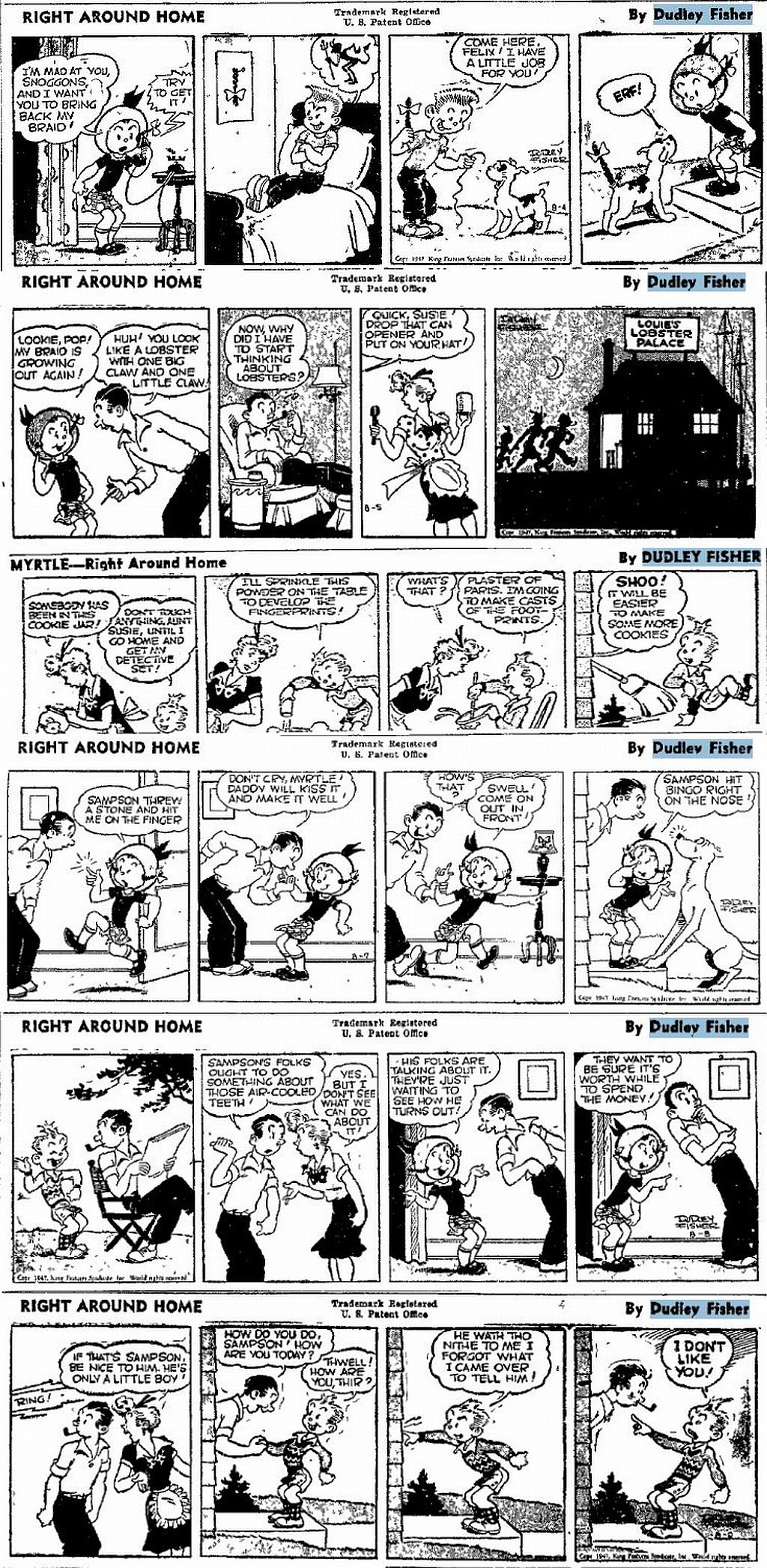 Â In Myrtle (8-4 to 8-9-1947) Snoggons returns Myrtle’s braid VIA Felix the Dog! Sampson’s antics take up the rest of the week. I like the timing on the 8-9, as Sampson first glad-hands Freddie, then (after a pause)Â remembers that he doesn’t like Myrtle’s dad at all! Eventually we will rejoin a clipped run of the strip, but in the meantime Newspaper Archive fills the gaps.
 In Myrtle (8-4 to 8-9-1947) Snoggons returns Myrtle’s braid VIA Felix the Dog! Sampson’s antics take up the rest of the week. I like the timing on the 8-9, as Sampson first glad-hands Freddie, then (after a pause) remembers that he doesn’t like Myrtle’s dad at all! Eventually we will rejoin a clipped run of the strip, but in the meantime Newspaper Archive fills the gaps.
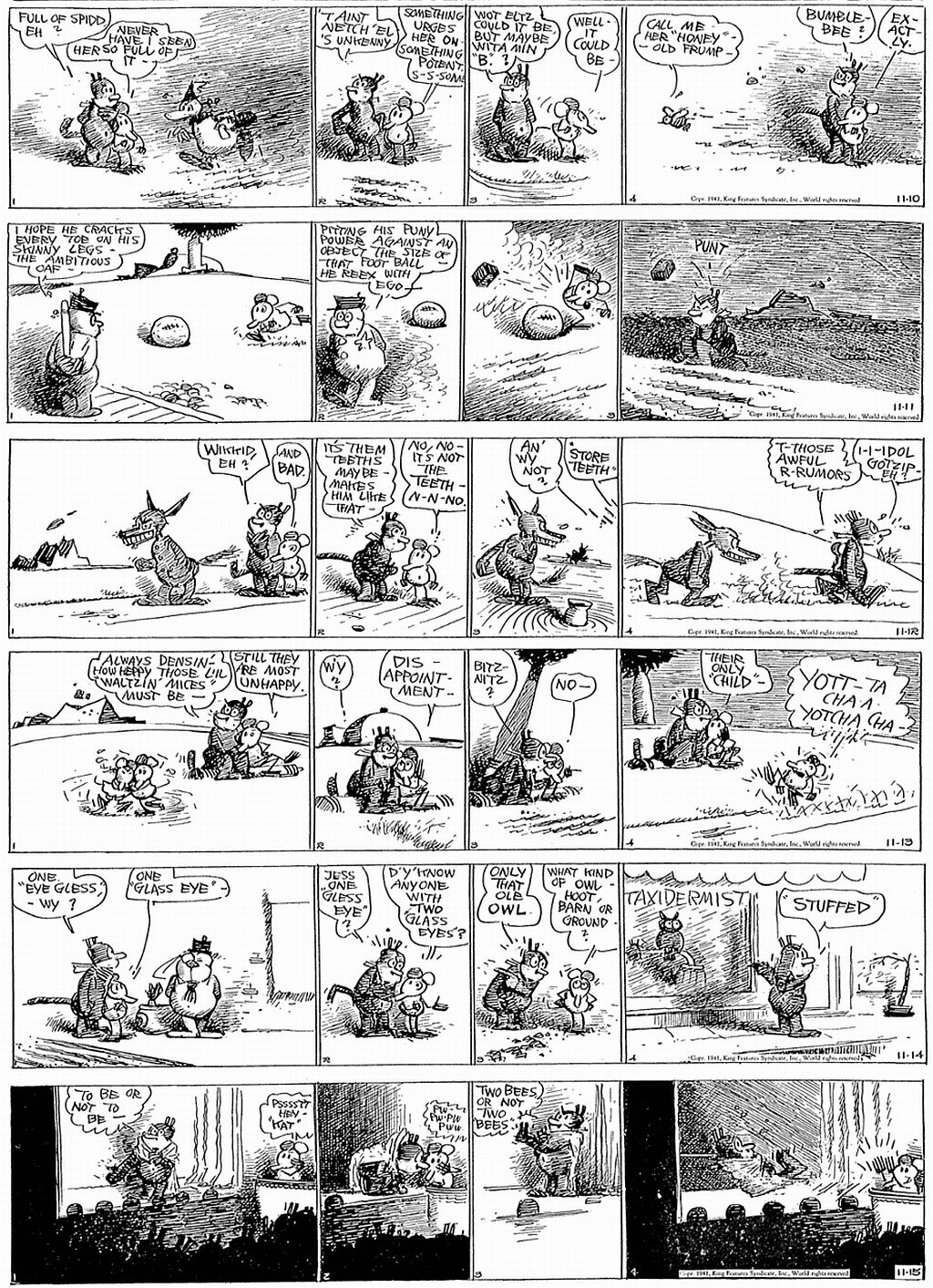 Â Our favorite Herriman Kat (11/10 to 11/15/1941) entertains us with his “Kat Langwidtch”, especially in the 11/10, as he talks about “Wita Min B” versus a Bumble Bee, and in the 11-15 as Bees re-enter the dialog, Shakespeare fashion. The 11/13 is an early 1940s gag, as two Waltzing Mice have a “Jiving” child. The 11/14 gag about the Owl (“Hoot, Barn or Ground?” “Stuffed.”) might have been influenced by the Bob Hope radio show and his exchanges with Jerry Colonna (“Hank, Planked or Cranked?” “Yanked.”)
 Our favorite Herriman Kat (11/10 to 11/15/1941) entertains us with his “Kat Langwidtch”, especially in the 11/10, as he talks about “Wita Min B” versus a Bumble Bee, and in the 11-15 as Bees re-enter the dialog, Shakespeare fashion. The 11/13 is an early 1940s gag, as two Waltzing Mice have a “Jiving” child. The 11/14 gag about the Owl (“Hoot, Barn or Ground?” “Stuffed.”) might have been influenced by the Bob Hope radio show and his exchanges with Jerry Colonna (“Hank, Planked or Cranked?” “Yanked.”)
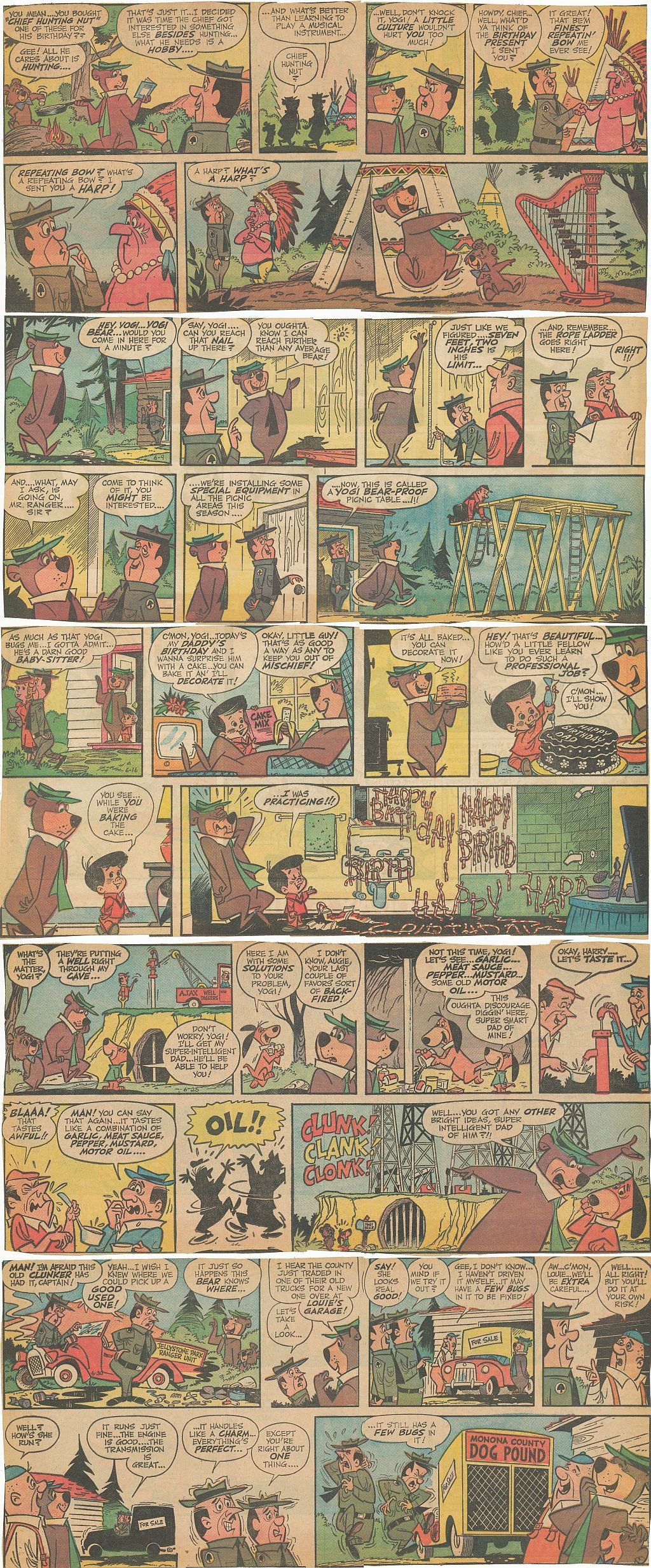  The Yogi Bear Sundays from June, 1963, all feature the wonderful art of Harvey Eisenberg, who drew the early Hanna-Barbera characters as well or better than anyone. I especially like the 6-25, as Yogi can’t remember which dog is Augie or Doggy Daddy. Yogi uncharacteristically loses his cool with Doggy Daddy as they drill for oil inside his cave (in a 1960s National Park? Of course now it’s OK to Frack in a National Park, right?). The little boy who is an expert at toothpaste squeezing in the 6/16, looks like a Gene Hazelton design. Yowp will no doubt have the half-page versions of these comics coming soon over at his blog. Watch for them there.
 The Yogi Bear Sundays from June, 1963, all feature the wonderful art of Harvey Eisenberg, who drew the early Hanna-Barbera characters as well or better than anyone. I especially like the 6-25, as Yogi can’t remember which dog is Augie or Doggy Daddy. Yogi uncharacteristically loses his cool with Doggy Daddy as they drill for oil inside his cave (in a 1960s National Park? Of course now it’s OK to Frack in a National Park, right?). The little boy who is an expert at toothpaste squeezing in the 6/16, looks like a Gene Hazelton design. Yowp will no doubt have the half-page versions of these comics coming soon over at his blog. Watch for them there.
Thanks for the comments on “There Must Be Some Other Cat” and it’s ASIFA-EAST honor. If there’s any more news, you’ll hear it here or over at Itza Cat’s Facebook page.
Your Comics Page-So Long Nebbishes and “Cat” news!!
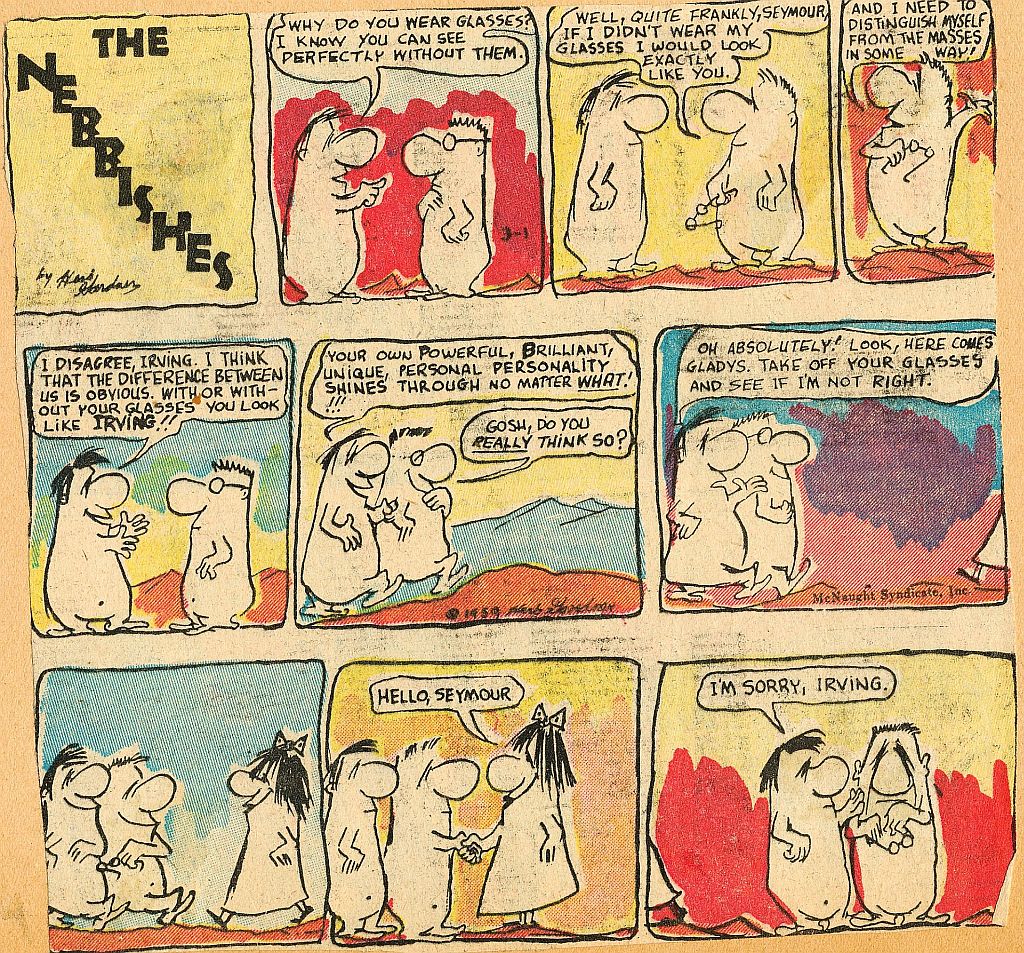  Here’s the only other example of Herb Gardner’s “The Nebbishes” I could find for now. It’s the episode of March 1st, 1959, which could be titled “Irving’s identity crisis”. Irving takes off his glasses and Gladys (who knows both Irving and Seymour) mistakes him for Seymour. The gag builds upon Irving’s declaration in the third panel that he must “distinguish myself from the masses in some way”. If I find any more of these pages I’ll run them here. I would love to see these available in book form, but “The Nebbishes” are a forgotten chapter in comics history and a collection probably wouldn’t sell. So back on the dusty shelf they go.
 Here’s the only other example of Herb Gardner’s “The Nebbishes” I could find for now. It’s the episode of March 1st, 1959, which could be titled “Irving’s identity crisis”. Irving takes off his glasses and Gladys (who knows both Irving and Seymour) mistakes him for Seymour. The gag builds upon Irving’s declaration in the third panel that he must “distinguish myself from the masses in some way”. If I find any more of these pages I’ll run them here. I would love to see these available in book form, but “The Nebbishes” are a forgotten chapter in comics history and a collection probably wouldn’t sell. So back on the dusty shelf they go.
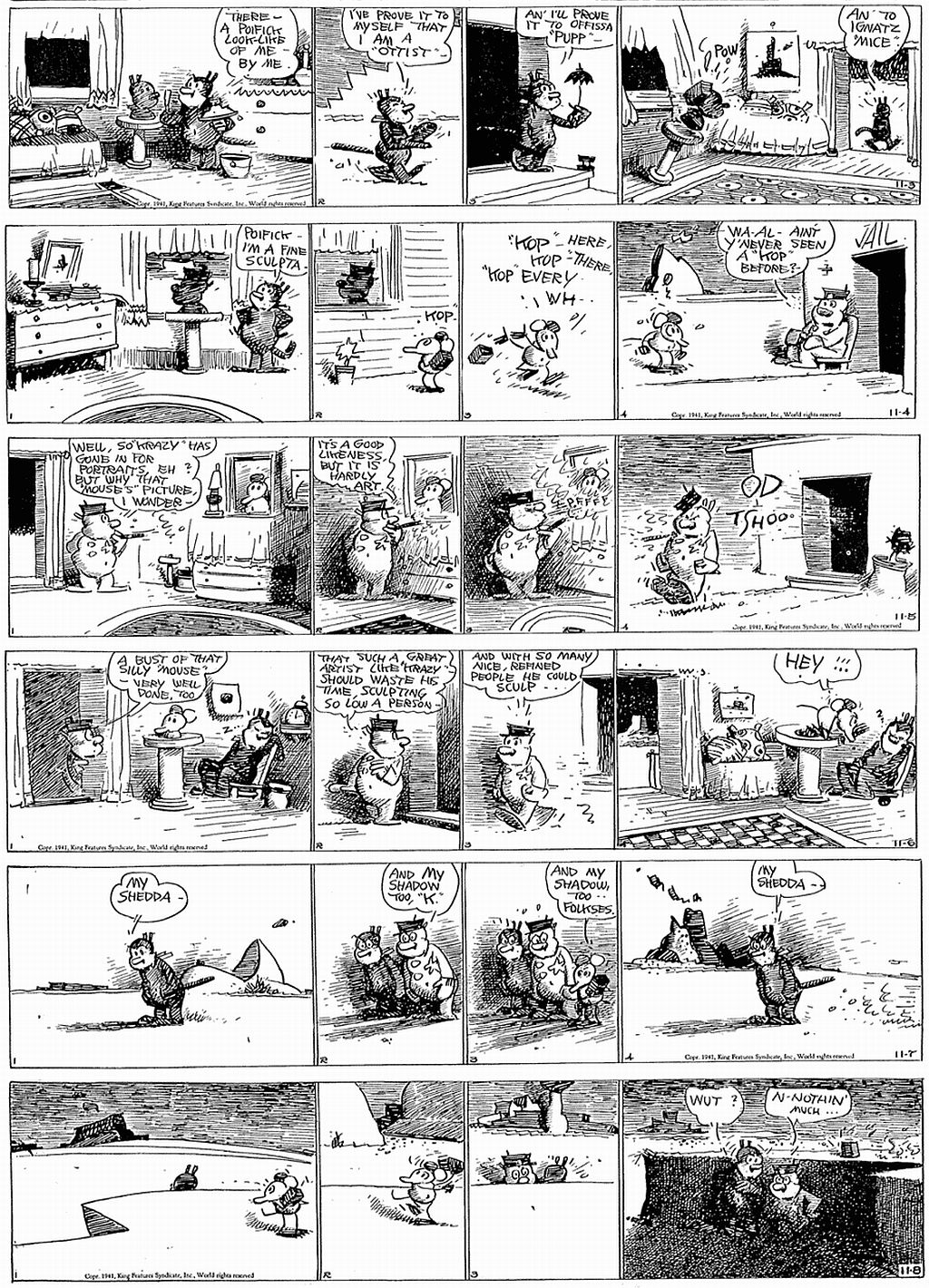 Â Krazy from 11-3 to 11-8-1941, uses the first four strips to do a little continuity about Krazy’s ambition to be a sculptor. He does a bust of himself and a bust of Offissa Pupp, but the bust of Ignatz proves to be just…a bust. The balance of the week’s strips involve shadows and silhouettes. My favorite drawing of the week is the last panel of the 11-5 as Offissa Pupp react’s to Ignatz’s sneeze. The scratchy pen line really has movement to it; Pupp’s cigar is just a few lines hanging in the air.
 Krazy from 11-3 to 11-8-1941, uses the first four strips to do a little continuity about Krazy’s ambition to be a sculptor. He does a bust of himself and a bust of Offissa Pupp, but the bust of Ignatz proves to be just…a bust. The balance of the week’s strips involve shadows and silhouettes. My favorite drawing of the week is the last panel of the 11-5 as Offissa Pupp react’s to Ignatz’s sneeze. The scratchy pen line really has movement to it; Pupp’s cigar is just a few lines hanging in the air.
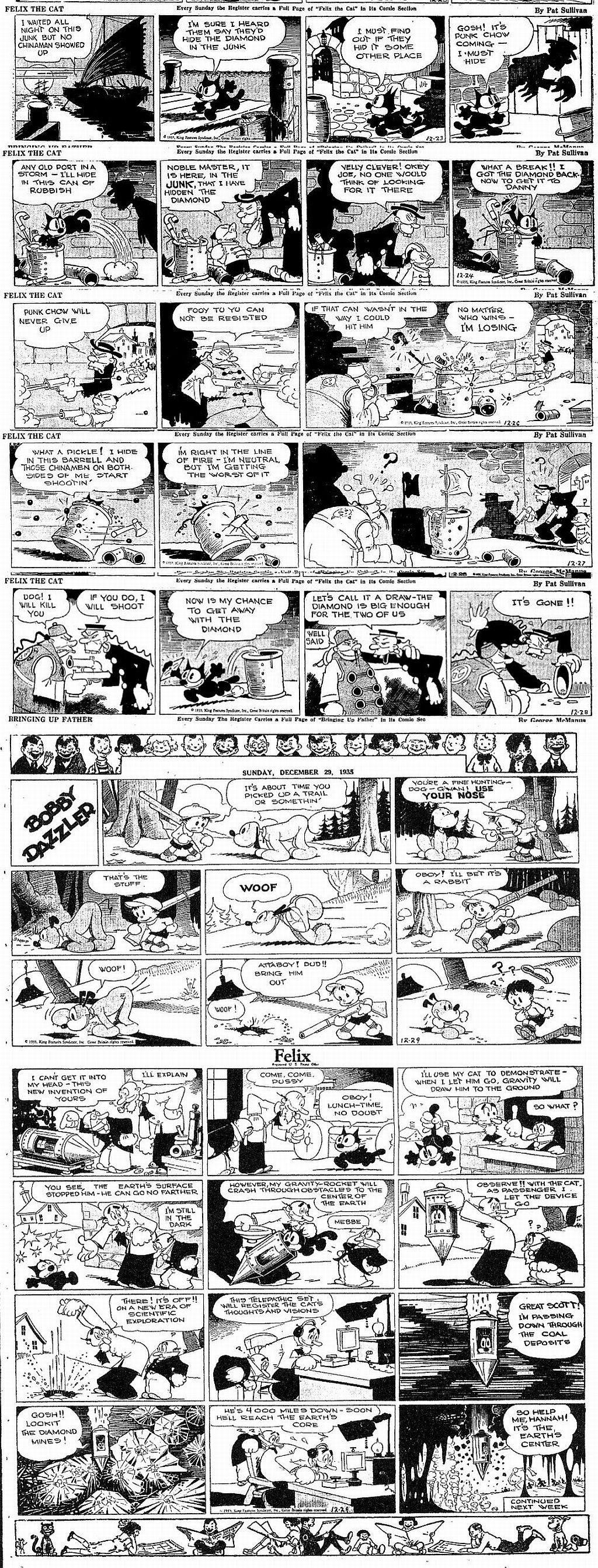 Â Felix is from 12-23 to 12-29-1935 this time. Felix is caught between the guns of Fooy Tu Yu and Punk Chow as he hides in the “junk” ashcan with his precious diamond. Felix gets away before the Chinese bad guys spot him. In the Sunday, we have part one of a fanciful story of Felix’s descent into the substrata of the Earth by “Gravity-Rocket”. Felix’s old friend (?) the chemical scientist, puts him into his new rocket as a reluctant experimental animal. If you want to see what Felix found underground, go into the blog archives and find “Time Trifles With Felix”, August 8th, 2010 for the 1-6-1936 Sunday. We’ll fill in the last dailies of 1935 next time.
 Felix is from 12-23 to 12-29-1935 this time. Felix is caught between the guns of Fooy Tu Yu and Punk Chow as he hides in the “junk” ashcan with his precious diamond. Felix gets away before the Chinese bad guys spot him. In the Sunday, we have part one of a fanciful story of Felix’s descent into the substrata of the Earth by “Gravity-Rocket”. Felix’s old friend (?) the chemical scientist, puts him into his new rocket as a reluctant experimental animal. If you want to see what Felix found underground, go into the blog archives and find “Time Trifles With Felix”, August 8th, 2010 for the 1-6-1936 Sunday. We’ll fill in the last dailies of 1935 next time.
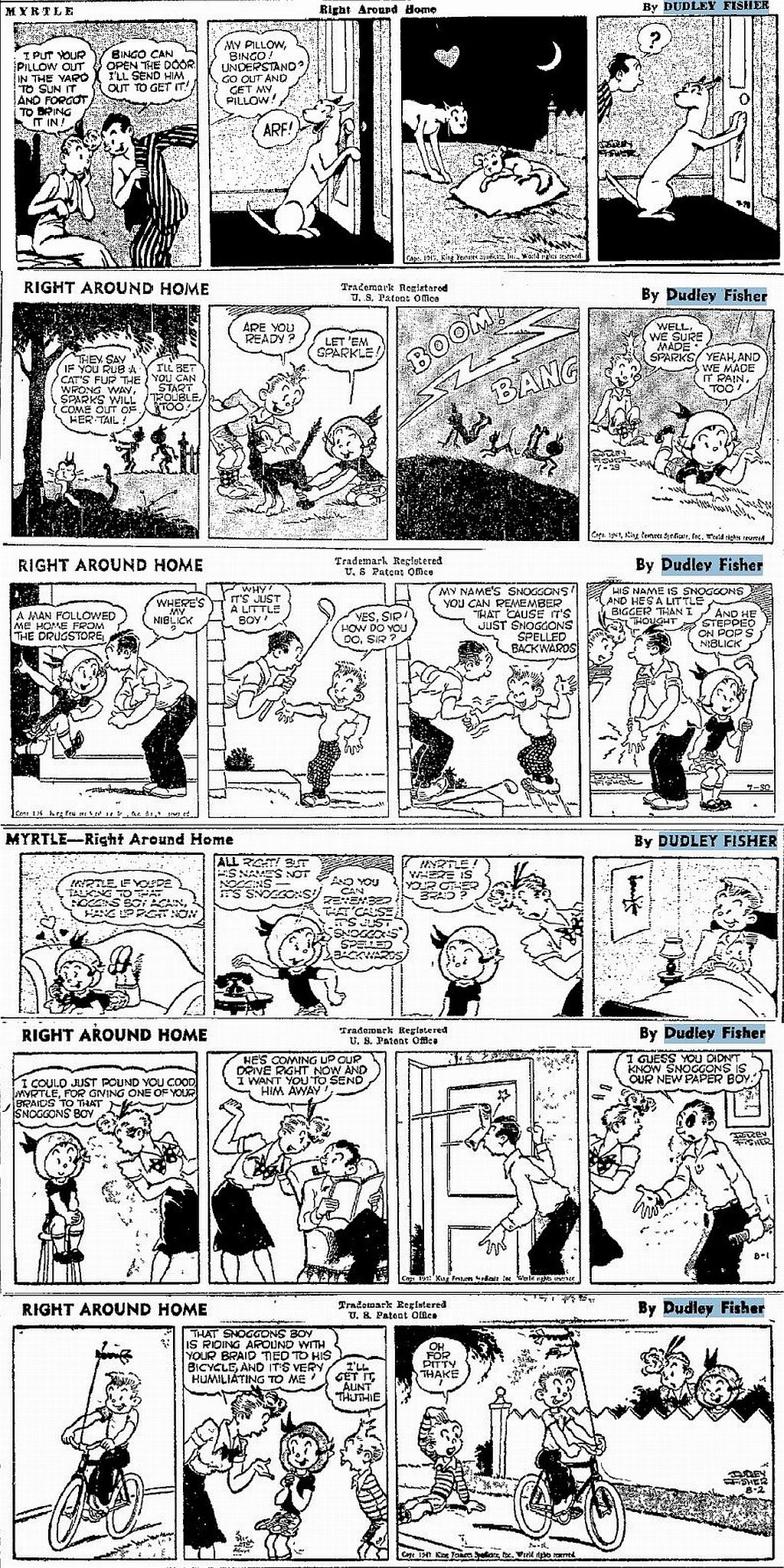 Â Myrtle is here, from 7-28 to 8-2-1947. A new boy joins the cast named “Snoggons”, his name reads the same way backwards or forwards. He snips off one of Myrtle’s braids and makes a wall hanging and a bike tassel out of it. When Sampson tries to avenge the theft of the braid, Snoggons takes off Sampson’s top-knot! I like the 7-28 gag, which continues Bingo’s facility with opening doors. Bingo is supposed to fetch Aunt Susie’s pillow from the back yard, but a sweet little pekingese is asleep on it. Bingo just wordlessly refuses to move the little dog and the idea is expressed by just cutting back to the inside of the house with Bingo closing the door.
 Myrtle is here, from 7-28 to 8-2-1947. A new boy joins the cast named “Snoggons”, his name reads the same way backwards or forwards. He snips off one of Myrtle’s braids and makes a wall hanging and a bike tassel out of it. When Sampson tries to avenge the theft of the braid, Snoggons takes off Sampson’s top-knot! I like the 7-28 gag, which continues Bingo’s facility with opening doors. Bingo is supposed to fetch Aunt Susie’s pillow from the back yard, but a sweet little pekingese is asleep on it. Bingo just wordlessly refuses to move the little dog and the idea is expressed by just cutting back to the inside of the house with Bingo closing the door.
We took second prize in the ASIFA East Competition for Independent Shorts! That’s in New York City, folks! If you can make it there you can make it anywhere! We are now the Avis Rent-A-Car of cartoon shorts, we’re number two, so we’ll try harder! Congrats and love to all our stalwarts who made the cartoon possible, Greg Ford, Kim Miskoe, Igor, Ronnie Scheib, Cathy Hill and many more! I think we can safely say that this cartoon is the very LAST cel-animated analog production in the USA!! We’ve thrown down the cat-gut, no other cartoon producer can make that statement!
Your Comics Page-Herb Gardner Tribute Continues
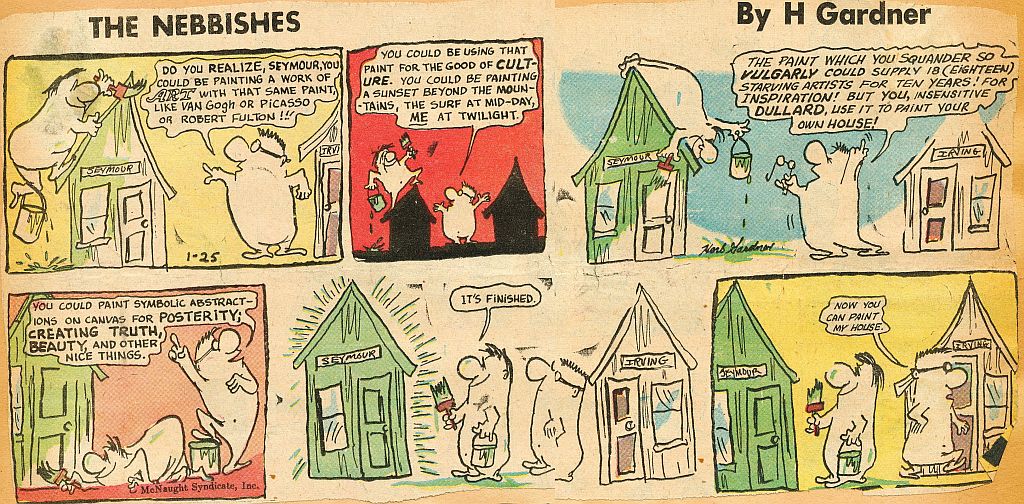 Â Here are the next two weeks of “The Nebbishes” by Herb Gardner (called “Hy” or “H” by the St. Louis Post-Dispatch). Herb tends to go for big emotional displays followed by a sarcastic understatement that renders those displays moot. I love the Devil’s big show of confidence as he tries to barter for Seymour and Irving’s souls in the 1-18-59 strip and how Irving goes on a binge of artistic blather in the 1-25-59 as Seymour paints his house (“..creating truth, beauty and other nice things.”) There is a bit of parallel with Max Shulman’s writing on “Dobie Gillis” (just starting on TV in 1959), as Dobie often waxes poetic and seeks truth and beauty. Maybe Gardner and Shulman knew each other or drew from the same wellspring of comedy. I’ll look around for more of these old “Nebbishes”. When I was a kid I didn’t know from Jewish comedians or Yiddish expressions or anything of the kind, but somehow I really dug the comedy of Herb Gardner. The 1-18 page had to be pieced together for this blog, it’s pretty fragile, but well loved.
 Here are the next two weeks of “The Nebbishes” by Herb Gardner (called “Hy” or “H” by the St. Louis Post-Dispatch). Herb tends to go for big emotional displays followed by a sarcastic understatement that renders those displays moot. I love the Devil’s big show of confidence as he tries to barter for Seymour and Irving’s souls in the 1-18-59 strip and how Irving goes on a binge of artistic blather in the 1-25-59 as Seymour paints his house (“..creating truth, beauty and other nice things.”) There is a bit of parallel with Max Shulman’s writing on “Dobie Gillis” (just starting on TV in 1959), as Dobie often waxes poetic and seeks truth and beauty. Maybe Gardner and Shulman knew each other or drew from the same wellspring of comedy. I’ll look around for more of these old “Nebbishes”. When I was a kid I didn’t know from Jewish comedians or Yiddish expressions or anything of the kind, but somehow I really dug the comedy of Herb Gardner. The 1-18 page had to be pieced together for this blog, it’s pretty fragile, but well loved.
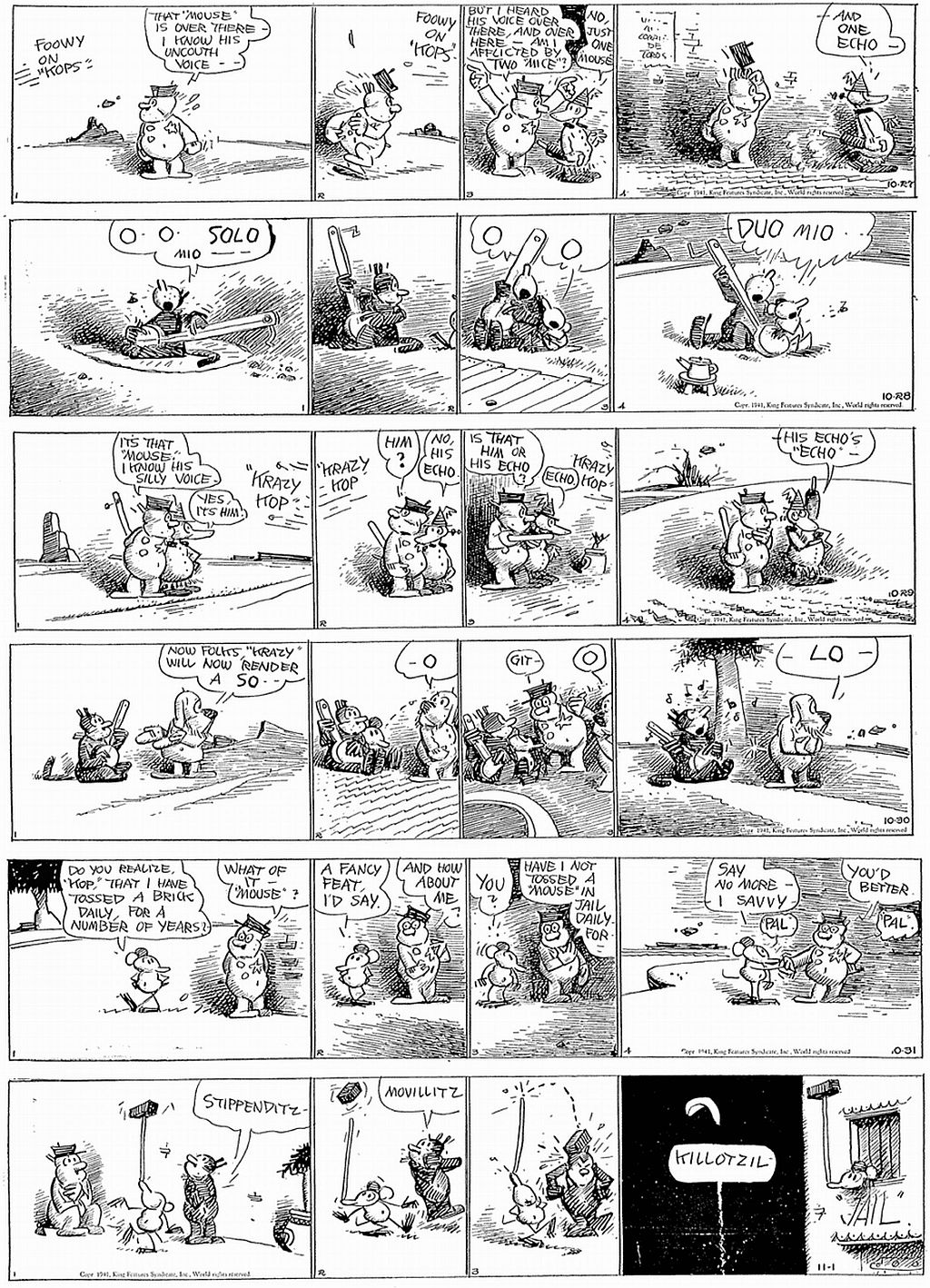  There are two “echo” gags and two gags using the word “solo” in the Krazy Kat week of 10-27 to 11-1-1941. I especially favor the 10-31 strip as Offissa Pupp and Ignatz Mice shake hands as they realize that their animosity is a main driver of the strip in which they live. This idea takes a little of the sting out of all the Jail time that the Mice has had to put up with “for a number of years”.
 There are two “echo” gags and two gags using the word “solo” in the Krazy Kat week of 10-27 to 11-1-1941. I especially favor the 10-31 strip as Offissa Pupp and Ignatz Mice shake hands as they realize that their animosity is a main driver of the strip in which they live. This idea takes a little of the sting out of all the Jail time that the Mice has had to put up with “for a number of years”.
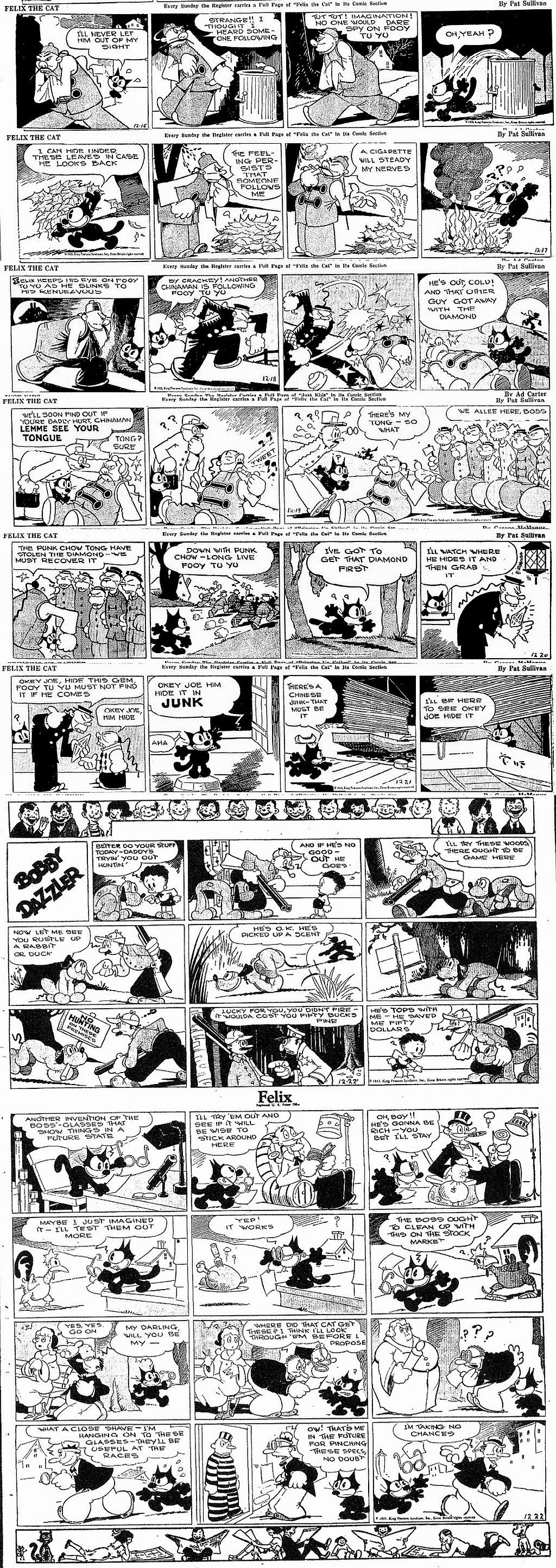  Felix, this time from 12-16 to 12-22-1935, has the Cat in hot pursuit of Fooy Tu Yu. Felix obviously disposed of all that water he swallowed in the previous week’s strips. Fooy Tu Yu is blackjacked by another Chinese who takes the diamond away and gives it to Okey Joe who hides it on a “junk”. See the next post for the conclusion of the 1935 dailies. The Sunday page continues the science fiction aspect of Felix as he experiments with a pair of glasses that enable him to see into the future.
 Felix, this time from 12-16 to 12-22-1935, has the Cat in hot pursuit of Fooy Tu Yu. Felix obviously disposed of all that water he swallowed in the previous week’s strips. Fooy Tu Yu is blackjacked by another Chinese who takes the diamond away and gives it to Okey Joe who hides it on a “junk”. See the next post for the conclusion of the 1935 dailies. The Sunday page continues the science fiction aspect of Felix as he experiments with a pair of glasses that enable him to see into the future.
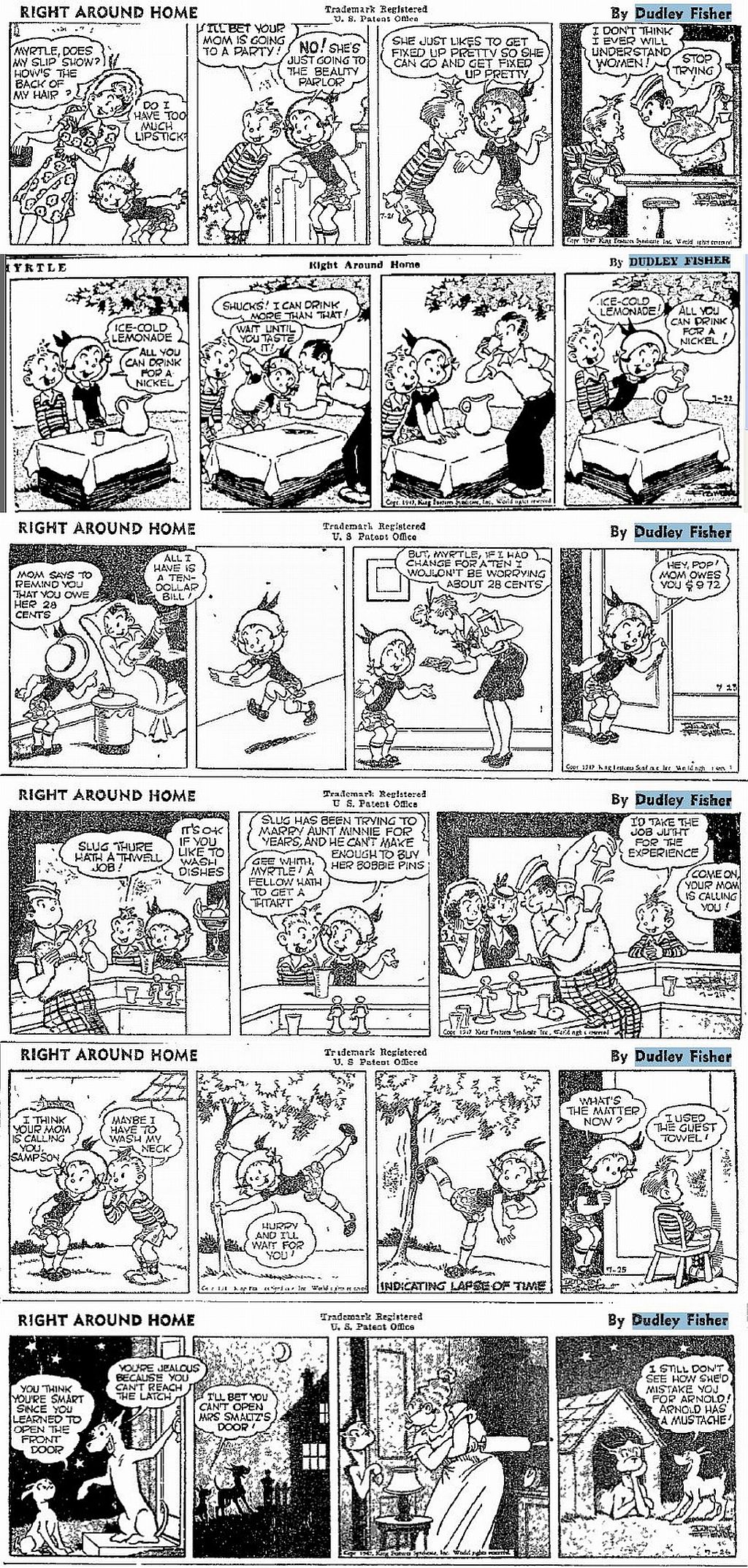 Â In Myrtle this time from 7-21 to 7-26-1947, Fisher shows a mastery of comic strip timing. The strip for 7-22 has a terrific “all you can drink” lemonade gag that dispenses with Pop’s reaction to tasting Myrtle and Sampson’s citrus quencher and just skips to the last panel. Fisher also uses timing to advantage as Sampson goes to his mother’s house to wash his neck and just leaves Myrtle hanging on a tree. In the last panel we find that Sampson used a guest towel to wipe his neck and is banished to a corner. The 7-26 continues the idea that Bingo the dog is good at opening doors; this time he gets a lump on the head for opening the wrong one. We are now into the spate of Myrtle strips culled from Newspaper Archive.com so the quality is only fair.
 In Myrtle this time from 7-21 to 7-26-1947, Fisher shows a mastery of comic strip timing. The strip for 7-22 has a terrific “all you can drink” lemonade gag that dispenses with Pop’s reaction to tasting Myrtle and Sampson’s citrus quencher and just skips to the last panel. Fisher also uses timing to advantage as Sampson goes to his mother’s house to wash his neck and just leaves Myrtle hanging on a tree. In the last panel we find that Sampson used a guest towel to wipe his neck and is banished to a corner. The 7-26 continues the idea that Bingo the dog is good at opening doors; this time he gets a lump on the head for opening the wrong one. We are now into the spate of Myrtle strips culled from Newspaper Archive.com so the quality is only fair.
    The cartoon short that Greg Ford and I made called “There Must Be Some Other Cat” has been selected by a film festival to screen in September. I can’t say which one, but we are thrilled to be accepted.
    I recently read “Al Capp, A Life the the Contrary” by Denis Kitchen and Michael Schumacher” a new biography of one of the USA’s greatest comic strip creators. Elsewhere in this blog, you can find a few “L’il Abner” strip continuities reprinted, including the infamous “Joanie Phonie” story. I’ve been a fan of Al Capp’s strip all my life, I loved reading the strip each night in the St. Louis Post-Dispatch, and when my father didn’t bring home the evening paper, it was hard to hide my disappointment. I always liked the little fantastic characters in the strip, the Schmoos, natcherly, and the Kigmys, the little flying hot-dog shaped creatures of the planet Pincus #7, the Adorable Snowman, the Bald Iggle, and many others. I got a kick out of Big Barnsmell, the head man at the Skonk Works, and of course, Moonbeam McSwine and the gorgeous Daisy Mae. It’s said that Al Capp really didn’t like any of his characters very much. It’s lucky for him that somehow they were sympathetic to his readers. I always felt sorry for the dumb but lovable L’il Abner, and worried about his cliffhanger predicaments enough to want to keep reading about him. In reading about Capp’s sexual misadventures in the 1960s on college campuses, including his mistreatment of Goldie Hawn, Mark Evanier (world’s champeen blogger) feels uncomfortable even reading old L’il Abner stories knowing that Al Capp could be a pervert. I can’t defend Capp, but I look at his creation as a satirical fantasy unlike any other comic strip and will always enjoy it. Al Capp’s depression era background and his loss of a leg as a boy certainly colored his world view and his strip. He lived life as if he always had something to prove, and he’d do it by hook or crook. (Wait until you read how he got through art school!) “Li’l Abner” was an unapologetic bold slash of a comic strip, blending fantasy with satire. The drawing was both serenely slapstick and delicately sensuous, drawn with beautiful pen lines. Mark Evanier even got to MEET Al Capp, something I would have loved to have done. This book is a very thorough biography, I learned a great deal from it. Some of the most interesting stuff is in the notes at the back of the book. I’ve always wondered from where Capp’s comic book company, “Toby Press” got it’s name. The notes informed me that “Toby” was the name of one of Elliot Caplin’s daughters. Elliot Caplin was one of Al Capp’s brothers and wrote many comic strips, including “The Heart of Juliet Jones” and “Long Sam”, both strips about beautiful women. Toby eventually took over the writing on “The Heart of Juliet Jones” after Elliot retired. Too bad they didn’t put the story of how Felix the Cat and Otto Messmer got picked up by Toby Press after their Dell Comics run. Again, this book is highly recommended, even though it may sour some fans on Al Capp, like it did for Mark Evanier. Now, won’t some brave soul step up and reprint the rest of “L’il Abner” through the final strip? I would love to read all the “conservative” strips that caused so many newspapers to drop Abner. Let’s get Roger Ailes to do something meaningful with his life and foot the bill for reprinting these strips!
Your Comics Page 5-1-2013 with “The Nebbishes”
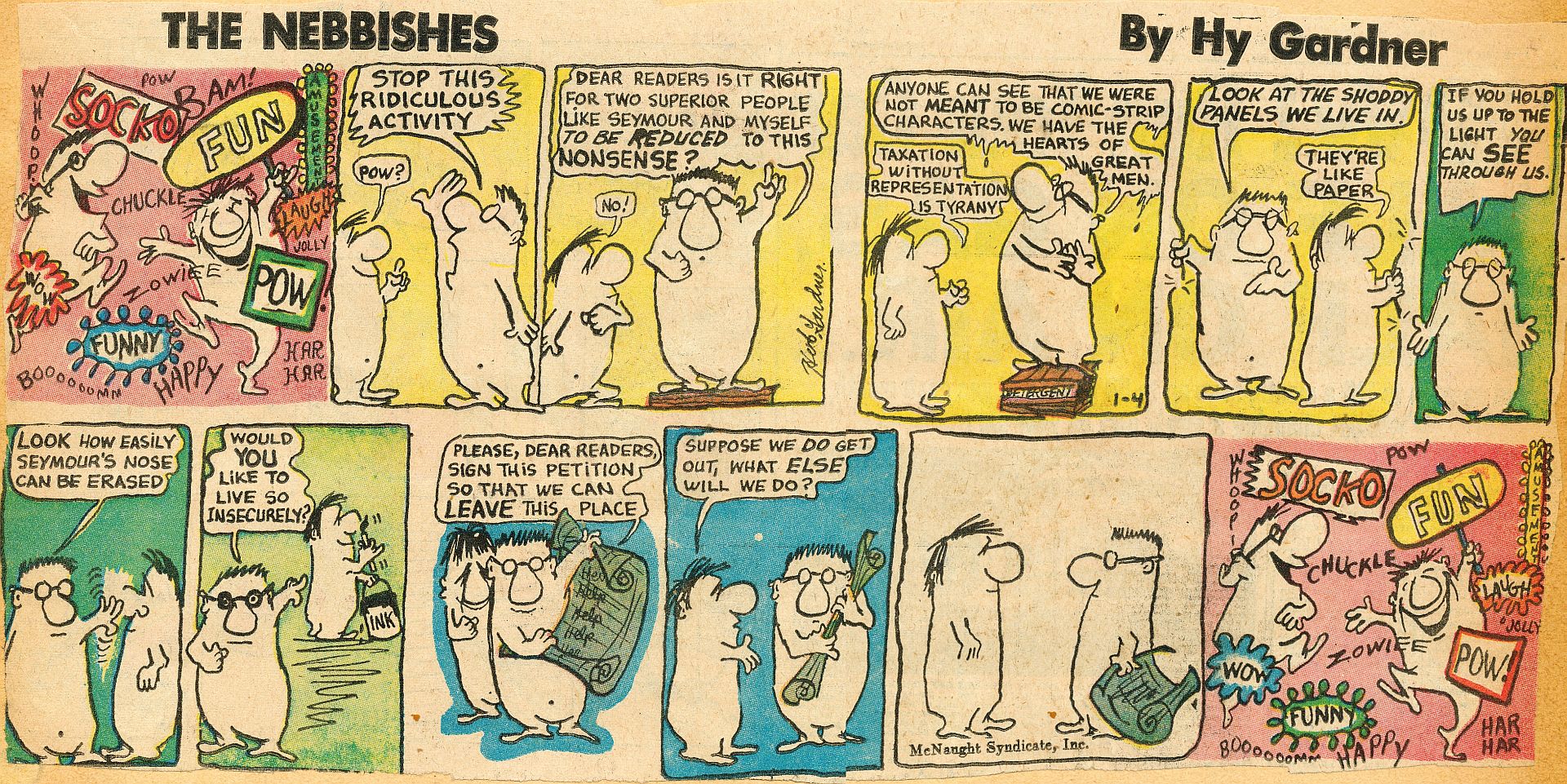
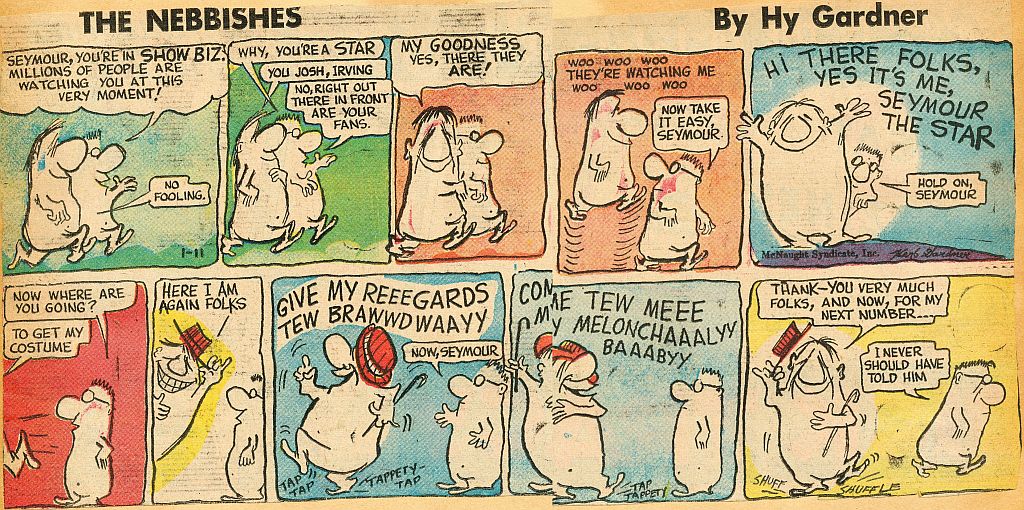 Hi There! We lead off with the first two Sunday pages of Herb Gardner’s “The Nebbishes” from 1-4 and 1-11-1959. This comic strip was an early venture of Mr. Gardner. He is best known today for his play/movie “A Thousand Clowns” featuring Jason Robards. Some web pages say that his strip “The Nebbishes” (Yiddish for “Nobodies”), started in 1954 and was distributed by the Chicago Tribune/New York News syndicate. Allan Holtz’s book says that 1-4-59 was the first one. The Nebbishes only lasted until 1961, and was only carried for the first few months of that run by the St. Louis Post-Dispatch. My copies are from those dates, and were pasted on highly acid old scrapbook pages, so I had to gently piece them together for the scanner. I love the adventures of Irving and Seymour. I always thought they were cousins of “Flebus” and “Mr. Moo”, essentially walking heads with white, squared-off bodies. The first two strips break the fourth wall to smithereens. Irving is very aware that he and Seymour are trapped in a comic strip. I love how Seymour reacts like the early Daffy Duck in the 1-11, when he realizes he’s being watched (woo woo woo). I found these strips to be quite funny when they first were printed, still do. The Nebbish statues were very popular in greeting card shops of the day (you find them on Ebay now) and the famous Nebbish sign (“One of these days we’ve just GOT to get organized”) was also a best-seller. According to the websites, Herb Gardner opted out of all this lucrative cartooning and decided to become a playwright instead, producing his classic “A Thousand Clowns” in 1961. The dialog in “The Nebbishes” became so dominant that the balloons nearly crowded out Irving and Seymour. If speech was so important, reasoned Herb Gardner, then why not write dialog all the time? His biggest commercial hit play was “I’m Not Rappaport” in 1985 (movie in 1996). Herb also wrote and produced the movie “Who is Harry Kellerman, and why is he saying those terrible things about me?” in 1971, starring Dustin Hoffman. In 1987, Gardner appeared in the historic big budget flop movie “Ishtar” as Rabbi Pierce. He passed on in 2003. I have very few examples of “The Nebbishes” put I’m happy to scan the ones that are still with me and put them up here.
Hi There! We lead off with the first two Sunday pages of Herb Gardner’s “The Nebbishes” from 1-4 and 1-11-1959. This comic strip was an early venture of Mr. Gardner. He is best known today for his play/movie “A Thousand Clowns” featuring Jason Robards. Some web pages say that his strip “The Nebbishes” (Yiddish for “Nobodies”), started in 1954 and was distributed by the Chicago Tribune/New York News syndicate. Allan Holtz’s book says that 1-4-59 was the first one. The Nebbishes only lasted until 1961, and was only carried for the first few months of that run by the St. Louis Post-Dispatch. My copies are from those dates, and were pasted on highly acid old scrapbook pages, so I had to gently piece them together for the scanner. I love the adventures of Irving and Seymour. I always thought they were cousins of “Flebus” and “Mr. Moo”, essentially walking heads with white, squared-off bodies. The first two strips break the fourth wall to smithereens. Irving is very aware that he and Seymour are trapped in a comic strip. I love how Seymour reacts like the early Daffy Duck in the 1-11, when he realizes he’s being watched (woo woo woo). I found these strips to be quite funny when they first were printed, still do. The Nebbish statues were very popular in greeting card shops of the day (you find them on Ebay now) and the famous Nebbish sign (“One of these days we’ve just GOT to get organized”) was also a best-seller. According to the websites, Herb Gardner opted out of all this lucrative cartooning and decided to become a playwright instead, producing his classic “A Thousand Clowns” in 1961. The dialog in “The Nebbishes” became so dominant that the balloons nearly crowded out Irving and Seymour. If speech was so important, reasoned Herb Gardner, then why not write dialog all the time? His biggest commercial hit play was “I’m Not Rappaport” in 1985 (movie in 1996). Herb also wrote and produced the movie “Who is Harry Kellerman, and why is he saying those terrible things about me?” in 1971, starring Dustin Hoffman. In 1987, Gardner appeared in the historic big budget flop movie “Ishtar” as Rabbi Pierce. He passed on in 2003. I have very few examples of “The Nebbishes” put I’m happy to scan the ones that are still with me and put them up here.
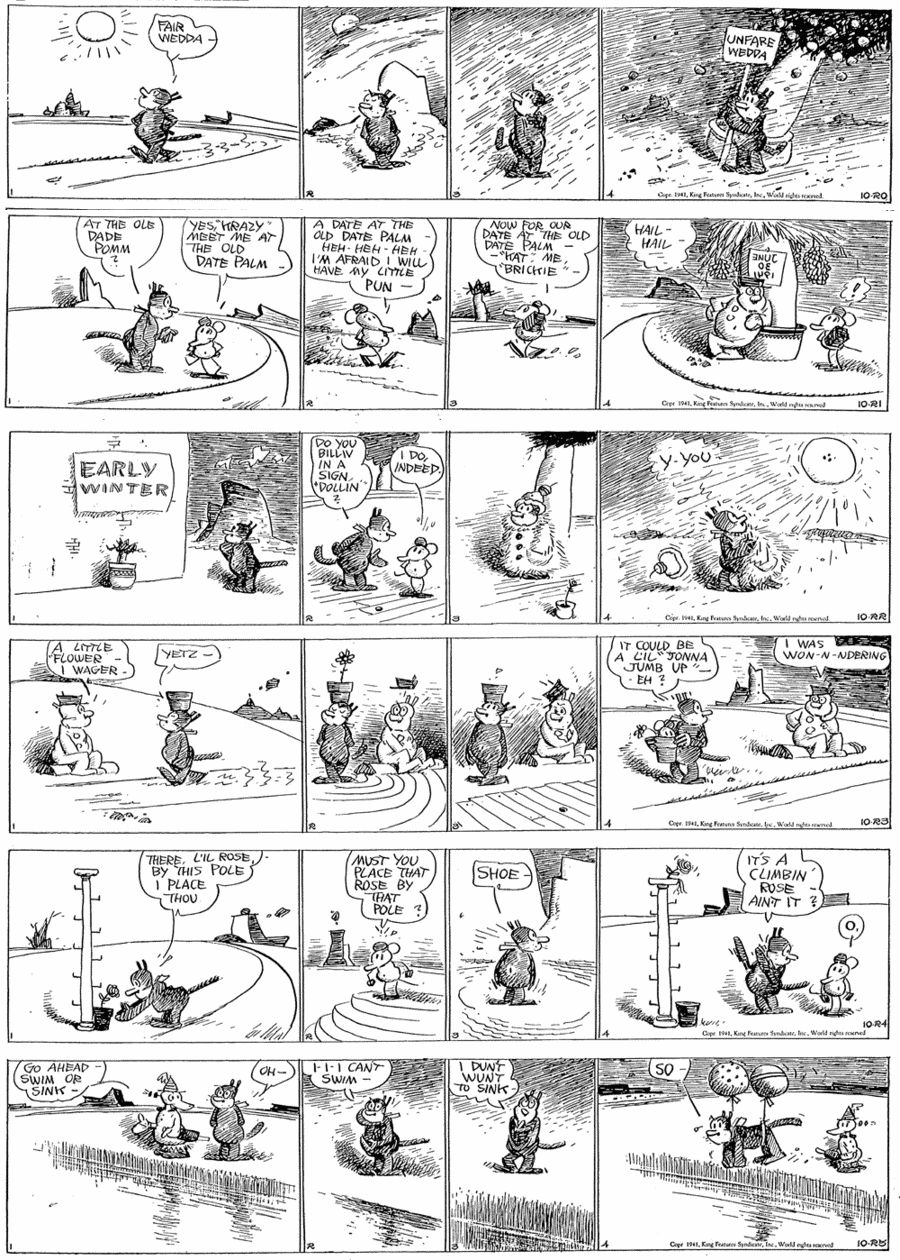  There is a mystery in the Krazy Kat dailies of 10-20 to 10-26-1941. In the 10-21, why does Offissa Pupp lie in wait for Ignatz under a date palm with a sign tacked to the tree reading, “June 30 1941” backwards? I consulted the Krazy strip from that date, but it just features Krazy getting a bleach job at a beauty parlor, with no reference to any date palms. So Garge has once again baffled and amused us. In the 10-22, there is a hallmark of Herriman’s writing in Krazy’s annoyed reaction to the Sun, “Y-you..”. He used this stuttered experession many times in Krazy Kat and many of his other comic concoctions.
 There is a mystery in the Krazy Kat dailies of 10-20 to 10-26-1941. In the 10-21, why does Offissa Pupp lie in wait for Ignatz under a date palm with a sign tacked to the tree reading, “June 30 1941” backwards? I consulted the Krazy strip from that date, but it just features Krazy getting a bleach job at a beauty parlor, with no reference to any date palms. So Garge has once again baffled and amused us. In the 10-22, there is a hallmark of Herriman’s writing in Krazy’s annoyed reaction to the Sun, “Y-you..”. He used this stuttered experession many times in Krazy Kat and many of his other comic concoctions.
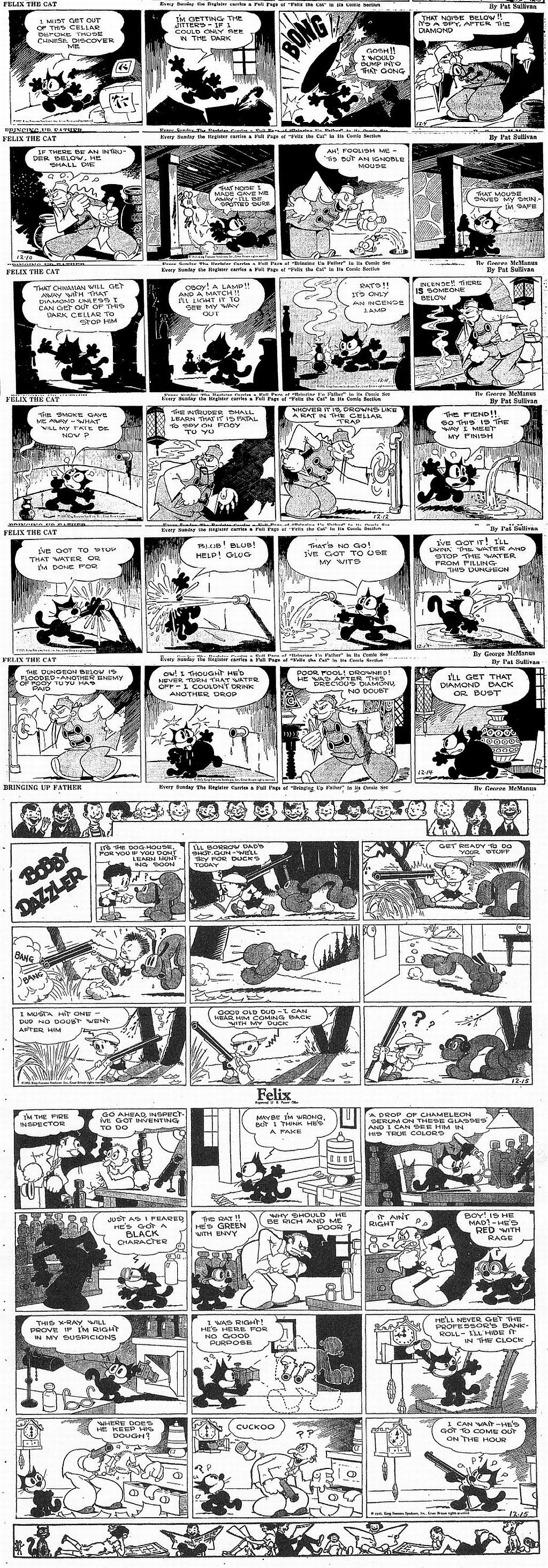 Â Felix continues to attempt to reclaim his diamond in the dailies from 12-9 to 12-14-1935. Fooy tu Yu pours water on Felix as he hides in the basement of Fooy’s hide-out. Felix just drinks all the water to keep from drowning! A very fat, water-logged cat continues to pursue Fooy in the 12-14. In the Sunday page, you’ll have to print it out and color it according to the dialog, to get all the humor out of the Professor’s chameleon serum introduced last time, not to mention the X-Ray camera!
 Felix continues to attempt to reclaim his diamond in the dailies from 12-9 to 12-14-1935. Fooy tu Yu pours water on Felix as he hides in the basement of Fooy’s hide-out. Felix just drinks all the water to keep from drowning! A very fat, water-logged cat continues to pursue Fooy in the 12-14. In the Sunday page, you’ll have to print it out and color it according to the dialog, to get all the humor out of the Professor’s chameleon serum introduced last time, not to mention the X-Ray camera!
 Â Myrtle, from 7-14 to 7-19-1947 has two gags revolving around Bingo’s ability to open doors, but for me the funniest one this time is Freddie’s devilish reaction in the third panel of the 7-15 as he hits upon a way to stop Sampson from annoying him with his bad harmonica playing.
 Myrtle, from 7-14 to 7-19-1947 has two gags revolving around Bingo’s ability to open doors, but for me the funniest one this time is Freddie’s devilish reaction in the third panel of the 7-15 as he hits upon a way to stop Sampson from annoying him with his bad harmonica playing.
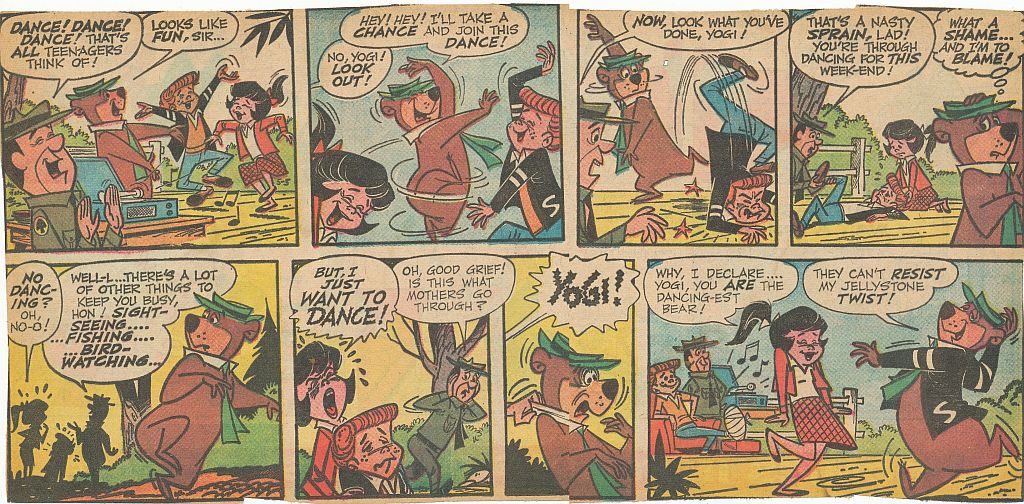


  In anticipation of Yowp’s blog, we have the May, 1963 Yogi Bear Sunday pages, all thirds this time. I think the funniest gag is the 5-12, in which all the restaurants in town that feature “All you can eat” specials close down after Yogi and Boo-Boo patronize them. Yogi, Boo-Boo and Ranger Smith all seem to be drawn by Harvey Eisenberg, but the teenagers in the 5-5 and the little Boy Scouts in the 5-19 look like Gene Hazelton. Only Jerry Eisenberg would know for sure, and he doesn’t read this blog! Remember to CLICK ON THE THUMBNAILS if you want to display any of the comics full screen. Keep visiting https://www.facebook.com/someothercat to see the complete storyboard from “There Must Be Some Other Cat” one page at a time, courtesy of our webmaster, Charles Brubaker.
 In anticipation of Yowp’s blog, we have the May, 1963 Yogi Bear Sunday pages, all thirds this time. I think the funniest gag is the 5-12, in which all the restaurants in town that feature “All you can eat” specials close down after Yogi and Boo-Boo patronize them. Yogi, Boo-Boo and Ranger Smith all seem to be drawn by Harvey Eisenberg, but the teenagers in the 5-5 and the little Boy Scouts in the 5-19 look like Gene Hazelton. Only Jerry Eisenberg would know for sure, and he doesn’t read this blog! Remember to CLICK ON THE THUMBNAILS if you want to display any of the comics full screen. Keep visiting https://www.facebook.com/someothercat to see the complete storyboard from “There Must Be Some Other Cat” one page at a time, courtesy of our webmaster, Charles Brubaker.
Your Comics Page 4-16-2013
  In Krazy this time from 10-13 to 10-18-1941, Garge is just doing separate gags for each day. The 10-17 may or not be related to the 10-16, as Krazy tries to call a “chimp”, a “chump”. The 10-17 has Krazy, Ignatz and Offissa Pupp trotting along singing “Chup, Chup, Chup, etc.”, may have been an extension of the “chimp, chump” idea, or it could be a salute to the Andrews Sisters’ #5 hit of 1939, “Well Alright!” in which the sisters sing “Well Alright, well chop, chop, chop, well alright..”. They repeat the “chop, chop” refrain throughout the record. Perhaps Garge heard the tune on the radio and worked it into the strip, just a theory. The 10-18 strip shows just into how few panels the “Krazy, Ignatz, Brick, Jail” formula could be distilled. All we have to see is Offissa Pupp looking out to the Coconino horizon through field glasses, then cut to Ignatz in the cell.
 In Krazy this time from 10-13 to 10-18-1941, Garge is just doing separate gags for each day. The 10-17 may or not be related to the 10-16, as Krazy tries to call a “chimp”, a “chump”. The 10-17 has Krazy, Ignatz and Offissa Pupp trotting along singing “Chup, Chup, Chup, etc.”, may have been an extension of the “chimp, chump” idea, or it could be a salute to the Andrews Sisters’ #5 hit of 1939, “Well Alright!” in which the sisters sing “Well Alright, well chop, chop, chop, well alright..”. They repeat the “chop, chop” refrain throughout the record. Perhaps Garge heard the tune on the radio and worked it into the strip, just a theory. The 10-18 strip shows just into how few panels the “Krazy, Ignatz, Brick, Jail” formula could be distilled. All we have to see is Offissa Pupp looking out to the Coconino horizon through field glasses, then cut to Ignatz in the cell.
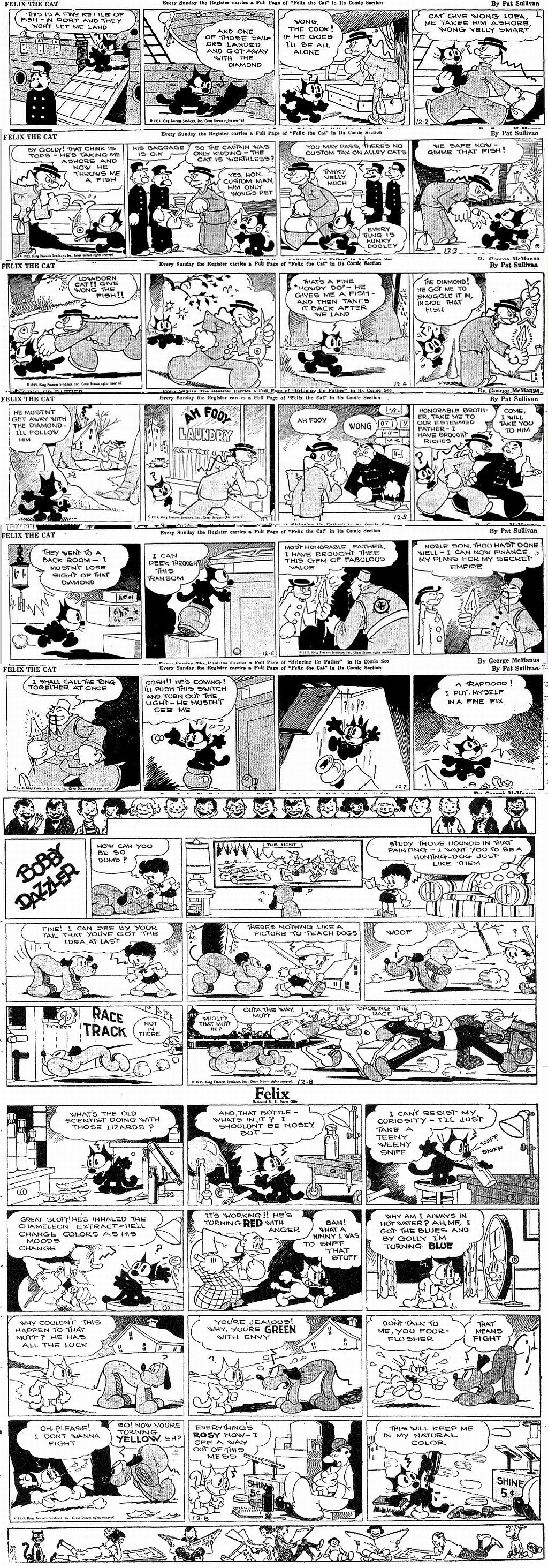 Â In Felix, from 12-2 to 12-8-1935, Felix is at last smuggled ashore by Wong, the ship’s cook. Wong also manages to come up with Felix’s diamond, smuggled on land inside a fish! At last we meet Ah Fooy, the Tong leader who figures in much of the 1936 dailies. He’s more than happy to use the diamond to finance plans for his secret empire, Sax Rohmer would have been proud. In the Sunday, Felix inhales some Chameleon extract in the Professor’s lab and acquires the ability to change color with his mood. Now everybody, print the page out and color Felix according to the script, I’ll bet you’ll get better results than most papers of 1935 could come up with!
 In Felix, from 12-2 to 12-8-1935, Felix is at last smuggled ashore by Wong, the ship’s cook. Wong also manages to come up with Felix’s diamond, smuggled on land inside a fish! At last we meet Ah Fooy, the Tong leader who figures in much of the 1936 dailies. He’s more than happy to use the diamond to finance plans for his secret empire, Sax Rohmer would have been proud. In the Sunday, Felix inhales some Chameleon extract in the Professor’s lab and acquires the ability to change color with his mood. Now everybody, print the page out and color Felix according to the script, I’ll bet you’ll get better results than most papers of 1935 could come up with!
  In Myrtle this time, (7-7 to 7-12-1947) Bingo stars in four strips. My favorite is the 7-9, where the fierce guard dog is supposed to chase the book salesman away, but winds up buying two pawloads of books! I remember the days of the door-to-door salesmen very vividly from childhood. In St. Louis in 1949 to 1954, we still had salesmen coming to the door with encyclopedias, as well as junkmen with horse-drawn wagons trying to pick up refuse cheap! They were the original “recyclers”. Photographers sometimes came around our house with a pony and a little cowboy outfit. My Mom fell for their line, and a photograph exists of my brother and I on ponies with cowboy hat, chaps and pistols. You’ll never see the likes of those photographers coming to your door anymore, now all we seem to get is Jehovah’s Witnesses! To get back to the strip, Freddie’s smelly pipe opens and closes the week, as Bingo admires Pop’s ability to smoke the darn thing in the 7-7, and a pipe cleaner (very cartoony idea) rebels at cleaning the offending calabash in the 7-12. The image quality of the Myrtles will dip a bit in the following weeks, as my run of original clipped dailies runs out. I have to substitute the missing strips from Newspaper Archive, and the quality is mostly on the down side. We’ll see you soon with more favorites from old newspapers.
 In Myrtle this time, (7-7 to 7-12-1947) Bingo stars in four strips. My favorite is the 7-9, where the fierce guard dog is supposed to chase the book salesman away, but winds up buying two pawloads of books! I remember the days of the door-to-door salesmen very vividly from childhood. In St. Louis in 1949 to 1954, we still had salesmen coming to the door with encyclopedias, as well as junkmen with horse-drawn wagons trying to pick up refuse cheap! They were the original “recyclers”. Photographers sometimes came around our house with a pony and a little cowboy outfit. My Mom fell for their line, and a photograph exists of my brother and I on ponies with cowboy hat, chaps and pistols. You’ll never see the likes of those photographers coming to your door anymore, now all we seem to get is Jehovah’s Witnesses! To get back to the strip, Freddie’s smelly pipe opens and closes the week, as Bingo admires Pop’s ability to smoke the darn thing in the 7-7, and a pipe cleaner (very cartoony idea) rebels at cleaning the offending calabash in the 7-12. The image quality of the Myrtles will dip a bit in the following weeks, as my run of original clipped dailies runs out. I have to substitute the missing strips from Newspaper Archive, and the quality is mostly on the down side. We’ll see you soon with more favorites from old newspapers.
Your Comics Page 4-3-2013
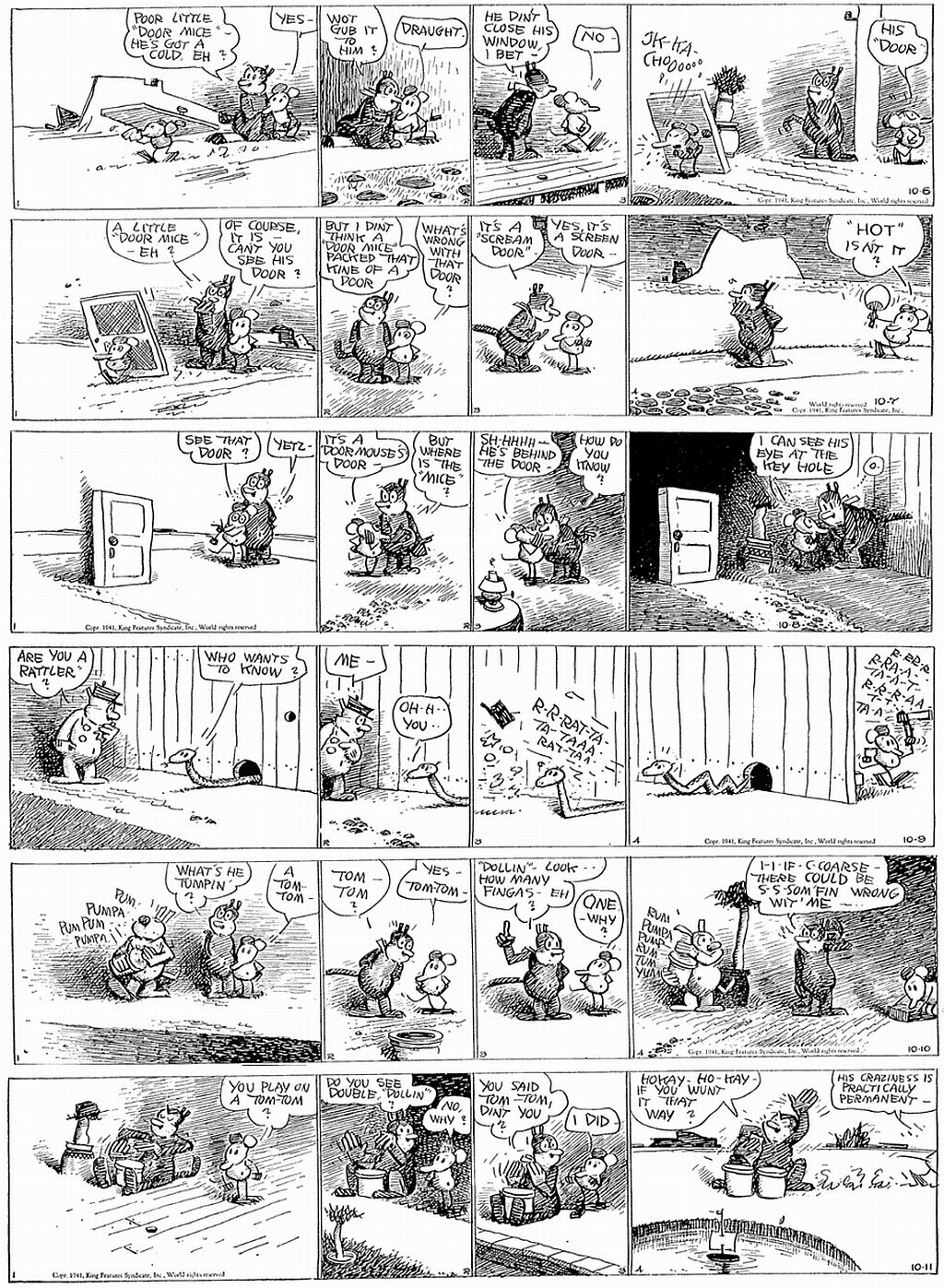  In Krazy this time, 10-6 to 10-11-1941, Garge trots out one of his favorite vehicles, the “Door-Mice”. He got a lot of mileage out of that basic pun, “Dormouse” and “Door-Mice”, and here he spins more gold out of that straw, to mix a metaphor. There is a visit from a Herriman rattle snake, then Krazy and Ignatz trade nonsequiters about a pair of Tom-Tom drums. Ignatz’s comment on Krazy in the 10-11 is so iconic: “His craziness is practically permanent”.Â
 In Krazy this time, 10-6 to 10-11-1941, Garge trots out one of his favorite vehicles, the “Door-Mice”. He got a lot of mileage out of that basic pun, “Dormouse” and “Door-Mice”, and here he spins more gold out of that straw, to mix a metaphor. There is a visit from a Herriman rattle snake, then Krazy and Ignatz trade nonsequiters about a pair of Tom-Tom drums. Ignatz’s comment on Krazy in the 10-11 is so iconic: “His craziness is practically permanent”.Â
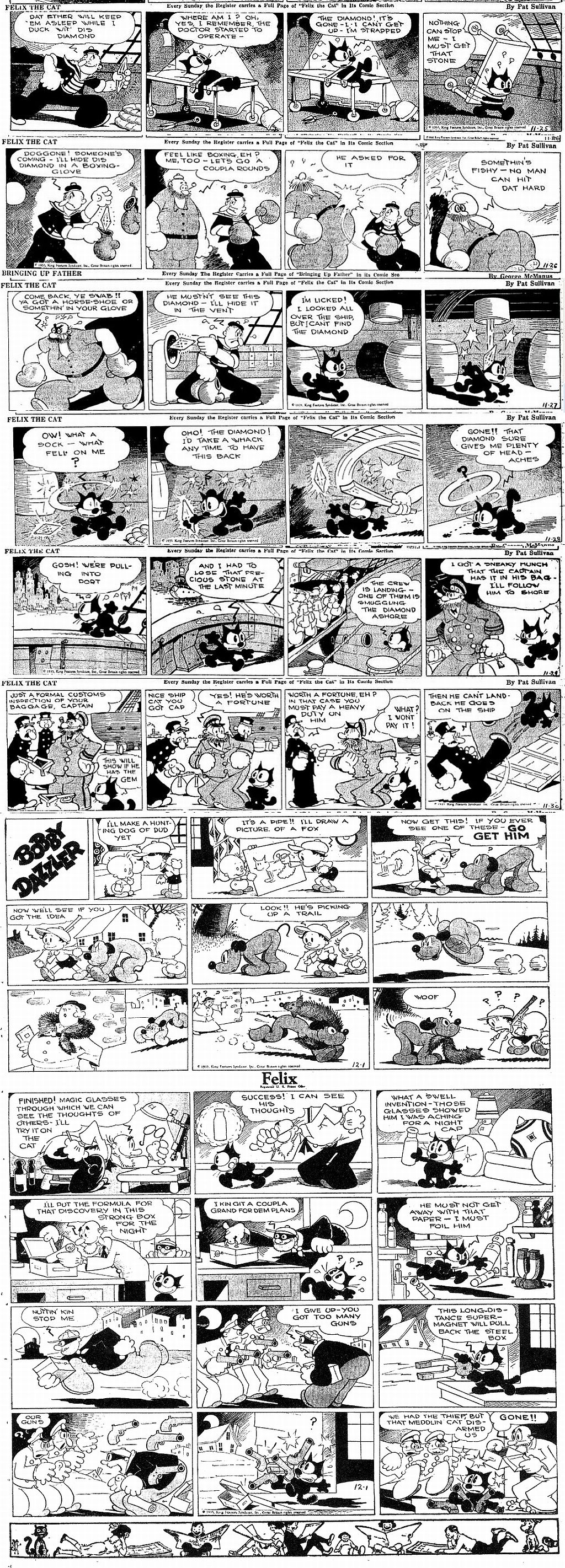 Â It’s “Felix Pathetique” this time, as Felix strikes out in both the daily continuity and Sunday page, from 11-15 to 12-1-1935. Felix is very nearly reunited with the precious diamond aboard the ape’s ship in the 11-17, but loses it again and isn’t even allowed to come ashore in the 11-30, because the Captain won’t pay duty on Felix. In the Sunday page, Felix tries to rescue the professor’s mind-reading formula from a burglar, but only succeeds in attracting the metal box it was stored in with a giant magnet. We’ll see if Felix redeems himself next time.
 It’s “Felix Pathetique” this time, as Felix strikes out in both the daily continuity and Sunday page, from 11-15 to 12-1-1935. Felix is very nearly reunited with the precious diamond aboard the ape’s ship in the 11-17, but loses it again and isn’t even allowed to come ashore in the 11-30, because the Captain won’t pay duty on Felix. In the Sunday page, Felix tries to rescue the professor’s mind-reading formula from a burglar, but only succeeds in attracting the metal box it was stored in with a giant magnet. We’ll see if Felix redeems himself next time.
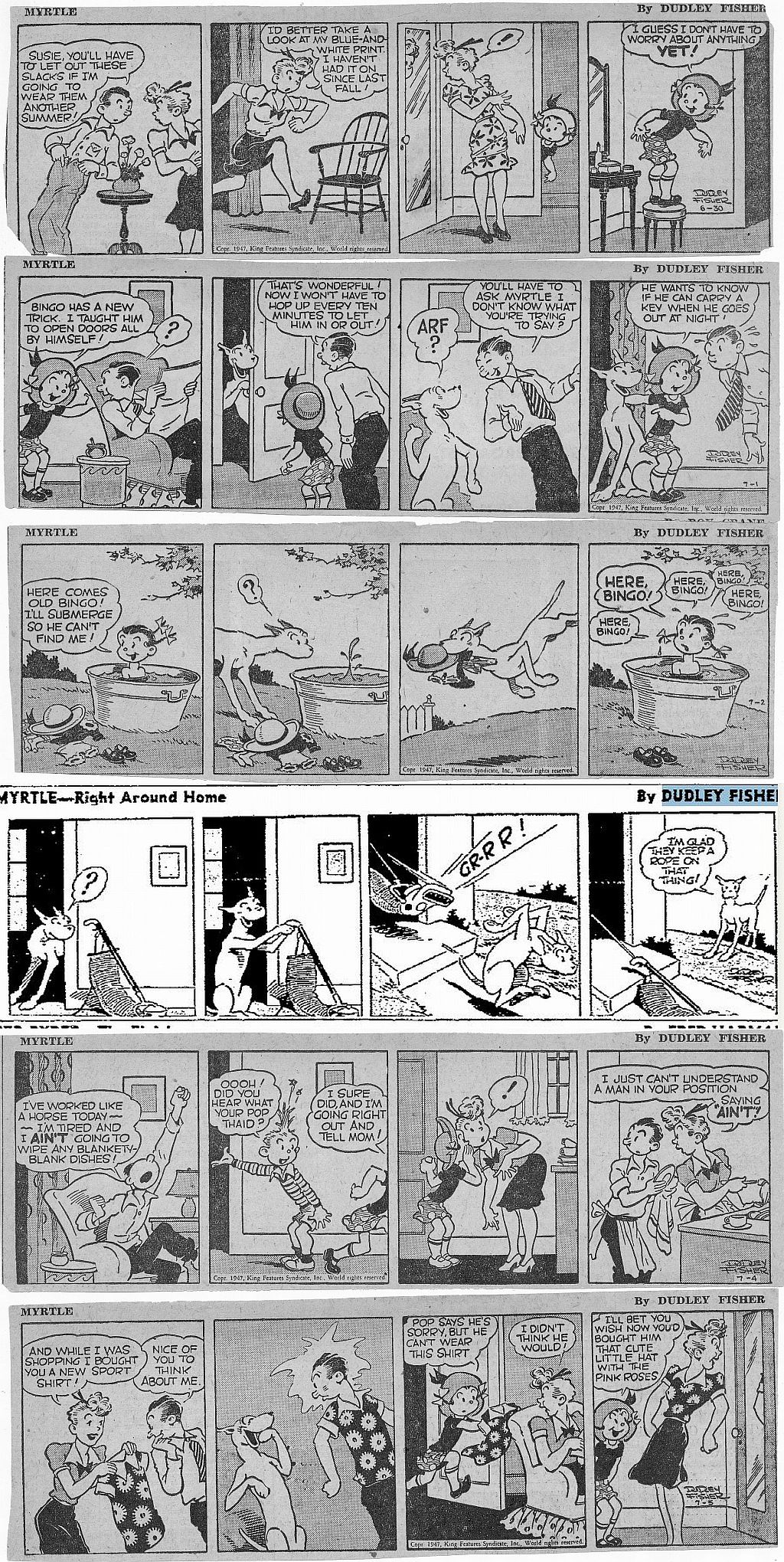 Â In Myrtle, from 6-30 to 7-5-1947, Myrtle is proud of her rear shape in the 6-30, Bingo steals her clothes while she is bathing in the 7-2, Freddie is punished for saying “Ain’t”, when he has actually used much sharper language in the 7-4, and Susie buys a rather “fem” shirt for Freddie, knowing full well that she will wind up with it in the 7-5.
 In Myrtle, from 6-30 to 7-5-1947, Myrtle is proud of her rear shape in the 6-30, Bingo steals her clothes while she is bathing in the 7-2, Freddie is punished for saying “Ain’t”, when he has actually used much sharper language in the 7-4, and Susie buys a rather “fem” shirt for Freddie, knowing full well that she will wind up with it in the 7-5.



  Beautiful art by Harvey Eisenberg on this month’s Yogi Sunday pages, from April, 1963. Just click the thumbnails to blow them up. The 4-14 has a funny twist, with Cupid shooting Boo-Boo instead of Yogi. Boob winds up with Cindy Bear! In the 4-21, check out what life was like before Xerox photocopiers were commonplace, as Mister Ranger dreams that Yogi falls into his duplicating machine, mimeograph no doubt! In the 4-28, Mister Ranger does a real “Tom and Jerry” take, as he pulls out the entire electrical wiring system from his cabin! Check out Yogi’s understated pose in the same panel, nice acting from the animated/comic strip bear. Check the link to Yowp’s page in the Blogroll list, he will probably be posting the half-page versions of these strips very soon. I’m having fun posting these comic pages, I’ll do another Junior Times, one of these days. C ya.
 Beautiful art by Harvey Eisenberg on this month’s Yogi Sunday pages, from April, 1963. Just click the thumbnails to blow them up. The 4-14 has a funny twist, with Cupid shooting Boo-Boo instead of Yogi. Boob winds up with Cindy Bear! In the 4-21, check out what life was like before Xerox photocopiers were commonplace, as Mister Ranger dreams that Yogi falls into his duplicating machine, mimeograph no doubt! In the 4-28, Mister Ranger does a real “Tom and Jerry” take, as he pulls out the entire electrical wiring system from his cabin! Check out Yogi’s understated pose in the same panel, nice acting from the animated/comic strip bear. Check the link to Yowp’s page in the Blogroll list, he will probably be posting the half-page versions of these strips very soon. I’m having fun posting these comic pages, I’ll do another Junior Times, one of these days. C ya.
Your Comics Page, Palm Sunday 2013
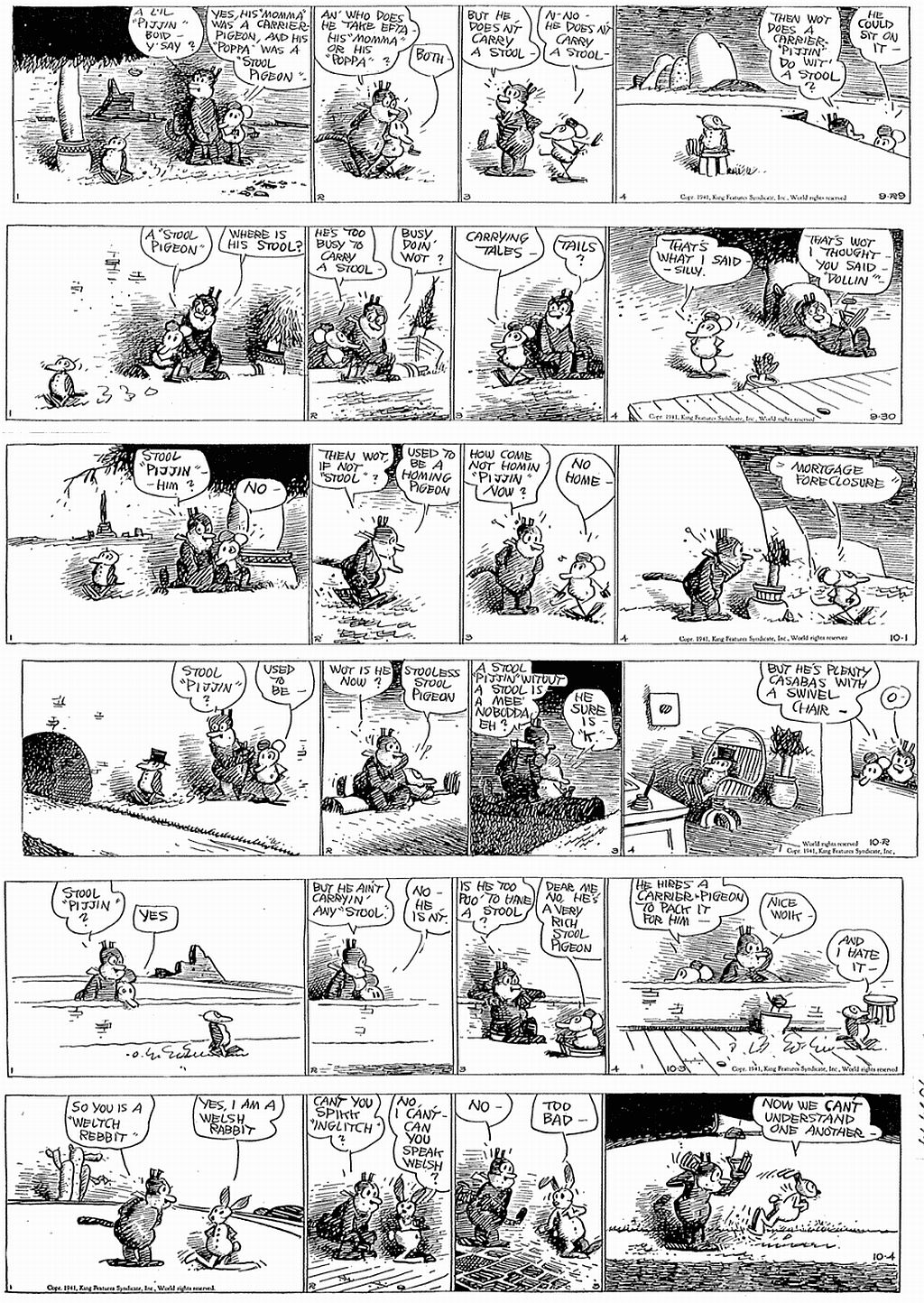 Â From 9-29 to 10-4-1941 comes Krazy Kat with a lot of pigeon jokes for the week. “Stool” pigeons, “Homin'” pigeons and Carrier pigeons have a hierarchy that Garge explores thoroughly, ending with a neat little “Welsh Rabbit” joke. Garge designed rabbits very well, this one could have been a recurring character, perhaps in tandem with a desert jackrabbit.
 From 9-29 to 10-4-1941 comes Krazy Kat with a lot of pigeon jokes for the week. “Stool” pigeons, “Homin'” pigeons and Carrier pigeons have a hierarchy that Garge explores thoroughly, ending with a neat little “Welsh Rabbit” joke. Garge designed rabbits very well, this one could have been a recurring character, perhaps in tandem with a desert jackrabbit.
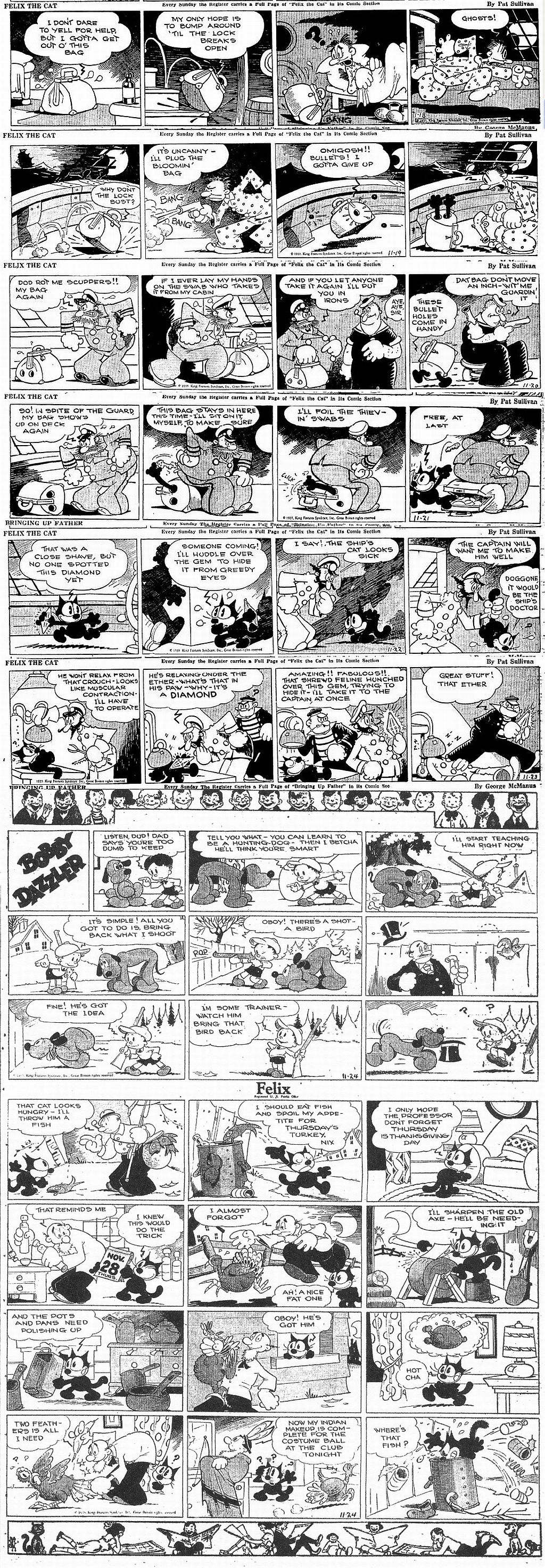 Felix is from 11-18 to 11-24-1935 this time out. He continues to elude the sailors by hiding in a bag, but is eventually flushed out and he surrenders his precious diamond under ether. Once again, he loses control of the peculiar oblong gem that propels the action into 1936. I love Felix’s crouched position in the 11-22 and 11-23 as he tries to hide the diamond by hunching up around it. He really looks pathetic. In the Sunday, Felix thinks he has a Thanksgiving Turkey dinner courtesy of the Professor, only to find that the Prof. just wants a turkey for two feathers to round out an Indian costume he’s making. Felix’s frustrated attitude in the last panel is quite funny as he searches for a fish dinner as he’s forced to trade L-Triptophan for Omega 3’s.
Felix is from 11-18 to 11-24-1935 this time out. He continues to elude the sailors by hiding in a bag, but is eventually flushed out and he surrenders his precious diamond under ether. Once again, he loses control of the peculiar oblong gem that propels the action into 1936. I love Felix’s crouched position in the 11-22 and 11-23 as he tries to hide the diamond by hunching up around it. He really looks pathetic. In the Sunday, Felix thinks he has a Thanksgiving Turkey dinner courtesy of the Professor, only to find that the Prof. just wants a turkey for two feathers to round out an Indian costume he’s making. Felix’s frustrated attitude in the last panel is quite funny as he searches for a fish dinner as he’s forced to trade L-Triptophan for Omega 3’s.
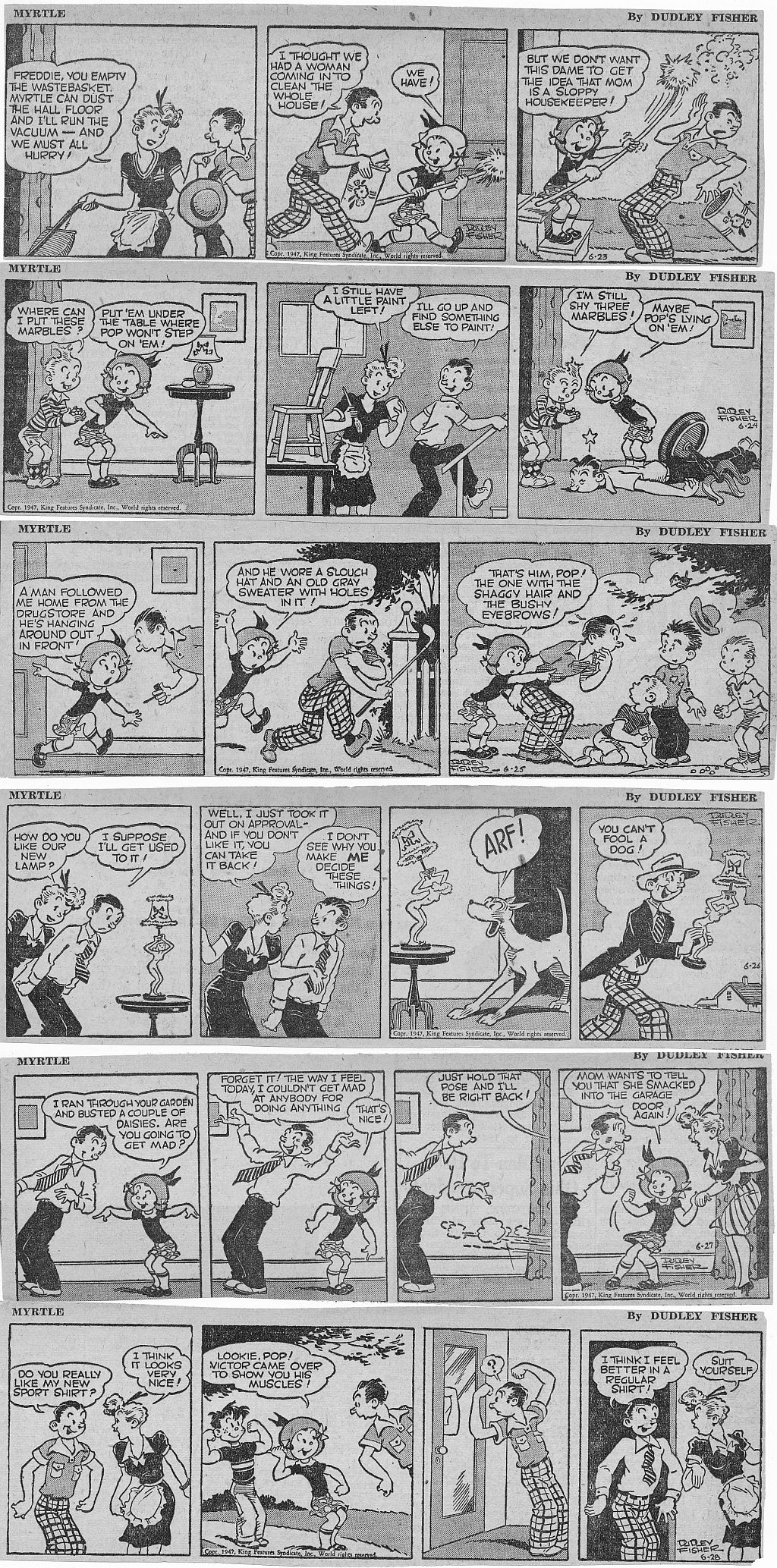  Myrtle is from 6-23 to 6-28-1947. Dudley Fisher continues to produce great looking dailies. Freddie wears a sports shirt three times during the week, but only in the Saturday, 6-28, strip does a real gag come out of his change in wardrobe. Victor, a neighborhood boy, looks better in the sports “muscle” shirt than does Freddie, so he goes back to his long sleeve dress shirt. I also like the 6-26, where Bingo shows his true opinion of Mom’s taste in lamps; “You can’t fool a dog!”
 Myrtle is from 6-23 to 6-28-1947. Dudley Fisher continues to produce great looking dailies. Freddie wears a sports shirt three times during the week, but only in the Saturday, 6-28, strip does a real gag come out of his change in wardrobe. Victor, a neighborhood boy, looks better in the sports “muscle” shirt than does Freddie, so he goes back to his long sleeve dress shirt. I also like the 6-26, where Bingo shows his true opinion of Mom’s taste in lamps; “You can’t fool a dog!”
   There’s a current class called “Blogging for Fun and Profit” offered over at the Glendale Community College right now. If it didn’t cost so much, I’d take it, simply to get ideas of how to “profit” from a Blog. I know all about the fun part. Have you visited Jerry Beck’s new and improved Cartoon Research blog? Here’s the link: http://cartoonresearch.com/. Jerry really works hard at his blog, posts every day, sometimes more than once. I like to put a post together every so often, but it’s hard to be dedicated to sitting in front of a screen for so many hours a day. See you soon.
Your Comics Page March 5th, 2013
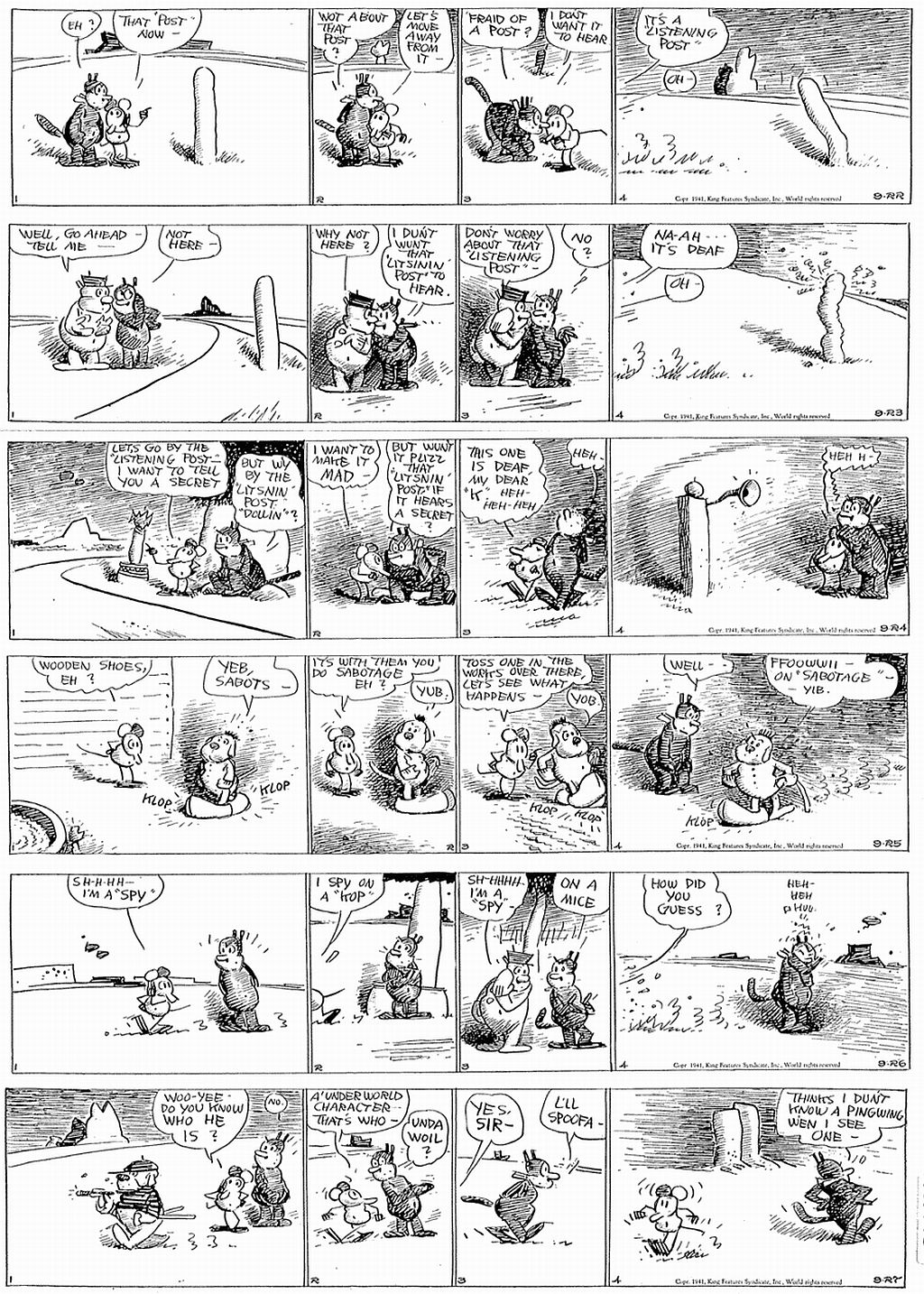  Our Kat this time is from 9-22 to 9-27-1941. Wartime consciousness begins to seep into Coconino County as there are three “listening post” gags, and a saboteur dog who wears wooden shoes, but calls them “sabots”. Is he from Holland or France? Ignatz and Pupp refer to themselves as “spies” in the 9-26, and in the 9-27, Krazy’s convoluted logic lets him believe that an “underworld character” is a “pingwing” (penguin).
 Our Kat this time is from 9-22 to 9-27-1941. Wartime consciousness begins to seep into Coconino County as there are three “listening post” gags, and a saboteur dog who wears wooden shoes, but calls them “sabots”. Is he from Holland or France? Ignatz and Pupp refer to themselves as “spies” in the 9-26, and in the 9-27, Krazy’s convoluted logic lets him believe that an “underworld character” is a “pingwing” (penguin).
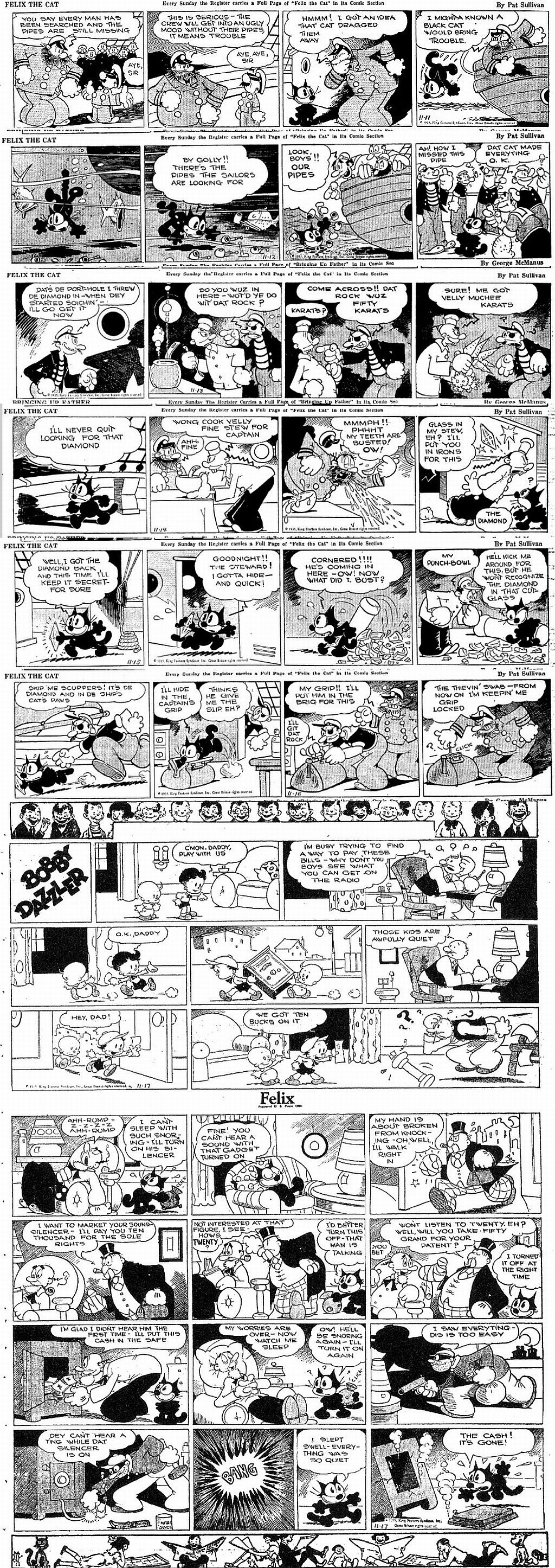  Felix is from 11-11 to 11-17-1935 and continues Felix’s adventures aboard Danny’s ship. He dives to the bottom of the sea to get the sailor’s pipes back to them, and the diamond becomes an ingredient in Wong’s stew. Felix hides in the Captain’s grip with the diamond, but the Captain locks him in. The “Silencer” machine continues to provide a continuing plot for the Sunday page. However, the Professor’s handy device makes robbing his safe a little TOO handy for a thief.
 Felix is from 11-11 to 11-17-1935 and continues Felix’s adventures aboard Danny’s ship. He dives to the bottom of the sea to get the sailor’s pipes back to them, and the diamond becomes an ingredient in Wong’s stew. Felix hides in the Captain’s grip with the diamond, but the Captain locks him in. The “Silencer” machine continues to provide a continuing plot for the Sunday page. However, the Professor’s handy device makes robbing his safe a little TOO handy for a thief.
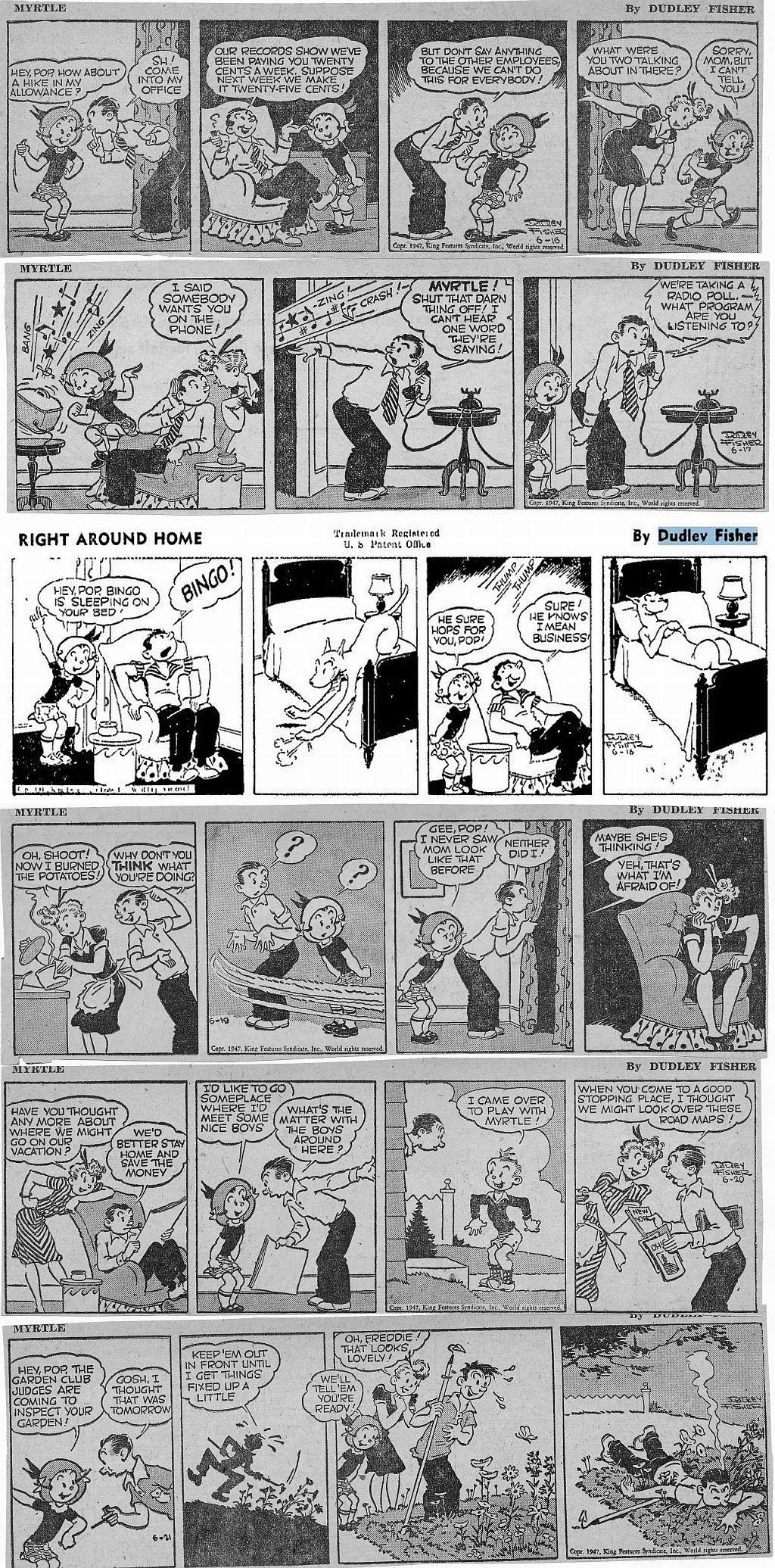 Â Myrtle is from 6-16 to 6-21-1947. I like the gag in the 6-18, as Bingo the dog fakes out Freddie, and the 6-20, as the timely appearance of Myrtle’s boyfriend Sampson at the front door, galvanizes a reluctant Freddie into making vacation plans to get away from the lisping little creep.
 Myrtle is from 6-16 to 6-21-1947. I like the gag in the 6-18, as Bingo the dog fakes out Freddie, and the 6-20, as the timely appearance of Myrtle’s boyfriend Sampson at the front door, galvanizes a reluctant Freddie into making vacation plans to get away from the lisping little creep.


 “Stop That Crazy Bear!” I’m gonna get ahead of that sly dog, Yowp, this time. Here are the 1/3rd page versions of the Yogi Bear Sundays from March, 1963. I like the long panel with all the props that get attached to Yogi in the 3-3. I’ll bet Yogi watched a trapdoor spider emerge from his underground home in the original top row of the 3-31, as he refers to the spider in the last panel. That’s nice use of color in the 3-31, too, as Yogi is a shade of Cerulean Blue and Yellow-Green in his underground lair. These all look like Eisenbergs to me. Keep checking with Yowp’s site in the Blogroll, as he’ll probably be posting the half-page versions of these strips any day now! Yuk-yuk!
“Stop That Crazy Bear!” I’m gonna get ahead of that sly dog, Yowp, this time. Here are the 1/3rd page versions of the Yogi Bear Sundays from March, 1963. I like the long panel with all the props that get attached to Yogi in the 3-3. I’ll bet Yogi watched a trapdoor spider emerge from his underground home in the original top row of the 3-31, as he refers to the spider in the last panel. That’s nice use of color in the 3-31, too, as Yogi is a shade of Cerulean Blue and Yellow-Green in his underground lair. These all look like Eisenbergs to me. Keep checking with Yowp’s site in the Blogroll, as he’ll probably be posting the half-page versions of these strips any day now! Yuk-yuk!
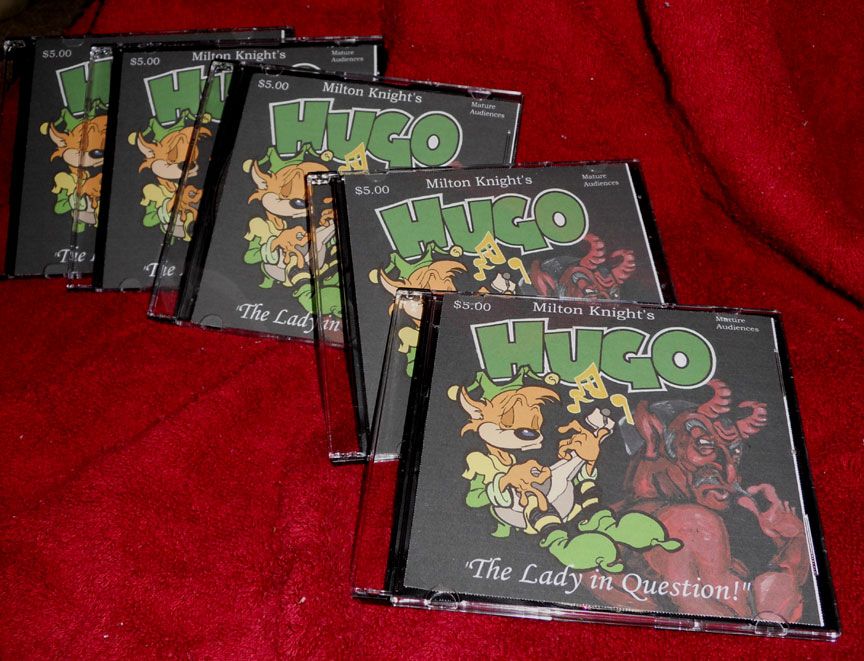 Â Here’s something else to click on the Blogroll for, Milton Knight’s “Hugo” in a brand-new story called “The Lady in Question”! This is the first Hugo comic not to be printed on paper, but burned into a CD-R disc. Get a preview at http://miltonknight.net/previews.html. You can probably order it through Milton’s website, which I directed you to visit a little earlier in this paragraph. No doubt it will contain Knight’s own unique blend of delicious dames and devils. It retails for a mere 5 bucks a copy. Tell him “Itza Cat” sent you!
 Here’s something else to click on the Blogroll for, Milton Knight’s “Hugo” in a brand-new story called “The Lady in Question”! This is the first Hugo comic not to be printed on paper, but burned into a CD-R disc. Get a preview at http://miltonknight.net/previews.html. You can probably order it through Milton’s website, which I directed you to visit a little earlier in this paragraph. No doubt it will contain Knight’s own unique blend of delicious dames and devils. It retails for a mere 5 bucks a copy. Tell him “Itza Cat” sent you!
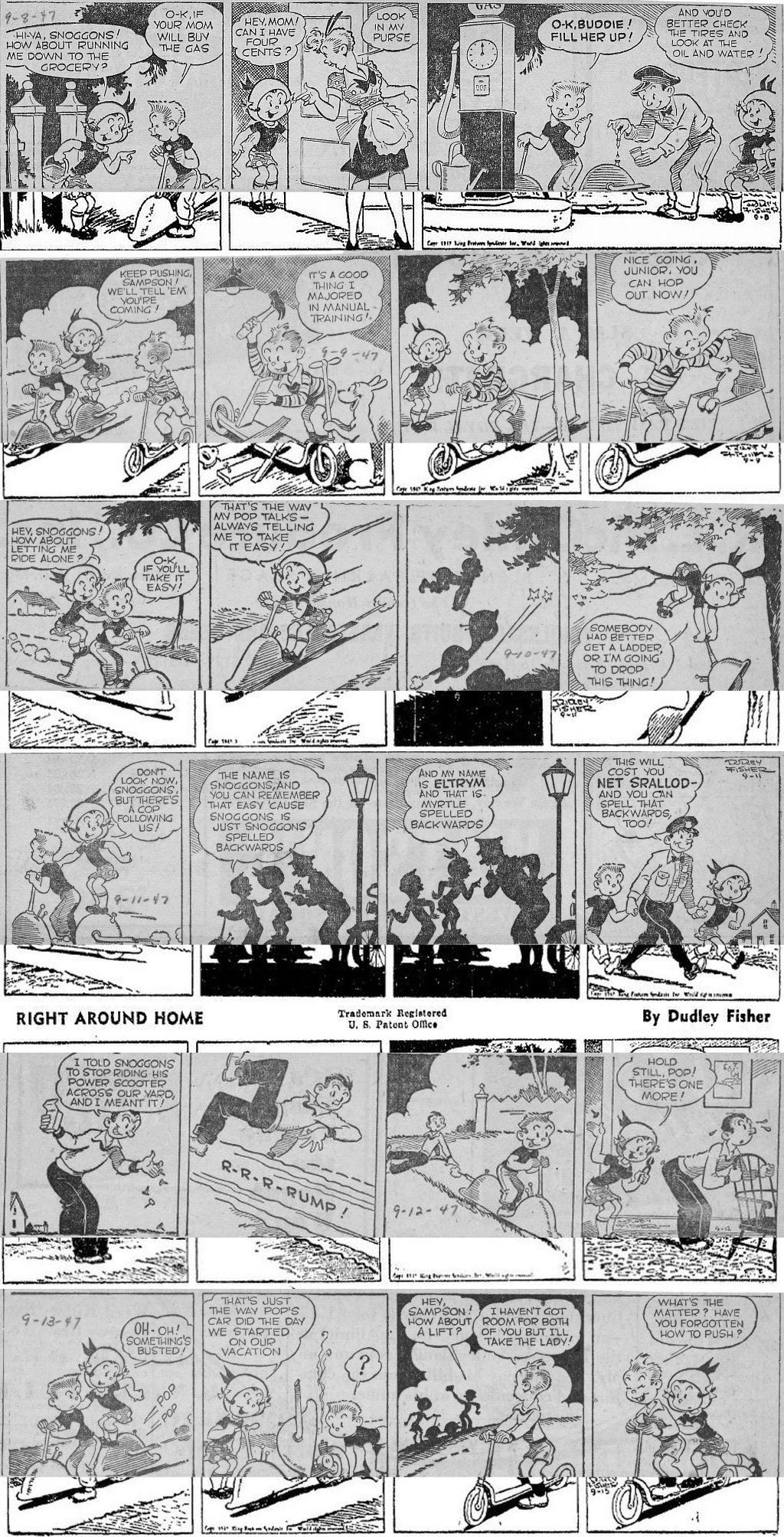
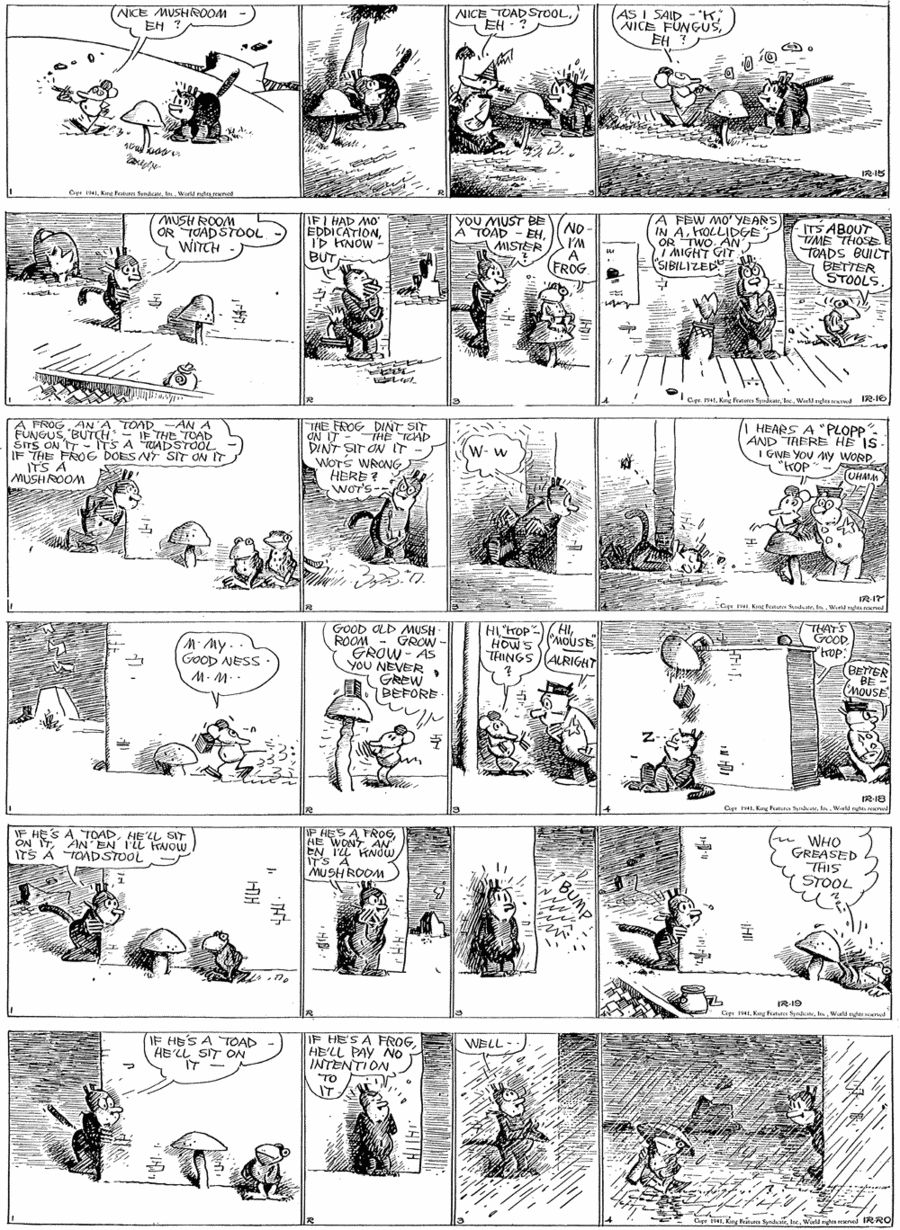
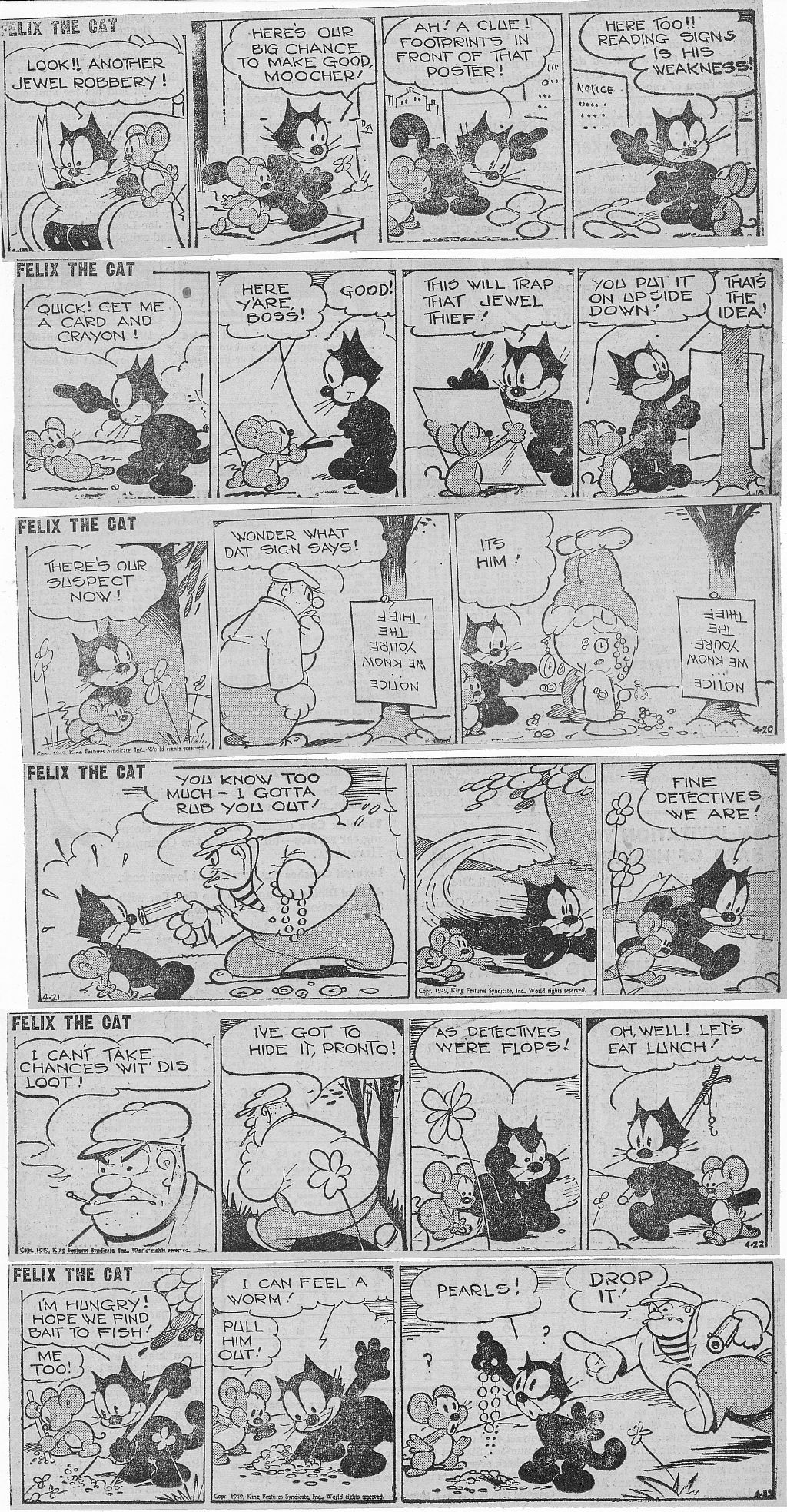

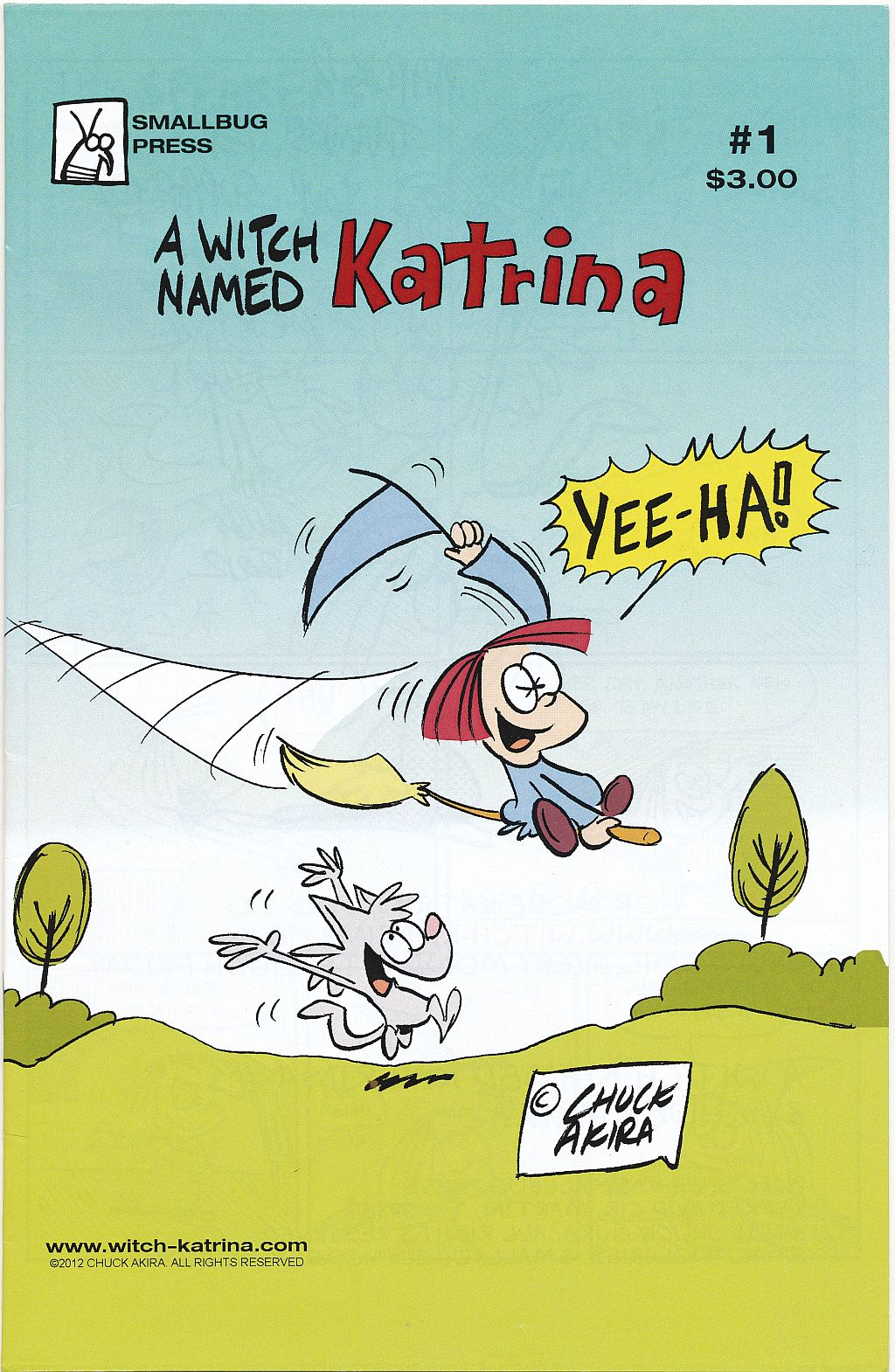
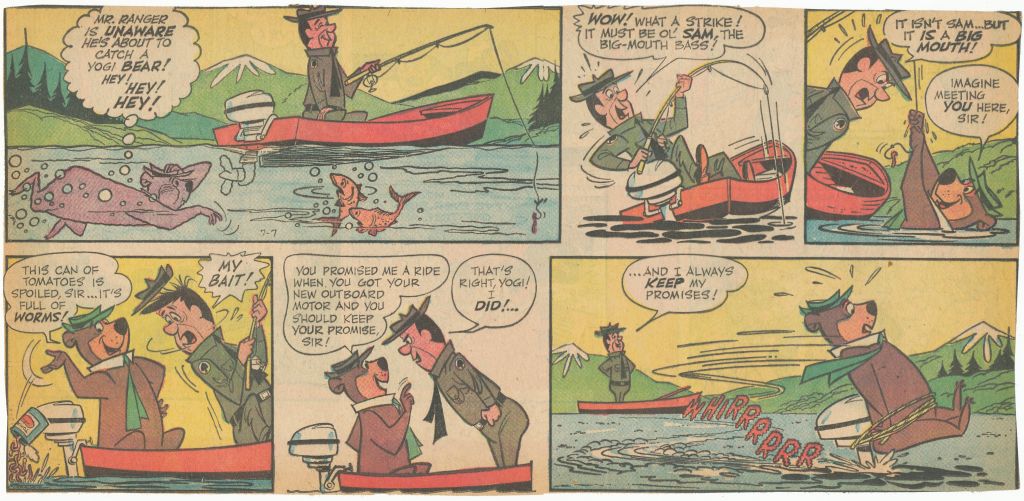
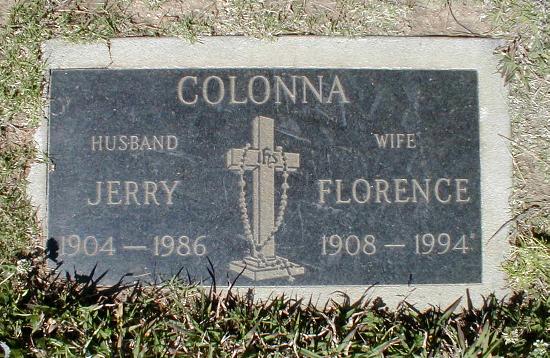
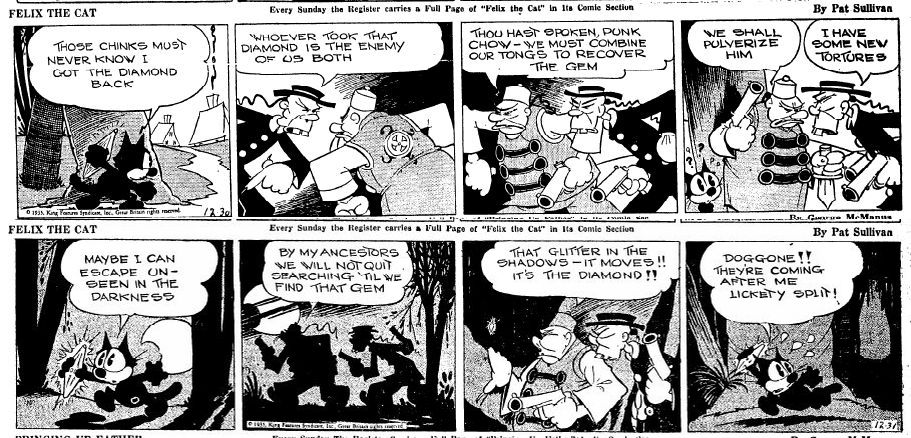
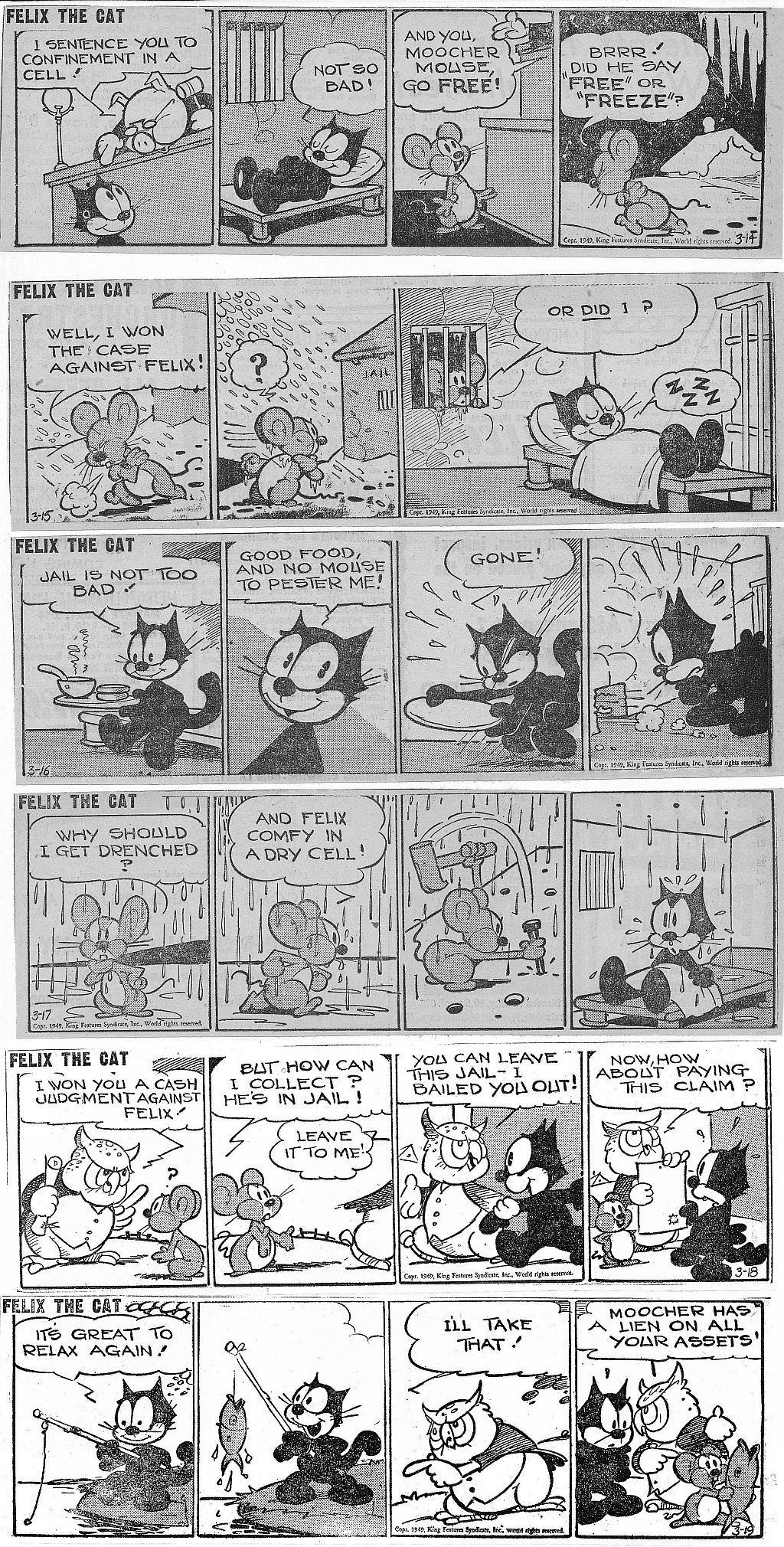
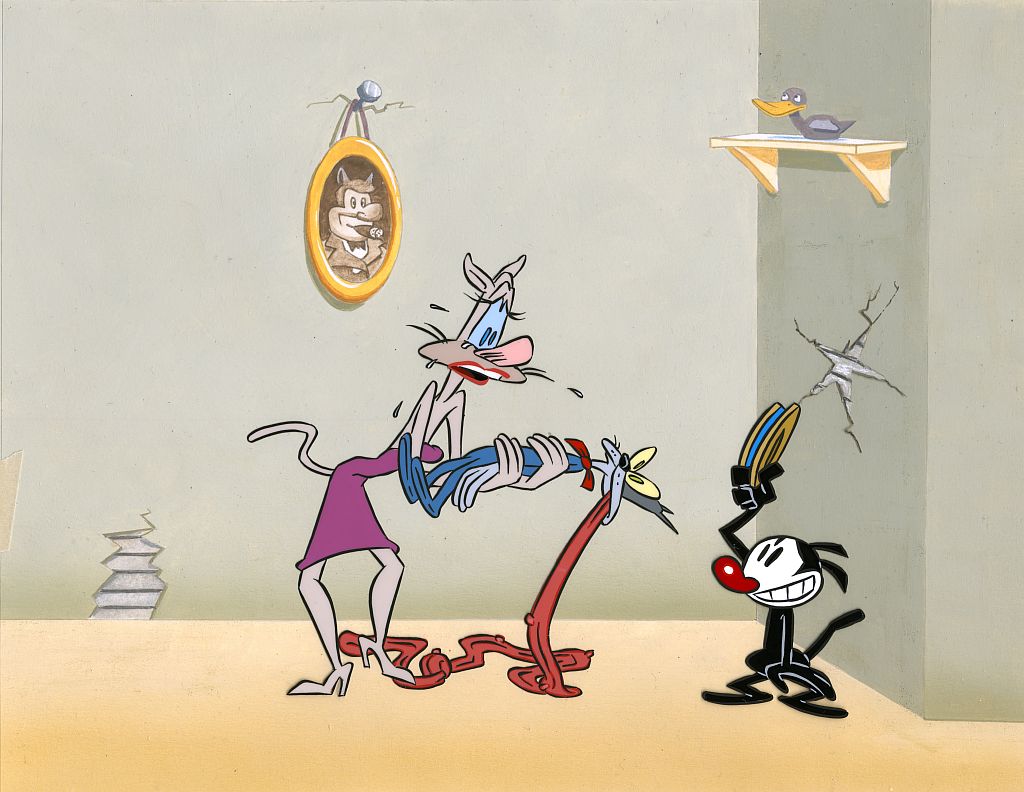
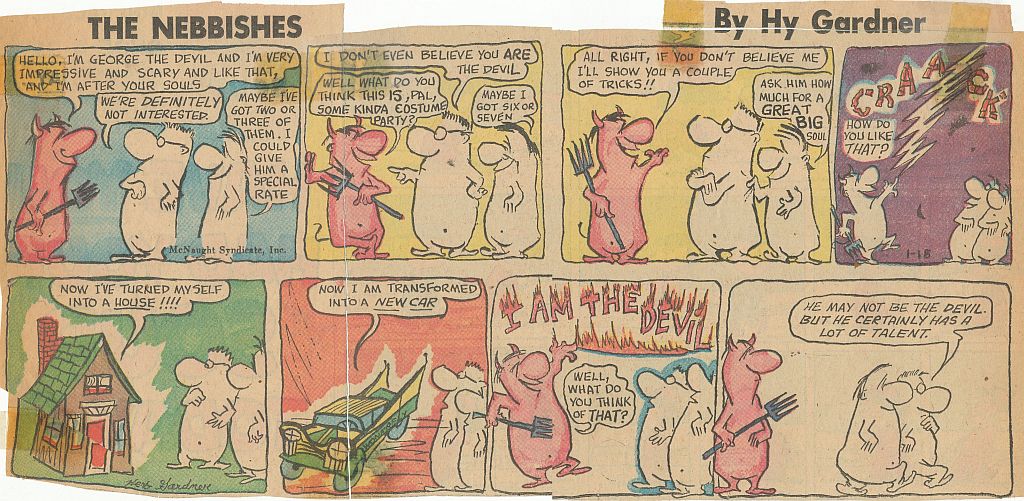
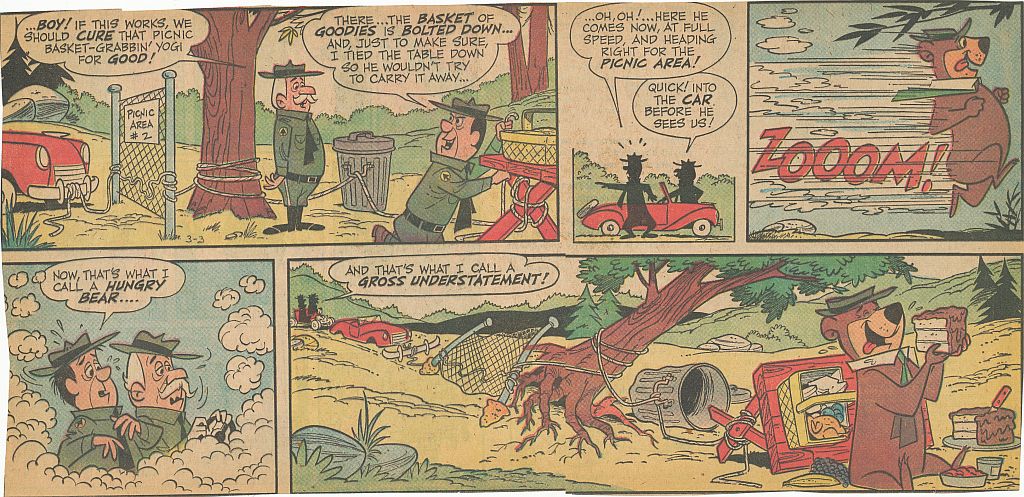

Count Down to September 9th!
September 5, 2013
Uncategorized
2 Comments
Mark
Friend of Itza Cat and Facebook moderator for his website, Charles Brubaker, is asking for your help. He’s making a cartoon short featuring his character, KoKo the Blue, a Junior-sized Witch. I’ve reviewed her comics here in past weeks, and now’s the time to show your support by contributing to Charles’s KickStarter campaign. Here’s the link to the KickStarter site: http://www.indiegogo.com/projects/koko-the-blue-animated-short-film/x/167841Â . This is an unusual cartoon, it will be inked and painted on cels, and shot in Super 16mm! Charles is really swimming against the digital tide, here, folks, so give Cel Animation a boost! Contribute today!